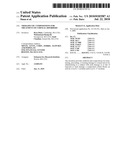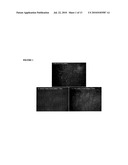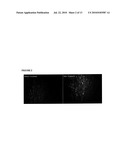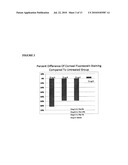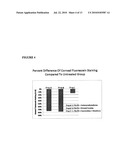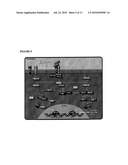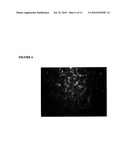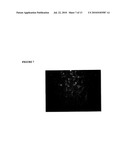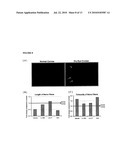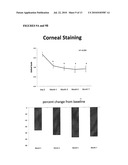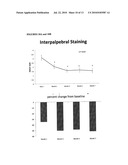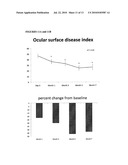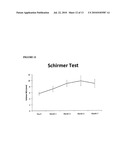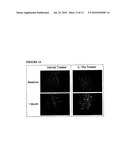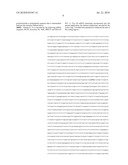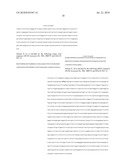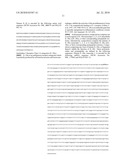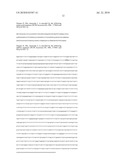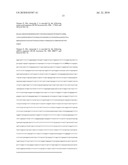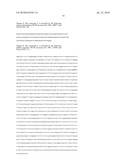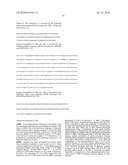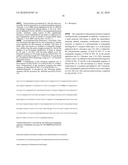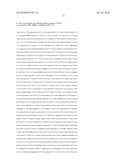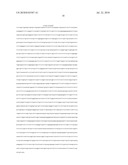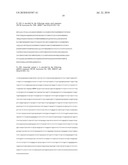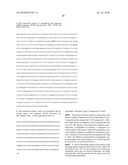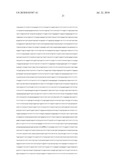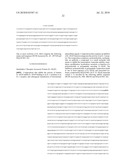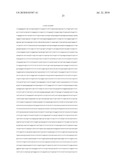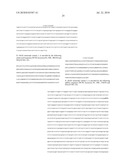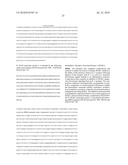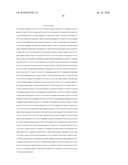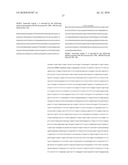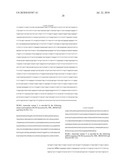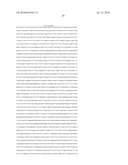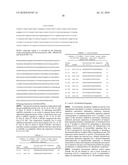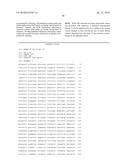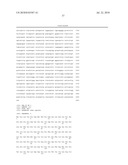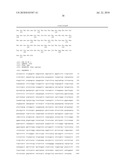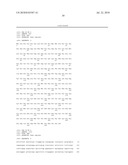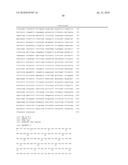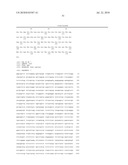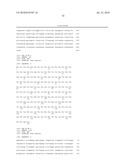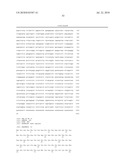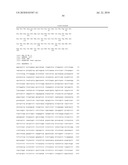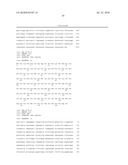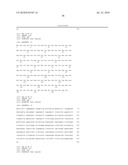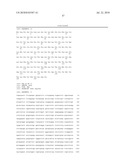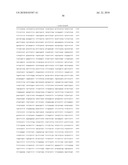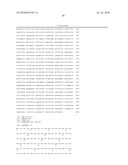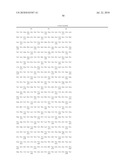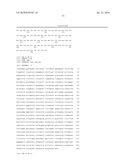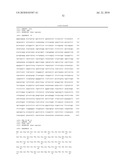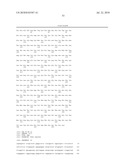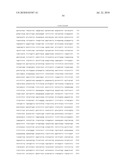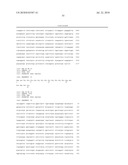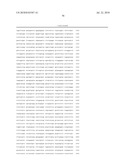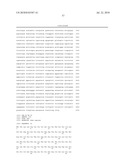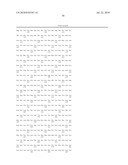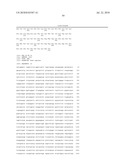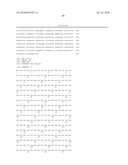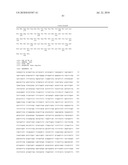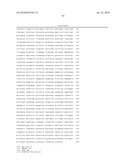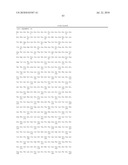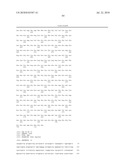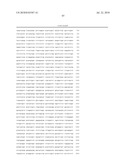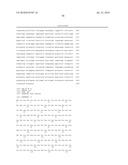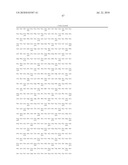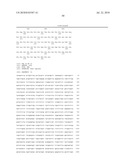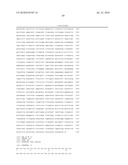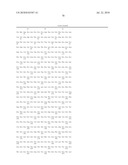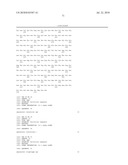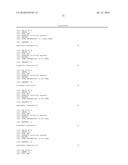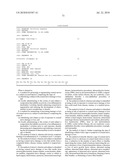Patent application title: Therapeutic Compositions for Treatment of Corneal Disorders
Inventors:
Reza Dana (Cambridge, MA, US)
Reza Dana (Cambridge, MA, US)
Mohammad Dastjerdi (Swampscott, MA, US)
Sunil Chauhan (Somerville, MA, US)
Assignees:
SCHEPENS EYE RESEARCH INSTITUTE
IPC8 Class: AA61K39395FI
USPC Class:
4241301
Class name: Drug, bio-affecting and body treating compositions immunoglobulin, antiserum, antibody, or antibody fragment, except conjugate or complex of the same with nonimmunoglobulin material
Publication date: 2010-07-22
Patent application number: 20100183587
Claims:
1. A method for protecting or regenerating corneal nerves in a subject in
need thereof, comprising the steps of:(a) identifying a subject with
corneal nerve damage or loss; and(b) locally administering to the cornea
of said subject a composition that inhibits an activity of an
inflammatory interleukin-1 cytokine, thereby enhancing corneal nerve
regeneration and reducing the development of abnormalities in nerve
morphology or density.
2. A method for minimizing or preventing damage or loss of corneal nerves in a subject in need thereof, comprising the steps of(a) identifying said subject at risk of exposure to corneal nerve damage or loss; and(b) locally administering to the cornea of said subject a composition that inhibits an activity of an inflammatory interleukin-1 cytokine prior to said exposure, thereby decreasing nerve degeneration and reducing or preventing the development of abnormalities in nerve morphology or density.
3. The method of claim 1, wherein said activity comprises binding of an inflammatory IL-1 cytokine to an IL-1 receptor.
4. The method of claim 1, wherein said subject is identified as having corneal nerve damage or loss that results from a congenital defect, disease, trauma, medical or surgical procedure.
5. The method of claim 1, wherein said subject is identified as having corneal nerve damage or loss that results from neurotrophic keratitis, herpes simplex, zoster keratitis, diabetes mellitus, trigeminal nerve damage, ocular or orbital or head surgery, head trauma, aneurysm, intracranial neurologic disease, keratorefractive procedures, photorefractive keratectomy (PRK), laser in situ keratomileusis (LASIK), congenital defect, ocular surface disease, dry eye syndrome, a non-ophthalmic disorder, a non-ophthalmic procedure, or peripheral neuropathy.
6. The method of claim 2, wherein said subject is identified as being at risk of exposure to corneal nerve damage or loss that could result from disease, trauma, or a medical procedure.
7. The method of claim 2, wherein said subject is identified as being at risk of exposure to corneal nerve damage or loss that could result from neurotrophic keratitis, herpes simplex, zoster keratitis, diabetes mellitus, trigeminal nerve damage, orbital or head surgery, head trauma, aneurysm, intracranial neurologic disease, keratorefractive procedures, photorefractive keratectomy (PRK), laser in situ keratomileusis (LASIK), ocular surface disease, dry eye syndrome, a non-ophthalmic disorder, a non-ophthalmic procedure, or peripheral neuropathy.
8. The method of claim 1, further comprising the step of identifying a subject with a sign or symptom of corneal nerve damage or loss.
9. The method of claim 8, wherein a sign of corneal nerve damage or loss is a decrease of corneal innervation or sensation, a reduction in the number of nerve fibers or bundles innervating the cornea, death of neurons innervating the cornea, a decrease or loss of neurotransmitter release, a decrease or loss of nerve growth factor release, abnormal tearing reflexes, abnormal blink reflexes, abnormal nerve morphology, appearance of abnormal nerve sprouts, abnormal tortuosity, increased bead-like nerve formations, thinning of nerve fiber bundles, or thickening of nerve fiber bundles.
10. The method of claim 8, wherein a symptom of corneal nerve damage or loss is abnormal tear production or dryness, abnormal blinking, and difficulty or loss of ability to focus, decreased or lost visual acuity, or decreased or lost corneal sensitivity.
11. The method of claim 3, wherein said composition that inhibits binding of an inflammatory IL-1 cytokine to an IL-1 receptor comprises an amino acid sequence of SEQ ID NO: 15 or SEQ ID NO: 16.
12. The method of claim 1, wherein said composition is present in a concentration of 0.1-10% (mg/ml).
13. The method of claim 1, wherein said composition is present in a concentration of 2.5% (mg/ml) or 5% (mg/ml).
14. The method of claim 1, wherein the form of said composition is a solid, a paste, an ointment, a gel, a liquid, an aerosol, a mist, a polymer, a film, an emulsion, or a suspension.
15. The method of claim 1, wherein said composition is administered topically.
16. The method of claim 1, wherein said method does not comprise systemic administration or substantial dissemination to non-ocular tissue.
17. The method of claim 1, wherein said composition further comprises a compound selected from the group consisting of a physiological acceptable salt, poloxamer analogs with carbopol, carbopol/HPMC, carbopol-methyl cellulose, a mucolytic agent, carboxymethylcellulose (CMC), hyaluronic acid, cyclodextrin, and petroleum.
18. The method of claim 17, wherein said mucolytic agent is N-acetyl cysteine.
19. The method of claim 1, wherein said composition further comprises carboxymethylcellulose (CMC).
20. The method of claim 1, wherein said composition inhibits the transcription, transcript stability, translation, modification, localization, secretion, or function of a polynucleotide or polypeptide encoding an inflammatory interleukin-1 cytokine or an IL-1 receptor.
21. The method of claim 1, wherein said composition comprises a polynucleotide, a polypeptide, an antibody, or a small molecule.
22. The method of claim 1, wherein said composition comprises a morpholino antisense oligonucleotide, microRNA (miRNA), short hairpin RNA (shRNA), or short interfering RNA (siRNA).
23. A method for reducing corneal lymphangiogenesis in a subject in need thereof, comprising the steps of:(a) identifying a subject with corneal lymphangiogenesis; and(b) locally administering to the cornea of said subject a composition that inhibits an activity of an inflammatory interleukin-1 cytokine, thereby inhibiting the ability of lymphatic vessels to expand within or invade corneal tissue and reducing corneal lymphangiogenesis.
24. A method for minimizing or preventing corneal lymphangiogenesis in a subject in need thereof, comprising the steps of:(a) identifying said subject at risk of developing lymphangiogenesis onset; and(b) locally administering to the cornea of said subject a composition that inhibits an activity of an inflammatory interleukin-1 cytokine prior to said development, thereby inhibiting the ability of lymphatic vessels to form or expand within, or to invade corneal tissue.
25. A method for reducing the induction of immunity in a cornea of a subject in need thereof, comprising the steps of:(a) identifying a subject with said induction of immunity; and(b) locally administering to the cornea of said subject a composition that inhibits an activity of an inflammatory interleukin-1 cytokine, thereby inhibiting the ability of lymphatic vessels to expand within or to invade corneal tissue and reducing the induction of immunity, wherein said lymphatic vessels permit the transport of immune cells between said corneal tissue and lymphoid tissues and the initiation of an immune response.
26. A method for minimizing or preventing induction of immunity in a cornea of a subject in need thereof, comprising the steps of:(a) identifying said subject at risk of developing said immunity; and(b) locally administering to the cornea of said subject a composition that inhibits an activity of an inflammatory interleukin-1 cytokine prior to said development, thereby inhibiting the ability of lymphatic vessels to expand within or to invade corneal tissue and minimizing or preventing said induction of immunity, wherein said lymphatic vessels permit the transport of immune cells between said corneal tissue and lymph nodes and the initiation of an immune response.
27. A method for reducing an autoimmune condition affecting a corneal tissue of a subject in need thereof, comprising the steps of:(a) identifying a subject with said autoimmune condition; and(b) locally administering to the cornea of said subject a composition that inhibits an activity of an inflammatory interleukin-1 cytokine, thereby inhibiting the ability of lymphatic vessels to expand within or to invade corneal tissue and reducing said autoimmune condition, wherein said lymphatic vessels permit the transport of immune cells between said corneal tissue and lymph nodes and the initiation of an immune response.
28. A method for minimizing or preventing the development of an autoimmune condition affecting a corneal tissue of a subject in need thereof, comprising the steps of(a) identifying said subject at risk of developing said autoimmune condition; and(b) locally administering to the cornea of said subject a composition that inhibits an activity of an inflammatory interleukin-1 cytokine prior to said development, thereby inhibiting the ability of lymphatic vessels to expand within or to invade corneal tissue and minimizing or preventing the development of said autoimmune condition, wherein said lymphatic vessels permit the transport of immune cells between said corneal tissue and lymph nodes and the initiation of an immune response.
29. The method of claims 23, wherein said subject has a dry-eye associated ocular surface disease.
30. The method of claims 24, wherein said subject is at risk of developing a dry-eye associated ocular surface disease.
31. The method of any one of claims 23, wherein said activity comprises binding of an inflammatory IL-1 cytokine to an IL-1 receptor.
32. The method of any one of claims 1, further comprising locally administering an antagonist of interleukin-17 or a receptor thereof.
33. A method for protecting or regenerating corneal nerves in a subject in need thereof, comprising the steps of:(a) identifying a subject with corneal nerve damage or loss; and(b) locally administering to the cornea of said subject a composition that inhibits an activity of an inflammatory interleukin-1 cytokine and a composition that inhibits an activity of an inflammatory interleukin-17 cytokine, thereby enhancing corneal nerve regeneration and reducing the development of abnormalities in nerve morphology or density.
Description:
RELATED APPLICATIONS
[0001]This application claims the benefit of U.S. Ser. No. 61/143,561, filed Jan. 9, 2009, the contents of which are incorporated by reference herein in their entirety.
FIELD OF THE INVENTION
[0002]This invention relates generally to the field of ophthalmology.
BACKGROUND OF THE INVENTION
[0003]Corneal epithelial damage can lead to chronic ocular surface disease. The mechanisms by which this occurs have not been elucidated, making the development of treatments that address the cause rather than the symptoms of chronic ocular surface disease difficult, if not impossible. As such, there has been a long-felt need in the art for the discovery of these mechanisms and for the development of compositions and methods of treatment.
SUMMARY OF THE INVENTION
[0004]The invention is based on the surprising discovery that IL-1 inhibition leads to corneal nerve regeneration. Moreover, the invention provides compositions and methods for treating neurotrophic dry eye disease by reducing damage to and regenerating corneal nerves. Nerve damage and increased immune activity within the cornea complete a vicious cycle of events, along with corneal epithelial damage, that would perpetuate itself and lead to chronic ocular surface disorders, but for the intervention of the treatments described herein. Neurotrophic dry eye (a neuropathic condition) is distinguished from other types of dry eye by a reduction or loss of corneal nerve tissue. For example, neurotrophic dry eye is characterized by a reduction or loss of at least about 10%, 25%, 50%, 75%, or more of corneal nerve tissue or corneal nerve fiber length compared to a normal condition.
[0005]The invention provides a method for protecting or treating corneal nerves in a subject in need thereof, including the steps of: (a) identifying a subject with corneal nerve damage or loss; and (b) locally administering to the cornea of the subject a composition that inhibits an activity V1 all inflammatory cytokine (e.g., IL-1 or a combination of IL-1 and IL-17), thereby enhancing corneal nerve regeneration and reducing the development of abnormalities in nerve morphology or density. Preferably, the subject has not been diagnosed as having meibomian gland dysfunction (MGD), e.g., posterior blepharitis.
[0006]In one aspect of the above method, the subject is identified as having corneal nerve damage or loss that results from a congenital defect, disease, trauma, medical or surgical procedure. In another aspect of the above method, the subject is identified as having corneal nerve damage or loss that results from neurotrophic keratitis, herpes simplex, zoster keratitis, diabetes mellitus, trigeminal nerve damage, orbital or head surgery, head trauma, aneurysm, intracranial neurologic disease, keratorefractive procedures, photorefractive keratectomy (PRK), laser in situ keratomileusis (LASIK), congenital defect, ocular surface disease, dry eye syndrome, a non-ophthalmic disorder, a non-ophthalmic procedure, peripheral neuropathy, or diabetic neuropathy.
[0007]The invention further provides a method for minimizing or preventing damage or loss of corneal nerves in a subject in need thereof, including the steps of: (a) identifying the subject at risk of developing corneal nerve damage or loss; and (b) locally administering to the cornea of the subject a composition that inhibits an activity of an inflammatory interleukin-1 or interleukin-17 cytokine prior to development of nerve damage or loss, thereby decreasing nerve degeneration and reducing or preventing the development of abnormalities in nerve morphology or density.
[0008]In one aspect of the above method, the subject is identified as being at risk of exposure to corneal nerve damage or loss that could result from disease, trauma, or a medical procedure. In another aspect of the above method, the subject is identified as being at risk of exposure to corneal nerve damage or loss that could result from neurotrophic keratitis, herpes simplex keratitis, herpes zoster keratitis, diabetes mellitus, trigeminal nerve damage, orbital or head surgery, head trauma, aneurysm, intracranial neurologic disease, keratorefractive procedures, photorefractive keratectomy (PRK), laser in situ keratomileusis (LASIK), ocular surface disease, dry eye syndrome, a non-ophthalmic disorder, a non-ophthalmic procedure, peripheral neuropathy, or diabetic neuropathy.
[0009]In certain embodiments, the above methods further include the step of identifying a subject with a sign or symptom of corneal nerve damage or loss. For example, a sign of corneal nerve damage or loss is a decrease of corneal innervation or sensation, a reduction in the number of nerve fibers or bundles innervating the cornea, death of neurons innervating the cornea, a decrease or loss of neurotransmitter release, a decrease or loss of nerve growth factor release, abnormal tearing reflexes, abnormal blink reflexes, abnormal nerve morphology, appearance of abnormal nerve sprouts, abnormal tortuosity, increased bead-like nerve formations, thinning of nerve fiber bundles, or thickening of nerve fiber bundles. For example, a symptom of corneal nerve damage or loss is abnormal tear production or dryness, abnormal blinking, and difficulty or loss of ability to focus, decreased or lost visual acuity, or decreased or lost corneal sensitivity. In one aspect of the above methods, the activity includes binding of an inflammatory IL-1 cytokine to an IL-1 receptor. Compositions of the above methods that inhibit binding of an inflammatory IL-1 cytokine to an IL-1 receptor include an amino acid sequence of SEQ ID NO: 15 or SEQ ID NO: 16. Compositions optionally include inhibitors of IL-17 activity, e.g., compounds that inhibit IL-17 binding to its receptor, or compounds that inhibit cytokines critical for generation of T helper-17/IL-17 response, such as inhibitors of IL-6 or inhibitors of IL-23. Preferably, the compositions do not include generic, broad spectrum immunosuppressive agents, such as cyclosporine A (CsA), as such non-specific suppressors of inflammation do not regenerate corneal nerves.
[0010]In each of the methods described herein, the composition is present in a concentration of 0.1-10% (weight/volume or w/v). Alternatively, the composition is present in a concentration of 1.0% (mg/ml), 1.5% (mg/ml), 2.0% (mg/ml), 2.5% (mg/ml), 3.0% (mg/ml), 3.5% (mg/ml), 4.0% (mg/ml), 4.5% (mg/ml), 5.0% (mg/ml), 5.5% (mg/ml), 6.0% (mg/ml), 6.5% (mg/ml), 7.0% (mg/ml), 7.5% (mg/ml), 8.0% (mg/ml), 8.5% (mg/ml), 9.0% (mg/ml), 9.5% (mg/ml), 10.0% (mg/ml), or any percentage point in between. In a preferred embodiment, the composition is present in a concentration of 2.5% (mg/ml) or 5% (mg/ml). For example, the composition is present in a concentration of 25 mg/ml or 50 mg/ml. Exemplary formulations contain an inhibitory composition present in a concentration of 2.5% (25 mg/ml) or 5% (50 mg/ml).
[0011]The form of a composition of the above methods is a solid, a paste, an ointment, a gel, a liquid, an aerosol, a mist, a polymer, a film, an emulsion, or a suspension. The composition is administered topically. In a preferred embodiment, the above methods do not include systemic administration or substantial dissemination to non-ocular tissue. In certain embodiments of the above methods, the composition further includes a compound selected from the group consisting of a physiological acceptable salt, poloxamer analogs with carbopol, carbopol/HPMC, carbopol-methyl cellulose, a mucolytic agent, carboxymethylcellulose (CMC), hyaluronic acid, cyclodextrin, and petroleum. An exemplary mucolytic agent is N-acetyl cysteine. In a preferred embodiment, the composition further includes carboxymethylcellulose (CMC).
[0012]Compositions of the above methods inhibit the transcription, transcript stability, translation, modification, localization, secretion, or function of a polynucleotide or polypeptide encoding an inflammatory interleukin-1 cytokine or an IL-1 receptor. In certain embodiments, a composition of the above methods includes a polynucleotide, a polypeptide, an antibody, or a small molecule. Alternatively, or in addition, a composition of the above methods includes a morpholino antisense oligonucleotide, microRNA (miRNA), short hairpin RNA (shRNA), or short interfering RNA (siRNA).
[0013]The invention provides a method for reducing or treating corneal lymphangiogenesis in a subject in need thereof, including the steps of: (a) identifying a subject with corneal lymphangiogenesis; and (b) locally administering to the cornea of the subject a composition that inhibits an activity of an inflammatory interleukin-1 cytokine, thereby inhibiting the ability of lymphatic vessels to expand within or invade corneal tissue and reducing or treating corneal lymphangiogenesis.
[0014]The invention provides a method for minimizing or preventing corneal lymphangiogenesis in a subject in need thereof, including the steps of: (a) identifying a subject at risk of developing lymphangiogenesis onset; and (b) locally administering to the cornea of the subject a composition that inhibits an activity of an inflammatory interleukin-1 cytokine prior to the development, thereby inhibiting the ability of lymphatic vessels to form or expand within, or to invade corneal tissue and minimizing or preventing corneal lymphangiogenesis.
[0015]The invention provides a method for reducing or treating the induction of immunity in a cornea of a subject in need thereof, including the steps of: (a) identifying a subject with an induction of immunity; and (b) locally administering to the cornea of the subject a composition that inhibits an activity of an inflammatory interleukin-1 cytokine, thereby inhibiting the ability of lymphatic vessels to expand within or to invade corneal tissue and reducing or treating the induction of immunity, wherein the lymphatic vessels permit the transport of immune cells between the corneal tissue and lymph nodes and the initiation of an immune response.
[0016]The invention provides a method for minimizing or preventing induction of immunity in a cornea of a subject in need thereof, including the steps of: (a) identifying the subject at risk of developing an immunity; and (b) locally administering to the cornea of the subject a composition that inhibits an activity of an inflammatory interleukin-1 cytokine prior to the development, thereby inhibiting the ability of lymphatic vessels to expand within or to invade corneal tissue and minimizing or preventing induction of immunity, wherein the lymphatic vessels permit the transport of immune cells between the corneal tissue and lymph nodes and the initiation of an immune response.
[0017]The invention provides a method for reducing or treating an autoimmune condition affecting a corneal tissue of a subject in need thereof, including the steps of: (a) identifying a subject with the autoimmune condition; and (b) locally administering to the cornea of the subject a composition that inhibits an activity of an inflammatory interleukin-1 cytokine, thereby inhibiting the ability of lymphatic vessels to expand within or to invade corneal tissue and reducing or treating the autoimmune condition, wherein the lymphatic vessels permit the transport of immune cells between the corneal tissue and lymph nodes and the initiation of an immune response.
[0018]The invention provides a method for minimizing or preventing the development of an autoimmune condition affecting a corneal tissue of a subject in need thereof, including the steps of: (a) identifying a subject at risk of developing said autoimmune condition; and (b) locally administering to the cornea of the subject a composition that inhibits an activity of an inflammatory interleukin-1 cytokine prior to the development, thereby inhibiting the ability of lymphatic vessels to expand within or to invade corneal tissue and minimizing or preventing the development of the autoimmune condition, wherein the lymphatic vessels permit the transport of immune cells between said corneal tissue and lymph nodes and the initiation of an immune response.
[0019]In certain embodiments of the above methods, the subject has a dry-eye associated ocular surface disease. Alternatively, or in addition, the subject is at risk of developing a dry-eye associated ocular surface disease.
[0020]The ability of lymphatic vessels to expand within or to invade corneal tissue encompasses the potential or actual growth, expansion, elaboration, splitting, or remodeling of lymphatic vessels either within a corneal tissue or from a non-corneal tissue (such as the adjacent limbus) into corneal tissue. The phrase "lymphatic vessels permit the transport of immune cells" describes the unidirectional or bidirectional movement or deposition of an immune cell between a corneal tissue and a non-corneal tissue, preferably, a lymph node or other sites in the lymphoid compartment. Exemplary immune cells is include, but are not limited to, T cells, B cells, dendritic cells, macrophages, monocytes, and natural killer (NK) cells.
[0021]In one aspect of the above methods, the activity includes binding of an inflammatory IL-1 cytokine to an IL-1 receptor. Compositions of the above methods that inhibit binding of an inflammatory IL-1 cytokine to an IL-1 receptor include an amino acid sequence of SEQ ID NO: 15 or SEQ ID NO: 16.
[0022]The form of a composition of the above methods is a solid, a paste, an ointment, a gel, a liquid, an aerosol, a mist, a polymer, a film, an emulsion, or a suspension. The composition is administered topically. In a preferred embodiment, the above methods do not include systemic administration or substantial dissemination to non-ocular tissue. In certain embodiments of the above methods, the composition further includes a compound selected from the group consisting of a physiological acceptable salt, poloxamer analogs with carbopol, carbopol/HPMC, carbopol-methyl cellulose, a mucolytic agent, carboxymethylcellulose (CMC), hyaluronic acid, cyclodextrin, and petroleum. An exemplary mucolytic agent is N-acetyl cysteine. In a preferred embodiment, the composition further includes carboxymethylcellulose (CMC).
[0023]Compositions of the above methods inhibit the transcription, transcript stability, translation, modification, localization, secretion, or function of a polynucleotide or polypeptide encoding an inflammatory interleukin-1 cytokine or an IL-1 receptor. In certain embodiments, a composition of the above methods includes a polynucleotide, a polypeptide, an antibody, or a small molecule. Alternatively, or in addition, a composition of the above methods includes a morpholino antisense oligonucleotide, microRNA (miRNA), short hairpin RNA (shRNA), or short interfering RNA (siRNA).
[0024]In certain embodiments of the above methods, the activity includes binding of an inflammatory IL-1 cytokine to an IL-1 receptor. Furthermore, compositions of the above methods that inhibit binding of an inflammatory IL-1 cytokine to an IL-1 receptor include the amino acid of SEQ ID NO: 15 or SEQ ID NO: 16. In certain embodiments, compositions of the above methods are present in a concentration of 0.1-10% (mg/ml). Alternatively, the composition is present in a concentration of 1.0% (mg/ml), 1.5% (mg/ml), 2.0% (mg/ml), 2.5% (mg/ml), 3.0% (mg/ml), 3.5% (mg/ml), 4.0% (mg/ml), 4.5% (mg/ml), 5.0% (mg/ml), 5.5% (mg/ml), 6.0% (mg/ml), 6.5% (mg/ml), 7.0% (mg/ml), 7.5% (mg/ml), 8.0% (mg/ml), 8.5% (mg/ml), 9.0% (mg/ml), 9.5% (mg/ml), 10.0% (mg/ml), or any percentage point in between. In a preferred embodiment, the composition is present in a concentration of 2.5% (mg/ml) or 5% (mg/ml). In another preferred embodiment, the composition is present in a concentration of 25 mg/ml or 50 mg/ml. In a further preferred embodiment, the composition is present in a concentration of 2.5% (25 mg/ml) or 5% (50 mg/ml).
[0025]In one aspect of the invention, the form of the compositions of the above methods is a solid, a paste, an ointment, a gel, a liquid, an aerosol, a mist, a polymer, a film, an emulsion, or a suspension.
[0026]Compositions of the above methods are administered topically. The above methods do not include systemic administration or substantial dissemination of the composition to non-ocular tissue.
[0027]In certain embodiments, compositions of the above methods further include a compound selected from the group consisting of a physiological acceptable salt, poloxamer analogs with carbopol, carbopol/HPMC, carbopol-methyl cellulose, N-acetyl cysteine, carboxymethylcellulose (CMC), hyaluronic acid, cyclodextrin, and petroleum. Preferably, the composition further includes N-acetyl cysteine or carboxymethylcellulose (CMC).
[0028]Alternatively, compositions of the above methods inhibit or enhance the transcription, transcript stability, translation, modification, localization, secretion, or function of a polynucleotide or polypeptide encoding the IL-1 receptor, type 2 (IL-1R2). IL-1R2 binds IL-1 and can inhibit the function of IL-1R1. Thus, in one embodiment, enhancement of IL-1R2 function provides another mechanism by which IL-1R1 activity is inhibited. In this same embodiment, inhibition of an antagonist of IL-1R2, specifically, IL-1Ra3, inhibits IL-1R1 function. Thus, the composition alone, or in combination with an enhancer of IL-1R2, inhibits the transcription, transcript stability, translation, modification, localization, secretion, or function of a polynucleotide or polypeptide encoding IL-1Ra3, SEQ ID NO: 22 or 23. Alternatively, in an embodiment wherein IL-1R2 receptor function augments the activity of IL-1R1, the composition contains one or more regions of a polynucleotide or polypeptide encoding IL-1Ra3 to augment IL-1R2 inhibition. Furthermore, the composition of this embodiment comprises the whole polynucleotide or polypeptide encoding IL-1Ra3.
[0029]Compositions of the methods of the invention include a polynucleotide, a polypeptide, an antibody, a compound, or a small molecule with means to inhibit the transcription, transcript stability, translation, modification, localization, secretion, or function of a polynucleotide or polypeptide encoding an accessory protein of an IL-1 Receptor. For example, this IL-1 receptor accessory protein is IL-1RAP, which directly binds IL-1 and IL-1R1, and is defined by the polynucleotide sequence of SEQ ID NO: 24 or 26 and the polypeptide sequence of SEQ ID NO: 25 or 27. IL-1RAP belongs to a signaling complex that is required for signal transduction from IL-1R1. Thus, inhibition of IL-1RAP antagonizes IL-1R1 function.
[0030]In another embodiment, compositions of the methods of the invention include a polynucleotide, a polypeptide, an antibody, a compound, or a small molecule with means to inhibit the transcription, transcript stability, translation, modification, localization, secretion, or function of a polynucleotide or polypeptide encoding an associated kinase to an IL-1 receptor. For example, IL-1 receptor-associated kinase is IRAK1. IRAK1 is a downstream signaling effector that leads to transcriptional events associated with escalating inflammatory responses and is defined by the polynucleotide sequence of SEQ ID NO: 28, 30, or 32 and the polypeptide sequence of SEQ ID NO: 29, 31, or 33. Upon IL-1 receptor binding by IL-1, IRAK1 is recruited to the receptor complex, becomes hyperphosphorylated, and participates in the formation of a new protein complex consisting of hyperphosphorylated IRAK1 and TRAF6. The formation of this IRAK1/TRAF6 complex is a prerequisite for tumor necrosis factor (TNF) associated factor 6 (TRAF6)-mediated activation of nuclear factor-κB (NF-κB). Thus, the modification of the expression or function of any component of the above-delineated signaling cascade indicates a binding event between IL-1 to an IL-1 receptor.
[0031]Compositions of the methods of the invention include a polynucleotide, a polypeptide, an antibody, or a small molecule that binds or modifies the function of IL-1α, IL-1b, IL-1R1, IL-1R2, IL-1Ra3, IL-1RAP, IL-17, or IRAK1. Moreover the compositions include morpholino antisense oligonucleotides, microRNAs (miRNAs), short hairpin RNA (shRNA), or short interfering RNA (siRNA) to silence gene expression. Exemplary compounds to be adapted for topical administration include, but are not limited to, anakinra/Kineret® (recombinant human IL-1Ra, rhIL-1Ra, and SEQ ID NO: 15 and 16), IL-1R antisense oligomers (U.S. Patent No. 2005033694), IL-1Ra-like nucleic acid molecule (Amgen, U.S. Patent No. 2001041792), and polynucleotide encoding a soluble IL-1R accessory molecule (Human Genome Sciences, U.S. Pat. No. 6,974,682).
[0032]Compositions of the methods of the invention include microRNA molecules adapted for topical administration to the cornea in order to silence gene expression. Exemplary miRNAs that bind to human IL-1 a include, but are not limited to, miR-30c (SEQ ID NO: 34), miR-30b (SEQ ID NO: 35), miR-30a-5p (SEQ ID NO: 36), and miR-24 (SEQ ID NO: 37). Exemplary miRNAs (and corresponding sequences) that bind to human IL-1R1 include, but are not limited to, miR-135b (SEQ ID NO: 38), miR-326 (SEQ ID NO: 39), miR-184 (SEQ ID NO: 40), miR-214 (SEQ ID NO: 41), miR-203 (SEQ ID NO: 42), miR-331 (SEQ ID NO: 43), and miR-205 (SEQ ID NO: 44).
[0033]Exemplary polypeptides to be adapted for topical administration to the cornea include, but are not limited to, anakinra/Kineret® (recombinant human IL-1Ra, rhIL-1Ra, and SEQ ID NO: 15 and 16), AF12198 (binds human IL-1R1, Ac-FEWTPGWYQJYALPL-NH2 where J represents the unnatural amino acid, 2-azetidine-1-carboxylic acid, SEQ ID NO: 45), IL-1R and IL-1RAP peptide antagonists (U.S. Patent No. 20060094663), IL-1R accessory molecule polypeptides (U.S. Patent No. 20050171337), IL-1Ra peptides (U.S. Patent No. 2005105830), and IL-1Ra-related peptides (Amgen, U.S. Patent No. 2001042304).
[0034]Exemplary antibodies to be adapted for topical administration to the cornea include, but are not limited to, IL-1 TRAP (inline fusion double chain protein of IL1R-gp130 with hIgGFc, Regeneron, U.S. Pat. No. 6,927,044), anti-IL-1α (U.S. Patent No. 20030026806), anti-IL-1β (U.S. Patent No. 20030026806 and Yamasaki et al. Stroke. 1995; 26:676-681), and humanized monoclonal anti-IL-1R (Amgen, U.S. Patent No. 2004022718 and Roche, U.S. Patent No. 2005023872).
[0035]Small molecules are organic or inorganic. Exemplary organic small molecules include, but are not limited to, aliphatic hydrocarbons, alcohols, aldehydes, ketones, organic acids, esters, mono- and disaccharides, aromatic hydrocarbons, amino acids, and lipids. Exemplary inorganic small molecules comprise trace minerals, ions, free radicals, and metabolites. Alternatively, small molecule inhibitors can be synthetically engineered to consist of a fragment, or small portion, or a longer amino acid chain to fill a binding pocket of an enzyme. Typically small molecules are less than one kilodalton. An exemplary small molecule to be adapted for topical administration to the cornea is ZnPP (IL-1 blocker zinc protoporphyrin, naturally-occurring metabolite, Yamasaki et al. Stroke. 1995; 26:676-681).
[0036]Compositions of the methods of the invention include a polynucleotide, a polypeptide, an antibody, or a small molecule that binds or modifies the function of IL-1α, IL-1b, IL-1Ra, IL-1R1, IL-1R2, IL-1Ra3, IL-1RAP, IL-17, or IRAK1, administered topically with a pharmaceutically appropriate carrier. Delivery methods for polynucleotide compositions include, but are not limited to, liposomes, receptor-mediated delivery systems, naked DNA, and engineered viral vectors such as herpes viruses, retroviruses, adenoviruses and adeno-associated viruses, among others. Polynucleotide compositions are administered topically with a pharmaceutically acceptable liquid carrier, e.g., a liquid carrier, which is aqueous or partly aqueous. Alternatively, polynucleotide sequences within the composition are associated with a liposome (e.g., a cationic or anionic liposome).
[0037]A number of methods have been developed for delivering short DNA or RNA sequences into cells; e.g., polynucleotide molecules can be contacted directly onto the tissue site, or modified polynucleotide molecules, designed to specifically target desired cell types (e.g., sequences linked to peptides or antibodies that specifically bind receptors or antigens expressed on the target cell surface).
[0038]A preferred approach uses a recombinant DNA construct in which the short polynucleotide sequence is placed under the control of a strong polymerase III or polymerase II promoter. The use of such a construct will result in the transcription of sufficient amounts of polynucleotide that will form complementary base pairs with the endogenous transcripts of nucleic acids of the invention and thereby prevent translation of endogenous mRNA transcripts. The invention encompasses the construction of a short polynucleotide using the complementary strand as a template. For example, a vector can be introduced in vivo such that it is taken up by a cell and directs the transcription of an interfering RNA or precursor to a double stranded RNA molecule. Alternatively, the template for the short polynucleotide transcript is placed under the transcriptional control of a cell-type specific promoter or other regulatory element. Thus, diffusion or absorption of a topically administered composition beyond the cornea does not cause deleterious or systemic side effects. The vector remains episomal or becomes chromosomally integrated, as long as it can be transcribed to produce the desired polynucleotide. Vectors are constructed by recombinant DNA technology methods standard in the art. Vectors can be plasmid, viral, or others known in the art, used for replication and expression in mammalian cells. Expression of the sequence encoding the short polynucleotide can be placed under the control of any promoter known in the art to act in mammalian, preferably human cells. Promoters are inducible or constitutive. Exemplary promoters include, but are not limited to: the SV40 early promoter region (Bernoist et al., Nature 290:304, 1981); the promoter contained in the 3' long terminal repeat of Rous sarcoma virus (Yamamoto et al., Cell, 22:787-797, 1988); the herpes thymidine kinase promoter (Wagner et al., Proc. Natl. Acad. Sci. USA, 78:1441, 1981); or the regulatory sequences of the metallothionein gene (Brinster et al., Nature, 296:39, 1988). Polypeptide compositions are associated with liposomes alone or in combination with receptor-mediated delivery systems, to enable transport across the plasma membrane. Polypeptide compositions are soluble or membrane-bound. An exemplary receptor-mediated delivery system involves fusion of a low-density or very-low-density lipoprotein containing particle or vesicle to the low-density lipoprotein (LDL) receptor (LDLR) as observed with Hepatitis C Virus (HCV) infection and HCV-mediated drug delivery methods.
[0039]Compositions of the methods of the invention include one or more extracellular or intracellular antibodies, also called intrabodies, raised against one or more of the following: IL-1α, IL-1b, IL-1Ra, IL-1R1, IL-1R2, IL-1Ra3, IL-1RAP, or IRAK1. Extracellular antibodies are topically administered with a pharmacologically appropriate aqueous or non-aqueous carrier. Sequences encoding intracellular antibodies are subcloned into a viral or mammalian expression vector, packed in a lipophilic device to facilitate transport across the plasma membrane, and topically administered to the cornea with a pharmacologically appropriate aqueous or non-aqueous carrier. Once inside the plasma membrane, host cell machinery transcribes, translates, and processes the intrabody code to generate an intracellular function-blocking antibody targeted against IL-1α, IL-1b, IL-1Ra, IL-1R1, IL-1R2, IL-1Ra3, IL-1RAP, or IRAK1. In the ca secreted molecules, intracellular antibodies prevent post-translational modification or secretion of the target protein. In the case of membrane-bound molecules, intracellular antibodies prevent intracellular signaling events upon receptor engagement by IL-1 cytokines.
[0040]In one preferred embodiment, methods of the invention includes a composition with means to inhibit the transcription, transcript stability, translation, modification, localization, secretion, or receptor binding of IL-1α, IL-1β, or a combination of both cytokines. In one embodiment, the composition comprises a polynucleotide capable of binding to a region of the IL-1α mRNA transcript, defined by SEQ ID NO: 1. In another embodiment, the composition comprises a polynucleotide capable of binding to a region of the IL-1β mRNA transcript, defined by SEQ ID NO: 3.
[0041]In another embodiment, the composition is capable of increasing the abundance of the naturally-occuring IL-1 Receptor antagonist (IL-1Ra). The composition comprises a polynucleotide, a polypeptide, an antibody, a compound, or a small molecule that binds to a region of the IL-1Ra gene, mRNA transcript defined by SEQ ID NO: 5, 7, 9, 11, or 13, a polypeptide isoform of IL-1Ra defined by SEQ ID NO: 6, 8, 10, 12, or 14, or a recombinant IL-1Ra protein defined by SEQ ID NO: 16. Alternatively, the composition contains mRNA transcripts or polypeptides encoding a region or the entirety of the IL-1Ra gene.
[0042]The composition includes an antagonist or inverse agonist of a receptor for IL-1α or IL-1β, specifically, IL-1R1. In this embodiment an antagonist is defined as a binding partner, or ligand, of an IL-1R that inhibits the function of an agonist, IL-1, or inverse agonist by blocking its binding to the receptor. An inverse agonist is defined as a molecule which binds to the same IL-1R binding-site as an agonist, for instance, IL-1, but exerts the opposite pharmacological effect. The composition contains a polynucleotide, a polypeptide, an antibody, a compound, or a small molecule that binds to a region of the IL-1R1 defined by the polynucleotide and polypeptide sequences SEQ ID NO: 17-21. In an alternative embodiment, the composition includes a molecule with means to inhibit IL-1R transcription, transcript stability, translation, modification, localization, secretion, ligand binding, or association with an accessory protein of an IL-1R (IL-1RAP). IL-1RAP is defined by the polynucleotide sequence of SEQ ID NO: 24 or 26 and the amino acid sequence of SEQ ID NO: 25 or 27.
[0043]In another preferred embodiment, the composition includes a human recombinant IL-1R antagonist either in pure form, or as a component of a mixture. The human recombinant IL-1R antagonist is combined with balanced saline, carboxymethylcellulose (CMC), or hyaluronic acid (HA), or other vehicles prior to the composition contacting the cornea. Within these mixtures, the human recombinant IL-1R antagonist comprises at least 0.1%, 2.0%, 2.5%, 5%, or at most 10% of the total volume administered. Preferred aqueous formulations contain 2-2.5% of the purified antagonist. Purified is defined as the antagonist in the absence of unrelated polynucleotides, polypeptides, cellular organelles, or lipids. Purified is defines a degree of sterility that is safe for administration to a human subject, e.g., lacking infectious or toxic agents. All polynucleotides and polypeptides of the invention are purified and/or isolated. As used herein, an "isolated" or "purified" nucleic acid molecule, polynucleotide, polypeptide, or protein, is substantially free of other cellular material, or culture medium when produced by recombinant techniques, or chemical precursors or other chemicals when chemically synthesized. Purified compounds are at least 60% by weight (dry weight) the compound of interest. Preferably, the preparation is at least 75%, more preferably at least 90%, and most preferably at least 99%, by weight the compound of interest. Purity is measured by any appropriate standard method, for example, by column chromatography, polyacrylamide gel electrophoresis, or HPLC analysis. Signs or symptoms of corneal damage or abnormal nerve morphology are detected, analyzed, examined, and evaluated using in vivo confocal microscopy (IVCM) of the central cornea or other imaging or diagnostic devices that allow for detection of corneal nerve damage. Exemplary devices for IVCM include, but are not limited to the Heidelberg Retina Tomograph 3 with the Rostock Cornea Module (HRT3/RCM)(Heidelberg Engineering GMBH) and the Confoscan 4 Confocal Microscope (Nidek, Inc.). In certain embodiments of the above methods, IVCM is used to detect, analyze, examine, and evaluate the form and number of nerve fibers in the various corneal layers, as well as to discriminate between parallel running, bifurcating, branching, and interconnecting nerve fiber bundles. Alternatively or in addition, IVCM is used to detect, analyze, examine, and evaluate changes in the total number of nerves, changes in the length of nerves, nerve density, the presence or absence of abnormal nerve sprouts, the presence or absence of abnormal nerve fiber tortuosity, changes in number or morphology of bead-like nerve formations, and thinning versus thickening of nerve fiber bundles. In one aspect of the methods of the invention, IVCM is used to detect, analyze, examine, and evaluate nerve regeneration. Alternatively, or in addition, IVCM is used to detect, analyze, examine, and evaluate nerve degeneration. For instance, IVCM has been used to show an average of 6-8 corneal nerve bundles per image within the subbasal area of healthy individuals and nerve regeneration in patients who experienced nerve damage as a result of photoreceptive keratectomy.
[0044]The invention also provides a method for reducing corneal nerve damage and/or enhancing corneal nerve regeneration in a subject in need thereof, including the steps of: (a) identifying a subject with corneal nerve damage; and (b) locally administering to the cornea of the subject a composition that inhibits an activity of an inflammatory interleukin-17 cytokine, thereby enhancing corneal nerve regeneration, reducing the development of abnormalities in nerve morphology, and reducing corneal nerve damage.
[0045]The invention also provides a method for protecting or regenerating corneal nerves in a subject in need thereof, comprising the steps of: (a) identifying a subject with corneal nerve damage or loss; and (b) locally administering to the cornea of the subject a composition that inhibits an activity of an inflammatory interleukin-1 cytokine and a composition that inhibits an activity of an inflammatory interleukin-17 cytokine, thereby enhancing corneal nerve regeneration and reducing the development of abnormalities in nerve morphology or density. This combination therapy leads to a synergistic effect in regenerating corneal nerve tissue.
[0046]Publications, U.S. patents and applications, Genbank/NCBI accession numbers, and all other references cited herein, are herby incorporated by reference.
BRIEF DESCRIPTION OF THE DRAWINGS
[0047]FIG. 1A is a microphotograph that shows the extent of terminal nerve branching system at the level of basal epithelial cells in a normal cornea of a Balb/c mouse.
[0048]FIG. 1B is a microphotograph of the terminal nerve processes following 7 days treatment with vehicle after epithelial debridement in a normal cornea of a Balb/c mouse, showing very minimal nerve regeneration activity at the level of the basal epithelial cells.
[0049]FIG. 1C is a microphotograph of the regenerated terminal nerve processes following 7 days treatment with 2.5% topical IL-1Ra after epithelial debridement in a normal cornea of a Balb/c mouse, showing a significant number of regenerate nerves at the level of basal epithelial cells, bringing the density of these nerves close to that seen in normal corneas (FIG. 1A).
[0050]FIG. 2 is a series of in vivo confocal images (Confoscan 4; Nidek Technologies) of subbasal corneal nerve before (left) and after (right) a one-month treatment with IL-1Ra 2.5% in a dry eye patient, showing an increase of 25% in nerve density after the treatment compared to the baseline.
[0051]FIG. 3 is a graph of the percent difference of corneal fluorescein staining observed in mouse models of dry eye treated with varying concentrations of IL-1Ra compared to untreated animals. As the graph shows, all concentrations of IL-1Ra (1%, 2.5%, and 5%) can decrease the corneal fluorescein staining score; however, the percent reduction of corneal fluorescein staining was modestly higher in the group that received topical IL-1Ra at a concentration of 5%.
[0052]FIG. 4 is a graph of the percent difference of corneal fluorescein staining observed in mouse models of dry eye treated with varying formulations of IL-1Ra compared to untreated animals. As the graph shows, the percent reduction of corneal fluorescein staining was highest in the groups that received topical IL-1Ra 5% mixed with N-acetyl cysteine 10% and the group that received topical IL-1Ra 5% mixed with carboxymethyl cellulose 1%.
[0053]FIG. 5 is a schematic representation of signaling pathways that are transduced from the IL-1RI and the downstream effectors involved in carrying these intracellular signals (drawing reproduced from BioCarta website).
[0054]FIG. 6 is an in vivo confocal microscopic image (Confoscan 4; Nidek, Inc.) of subbasal nerve fibers in a healthy cornea of a 42-year-old male subject. Nerve bundles show a preferred orientation in the superior-inferior direction. Note the nerve fibers appear almost straight or slightly tortuous.
[0055]FIG. 7 is an in vivo confocal microscopic image (Confoscan 4; Nidek, Inc.) of subbasal nerve fibers in the cornea of a 56-year-old female subject with herpes zoster ophthalmicus. Note the significant decrease in the number of nerve bundles compared to the normal cornea. This microphotograph also shows signs of other nerve abnormalities such as high tortuosity, increased bead-like nerve formations, and an abnormal branching pattern.
[0056]FIG. 8A is a series of representative micrographs showing nerve fiber distribution in the central cornea of normal and dry eye disease (DED) mice. The white arrows show nerve fiber loss (reduced nerve length) in the cornea of dry eye mice. FIG. 8B is a bar diagram showing fold change (from normal cornea shown as horizontal solid arrow) in corneal nerve fiber length in DED mice treated topically with vehicle, IL-1Ra, anti-IL17-antibody, and cyclosporine-1 (CsA). FIG. 8C is a bar diagram showing fold change (from normal cornea shown as horizontal solid arrow) in corneal nerve fiber tortuosity in DED mice treated with vehicle, IL-1Ra, anti-IL17-antibody, and cyclosporine-1 (CsA).
[0057]FIG. 9A is a line graph demonstrating mean corneal fluorescein staining in 70 human patients with ocular surface inflammatory disorder and dry eyes treated with topical IL-1 receptor antagonist. FIG. 9B is a bar graph demonstrating the percent change from baseline of corneal staining in the same patients treated with topical IL-1 receptor antagonist.
[0058]FIG. 10A is a line graph demonstrating mean interpalpebral staining in 70 human patients with ocular surface inflammatory disorder and dry eyes treated with topical IL-1 receptor antagonist. FIG. 10B is a bar graph demonstrating the percent change from baseline of interpalpebral staining in the same patients treated with topical IL-1 receptor antagonist.
[0059]FIG. 11A is a line graph showing mean ocular surface disease index in 70 human patients with ocular surface inflammatory disorder and dry eyes treated with topical IL-1 receptor antagonist. FIG. 11B is a bar graph showing the percent change from baseline of ocular surface disease index in the same patients treated with topical IL-1 receptor antagonist.
[0060]FIG. 12 is a line graph demonstrating mean tear volume in 70 human patients with an ocular surface inflammatory disorder and dry eyes treated with topical IL-1 receptor antagonist.
[0061]FIG. 13 is a series of photomicrographs depicting a corneal nerve regeneration in the human patients with ocular surface inflammatory disorder and dry eyes treated with topical IL-1 receptor antagonist or vehicle (lubricating eye drops).
DETAILED DESCRIPTION
[0062]IL-1, particularly IL-1β, has been reported to promote nerve regeneration. Earlier studies reported that IL-1β was upregulated or stimulated production of the neurotrophin, nerve growth factor (NGF) (Pons et al., 2002, Eur. Respir. J. 20:458-463; Akeda et al., 2007, Spine 32:635-642). For example, IL-10 inhibition using IL-1Ra was found to suppress a neurotrophin response in injured brain tissue. An increase in nerve growth factor (NGF) was found to be directly mediated through IL-1β and blocking IL-1β with IL-1Ra led to suppression of the NGF-mediated reparative response (DeKosky et al., 1996, Ann. Neurol. 39:123-127). The data reported herein indicate that IL-1 blockade stimulates corneal nerve regeneration, an unexpected and surprising finding that contradicts these earlier reports.
[0063]IL-1 blockade was used to treat patients characterized by complaints of chronic ocular irritation and discomfort. Using an animal model and clinical studies, compositions and methods of the invention demonstrate that corneal nerves are protected and indeed regenerated by inhibiting the action of IL-1. Specifically, IL-1 blockade through topical administration of IL-1 Receptor antagonist (IL-1 Ra), which acts as an antagonist to IL-1, protects corneal nerves, enhances corneal nerve regeneration, and reduces the abnormalities in subbasal nerve morphology.
[0064]Exemplary abnormalities in subbasal nerve morphology include, but are not limited to the presence of abnormal nerve sprouts, abnormal tortuosity, increased bead-like formation, and thinning or thickening of nerve fiber bundles. Thus, IL-1 inhibitors are protective in neuropathic conditions such as herpes simplex or zoster keratitis, diabetes mellitus, dry eye, exposure keratopathy, trigeminal nerve damage associated with orbital or head surgery, head trauma, aneurysms, or intracranial neurologic disease, and corneal nerve damage associated with keratorefractive procedures such as PRK and LASIK.
[0065]Corneal nerves are characterized by unique anatomical location, structural features, and functions, compared to other nerves, e.g., the cornea is an avascular location and has unmyelinated nerve endings sensitive to touch, temperature and chemicals. A touch of the cornea or other stimulus causes an involuntary reflex to close the eyelid.
[0066]Although some earlier reports describe interleukins and nervous system disorders, the corneal neuroprotective effect of IL-1 blockade is has not been observed prior to the invention described herein. U.S. Pat. No. 6,623,736 refers to interleukins and retinal and optic nerve disorders, but not the cornea or ocular surface. Optic neuritis, macular degeneration, retinitis pigmentosa, and diabetic retinopathy have entirely different pathophysiologic mechanisms, natural histories, epidemiologies, treatments and clinical presentations, as compared to the corneal and ocular surface disorders discussed herein. US20030083301 refers to treatment of spinal cord injuries. The spinal cord, part of the central nervous system, has a physiology, pathobiology, and anatomy distinct from the peripheral nerves of the cornea. There is no mention of any ocular disorders in US20030083301. US20090136453 and US20080242634 refer to methods of administering an IL-1 antagonist for treating pain, but do not describe corneal nerves or degeneration thereof. The invention described herein relates to damage of corneal nerves that can occur without surgical trauma, such as natural disease processes including chronic ocular surface disorders.
[0067]Prior to the invention, scientific literature reported that IL-1 induces expression of nerve growth factor (NGF), which is involved in nerve regeneration and survival. For example, Temporin (Temporin et al., 2008 Neurosci Lett., 440(2): 130-3) reports that IL-1 promotes sensory nerve regeneration. Ryoke (Ryoke et al., 2000 Biochem Biophys Res Commun., 267(3): 715-8) reports that IL-1 expression is associated with in vivo nerve regeneration. Guenard (Guenard et al., 1991 J Neurosci Res., 29(3): 396-400) reports that the IL-1 antagonist, IL-1 receptor antagonist (IL-1Ra), impedes peripheral nerve regeneration. Due to the unique nature of corneal nerves, IL-1 inhibition (and the combination of IL-1 and IL-17 inhibition) has a completely different effect in accordance with the invention compared to the earlier reports.
Corneal Structure
[0068]The cornea is the transparent front part of the eye that covers the iris, pupil, and anterior chamber. Together with the lens, the cornea refracts light, and as a result helps the eye to focus, accounting for approximately two-thirds of the eye's total optical power. The cornea has unmyelinated nerve endings sensitive to touch, temperature and chemicals; a touch of the cornea causes an involuntary reflex to close the eyelid.
[0069]Because transparency is of prime importance the cornea does not have blood vessels; it receives nutrients via diffusion from the tear fluid at the outside and the aqueous humor at the inside and also from neurotrophins supplied by nerve fibers that innervate it. In humans, the cornea has a diameter of about 11.5 mm and a thickness of 0.5-0.6 mm in the center and 0.6-0.8 mm at the periphery. Transparency, avascularity, the presence of highly immature resident immune cells, and immunologic privilege makes the cornea a unique tissue. Immune privilege is meant to describe certain sites in the body that are able to tolerate the introduction of an antigen without eliciting an inflammatory immune response. The cornea has no blood supply, but rather, the cornea it gets oxygen directly through the air and the tears that bathe it.
[0070]The human cornea, like that of other primates, has five layers. From the anterior to posterior they are the corneal epithelium, Bowman's layer, the corneal stroma, Descemet's membrane, and the corneal endothelium. The corneal epithelium is a thin epithelial multicellular tissue layer, stratified squamous epithelium, of continuously regenerating cells, kept moist with tears. Irregularity or edema of the corneal epithelium disrupts the smoothness of the air-tear film interface, the most significant component of the total refractive power of the eye, thereby reducing visual acuity. Bowman's layer, also known as the anterior limiting membrane, is a condensed layer of irregularly-arranged collagen, about 8-14 microns thick, that protects the corneal stroma. The corneal stroma, also known as the substantia propria, is a thick and transparent middle layer, consisting of regularly-arranged collagen fibers along with sparsely populated keratocytes. The corneal stroma consists of approximately 200 layers of type I collagen fibrils. Ninety percent of the corneal thickness is composed of the stroma. Descemet's membrane, also known as the posterior limiting membrane, is a thin and acellular layer that serves as the modified basement membrane of the corneal endothelium. The corneal endothelium is a simple squamous or low cuboidal monolayer of mitochondria-rich cells responsible for regulating fluid and solute transport between the aqueous and corneal stromal compartments. The corneal endothelium is bathed by aqueous humour, not by blood or lymph, and has a very different origin, function, and appearance from vascular endothelia. Unlike the corneal epithelium, the cells of the endothelium do not regenerate. Instead, corneal endothelial cells expand or spread to compensate for dead cells which reduces the overall cell density of the endothelium and impacts fluid regulation.
[0071]The cornea is one of the most sensitive tissues of the body, it is densely innervated with sensory nerve fibers via the ophthalmic division of the trigeminal nerve by way of 70-80 long and short ciliary nerves. Nerves enter the cornea via three levels, scleral, episcleral and conjunctival. Most of the bundles subdivide and form a network in the stroma, from which fibers supply different regions of the cornea. Three exemplary networks are midstromal, subepithelial/Bowman's layer, and epithelium. Corneal nerves of the subepithelial layer converge and terminate near the apex of the cornea.
Corneal Innervation
[0072]The cornea is one of the most densely innervated tissues in the body and is abundantly supplied by different types of nerve fibers. Rabbit studies have revealed that the nerve density of the corneal epithelium is about 300-600 times as much as that of skin and 20-40 times that of the dental pulp. It is estimated that there are approximately 7000 sensory receptors per mm2 in the human corneal epithelium, implying that injuries to individual epithelial cells may be adequate to give a pain perception (Muller et al., Exp Eye Res 2003; 76:521-42).
[0073]Most corneal nerve fibers are sensory in origin and are derived from the ophthalmic branch of the trigeminal nerve. Nerve bundles enter the peripheral mid-stromal cornea in a radial fashion parallel to the corneal surface. Soon after entering the cornea, the main stromal bundles branch repeatedly and dichotomously into smaller fascicles that ascended into progressively more superficial layers of the stroma. Eventually, the stromal nerve fibers turn abruptly 90°, penetrate Bowman's layer and proceed towards the corneal surface. After penetrating Bowman's layer, bundles divide and run parallel to the corneal surface between Bowman's layer and the basal epithelium, forming the subbasal nerve plexus. The density and number of nerves in the subbasal epithelial nerve plexus are significantly greater than the density and number of nerves in the remaining corneal layers. Subbasal fibers subsequently form branches that turn upward and enter the corneal epithelium between the basal cells to reach the wing cells, where they terminate (Muller et al., Invest Ophthalmol Vis Sci 1996; 37:476-88).
[0074]Corneal nerve fibers mediate not only sensation but also exert critical trophic influences on the corneal epithelium and play a vital role to the preservation of a healthy ocular surface. Corneal sensation is a key mechanism in preventing injury through the blink reflex and reflex tearing. Neuropathy, e.g., degeneration of corneal nerves, leads to changes in sensation. Patients diagnosed with neuropathy of the corneal nerve experience diminished sensation and/or increased pain (hyperalgesia), characterized by chronic discomfort and irritation. Since lacrimation is regulated by the corneal nerves, corneal neuropathy (loss or damaged corneal nerve tissue or decreased length of corneal nerve fibers) leads to tear deficiency. Thus, the methods are useful to reduce the symptoms of tear-deficient dry eye.
[0075]Dysfunction of corneal innervation and related neuropathic pathology produces a degenerative condition known clinically as "neurotrophic keratitis", which therefore renders the corneal surface vulnerable to occult injury and delayed healing of established corneal epithelial injuries. Most clinical cases of neurotrophic keratitis are caused by herpes simplex or zoster keratitis, diabetes mellitus, or by trigeminal nerve damage associated with orbital or head surgery, head trauma, aneurysms, or intracranial neurologic disease. Absent or reduced corneal sensation may be congenital in origin. Keratorefractive procedures such as photorefractive keratectomy (PRK) and laser in situ keratomileusis (LASIK) can sever stromal and subbasal corneal nerves plexus and produce a transient mild to severe neuropathologic condition, or neurotrophic dry eye. This form of "neurotrophic dry eye", characterized by nerve loss and associated dryness, is also seen in non-surgical conditions such as severe forms of dry eye that develop in subjects.
[0076]Intact corneal innervation is also mandatory for tearing reflexes. Under normal physiological conditions, sensory nerves in the cornea transmit an afferent stimulation signal to the brain stem and then, after a series of interneurons, the efferent signal is transmitted to the lacrimal gland through the parasympathetic and sympathetic nerves that innervate the gland and drive tear production and secretion (Darn, D A Ocul Surf 2004; 2:76-91). Damage to this neural circuit interrupts the normal regulation of lacrimal gland secretion and causes dry eye disease. A reduction in neural drive from the cornea favors the occurrence of dry eye-associated ocular surface disease in two ways; first, by decreasing reflex-induced lacrimal secretion and by reducing the blink rate and, consequently, increasing evaporative loss; second, by decreasing the trophic factors to the epithelial layer. Damage to the sensory nerves in the ocular surface, particularly the cornea, as a consequence of refractive surgery and normal aging, prevents the normal reflex arc to the lacrimal gland and can result in decreased tear secretion and dry eye syndromes. Evidence for this mechanism comes from the clinical observation that dry eye syndrome frequently occurs after corneal refractive surgery (e.g., surgery in which the nerve is transected). Clinical studies confirmed that tear production and secretion are reduced after LASIK surgery (Battat et al., Ophthalmology 2001; 108:1230-5). Interestingly, hyposecretion of tears in dry eye may lead to pathologic alterations in corneal nerves and a decline in corneal sensitivity which subsequently perpetuate the dry eye state (Xu et al., Cornea 1996; 15:235-9). Dry eye is further described in PCT/US2008/009776, which is incorporated herein by reference.
[0077]Patients with only meibomian gland disease (MGD) or posterior blepharitis are generally not characterized as having clinical neuropathy (clinically significant corneal nerve damage), and hence do not have "neurotrophic" dry eye.
Corneal Pathology
[0078]Ocular diseases that affect the corneal epithelium such as dry eye, exposure keratopathy, and other ocular surface diseases cause corneal nerve degeneration. On the other hand, normal neural drive is an essential requirement for corneal epithelium to heal and maintain its homeostasis. Therefore, corneal nerve alterations, either as a primary reason (refractive surgery) or just as the outcome of dryness and other corneal epithelial or ocular surface diseases, have crucial effects on the homeostasis of corneal epithelium, thus neatly contributing to the increase of the vicious cycle of epithelial disease and nerve damage.
Interleukin-1 (IL-1)
[0079]The IL-1 family is a group of cytokines that function as major mediators of inflammation and immune response (Dinarello, C. A. 1996. Blood. 15:2095-2147). This family is composed of three forms: two proinflammatory forms, IL-1α and IL-1β, each having a precursor form, and an anti-inflammatory form, IL-1 receptor antagonist (IL-1Ra). The proinflammatory cytokine IL-1 plays an important role in inflammation and immunity by increasing chemokine production, adhesion factors, macrophage infiltration and activity, and lymphocyte proliferation. IL-1 has been implicated in the pathogenesis of human inflammatory diseases, such as rheumatoid arthritis, septic shock, and periodontitis (Jiang, Y. et al. 2000. Arthritis Rheum. 43:1001-1009; Okusawa, S. et al. 1988. J Clin Invest. 81: 1162-1172; McDevitt, M. J. et al. 2000. J. Periodontol. 71:156-163).
[0080]The compositions and methods described herein inhibit the activity of human IL-1α and/or IL-1β, as defined by the ability to induce signal transduction or initiate/activate a downstream signaling cascade from an IL-1 receptor. Compositions that contain an inhibitor of human IL-1α or IL-1β function antagonize the activity of an IL-1 receptor. The composition comprises a polynucleotide, a polypeptide, an antibody, a compound, or a small molecule with means to inhibit the transcription, transcript stability, translation, modification, localization, secretion, or function of a polynucleotide or polypeptide encoding human IL-1α or IL-1β. Moreover, the inhibitory polynucleotide or polypeptide composition binds to one or more region(s) of IL-1α or IL-1β comprised by SEQ ID NO: 1 and SEQ ID NO: 2 (IL-1a) or SEQ ID NO: 3 and SEQ ID NO: 4 (IL-1β). The inhibitory polynucleotide or polypeptide composition binds to one or more fragments of IL-1α or IL-1β comprised by SEQ ID NO: 1 and SEQ ID NO: 2 (IL-1α) or SEQ ID NO: 3 and SEQ ID NO: 4 (IL-1β).
[0081]A fragment, in the case of these sequences and all others provided herein, is defined as a part of the whole that is less than the whole. Moreover, a fragment ranges in size from a single nucleotide or amino acid within a polynucleotide or polypeptide sequence to one fewer nucleotide or amino acid than the entire polynucleotide or polypeptide sequence. Finally, a fragment is defined as any portion of a complete polynucleotide or polypeptide sequence that is intermediate between the extremes defined above.
[0082]Human IL-1α is encoded by the following mRNA sequence (NCBI Accession No. NM--000575 and SEQ ID NO: 1): (For all mRNA transcripts incorporated into the present application, the initiator methionine, encoded by the codon "atg," is bolded and capitalized to delineate the start of the coding region.)
TABLE-US-00001 accaggcaacaccattgaaggctcatatgtaaaaatccatgccttcctttctcccaatctccattcccaa acttagccactggcttctggctgaggccttacgcatacctcccggggcttgcacacaccttcttctacag aagacacaccttgggcatatcctacagaagaccaggcttctctctggtccttggtagagggctactttac tgtaacagggccagggtggagagttctctcctgaagctccatcccctctataggaaatgtgttgacaata ttcagaagagtaagaggatcaagacttctttgtgctcaaataccactgttctcttctctaccctgcccta accaggagcttgtcaccccaaactctgaggtgatttatgccttaatcaagcaaacttccctcttcagaaa agatggctcattttccctcaaaagttgccaggagctgccaagtattctgccaattcaccctggagcacaa tcaacaaattcagccagaacacaactacagctactattagaactattattattaataaattcctctccaa atctagccccttgacttcggatttcacgatttctcccttcctcctagaaacttgataagtttcccgcgct tccctttttctaagactacatgtttgtcatcttataaagcaaaggggtgaataaatgaaccaaatcaata acttctggaatatctgcaaacaacaataatatcagctatgccatctttcactattttagccagtatcgag ttgaatgaacatagaaaaatacaaaactgaattcttccctgtaaattccccgttttgacgacgcacttgt agccacgtagccacgcctacttaagacaattacaaaaggcgaagaagactgactcaggcttaagctgcca gccagagagggagtcatttcattggcgtttgagtcagcaaagaagtcaagATGgccaaagttccagacat gtttgaagacctgaagaactgttacagtgaaaatgaagaagacagttcctccattgatcatctgtctctg aatcagaaatccttctatcatgtaagctatggcccactccatgaaggctgcatggatcaatctgtgtctc tgagtatctctgaaacctctaaaacatccaagcttaccttcaaggagagcatggtggtagtagcaaccaa cgggaaggttctgaagaagagacggttgagtttaagccaatccatcactgatgatgacctggaggccatc gccaatgactcagaggaagaaatcatcaagcctaggtcagcaccttttagcttcctgagcaatgtgaaat acaactttatgaggatcatcaaatacgaattcatcctgaatgacgccctcaatcaaagtataattcgagc caatgatcagtacctcacggctgctgcattacataatctggatgaagcagtgaaatttgacatgggtgct tataagtcatcaaaggatgatgctaaaattaccgtgattctaagaatctcaaaaactcaattgtatgtga ctgcccaagatgaagaccaaccagtgctgctgaaggagatgcctgagatacccaaaaccatcacaggtag tgagaccaacctcctcttcttctgggaaactcacggcactaagaactatttcacatcagttgcccatcca aacttgtttattgccacaaagcaagactactgggtgtgcttggcaggggggccaccctctatcactgact ttcagatactggaaaaccaggcgtaggtctggagtctcacttgtctcacttgtgcagtgttgacagttca tatgtaccatgtacatgaagaagctaaatcctttactgttagtcatttgctgagcatgtactgagccttg taattctaaatgaatgtttacactctttgtaagagtggaaccaacactaacatataatgttgttatttaa agaacaccctatattttgcatagtaccaatcattttaattattattcttcataacaattttaggaggacc agagctactgactatggctaccaaaaagactctacccatattacagatgggcaaattaaggcataagaaa actaagaaatatgcacaatagcagttgaaacaagaagccacagacctaggatttcatgatttcatttcaa ctgtttgccttctacttttaagttgctgatgaactcttaatcaaatagcataagtttctgggacctcagt tttatcattttcaaaatggagggaataatacctaagccttcctgccgcaacagttttttatgctaatcag ggaggtcattttggtaaaatacttcttgaagccgagcctcaagatgaaggcaaagcacgaaatgttattt tttaattattatttatatatgtatttataaatatatttaagataattataatatactatatttatgggaa ccccttcatcctctgagtgtgaccaggcatcctccacaatagcagacagtgttttctgggataagtaagt ttgatttcattaatacagggcattttggtccaagttgtgcttatcccatagccaggaaactctgcattct agtacttgggagacctgtaatcatataataaatgtacattaattaccttgagccagtaattggtccgatc tttgactcttttgccattaaacttacctgggcattcttgtttcaattccacctgcaatcaagtcctacaa gctaaaattagatgaactcaactttgacaaccatgagaccactgttatcaaaactttcttttctggaatg taatcaatgtttcttctaggttctaaaaattgtgatcagaccataatgttacattattatcaacaatagt gattgatagagtgttatcagtcataactaaataaagcttgcaacaaaattctctgacaaaaaaaaaaaaa aaa.
Human IL-1α is encoded by the following amino acid sequence (NCBI Accession No. NM--000575 and SEQ ID NO: 2):
TABLE-US-00002 MAKVPDMFEDLKNCYSENEEDSSSIDHLSLNQKSFYHVSYGPLHDSEEEI IKPRSAPFSFLSNVKYNFMRIIKYEFILNDALNQSIIRANDQYLTAAALH NLDEAVKFDMGAYKSSKDDAKITVILRISKTQLYVTAQDEDQPVLLK EMPEIPKTITGSETNLLFFWETHGTKNYFTSVAHPNLFIATKQDYWV CLAGGPPSITDFQILENQA.
Human IL-1β is encoded by the following mRNA sequence (NCBI Accession No. NM--000576 and SEQ ID NO: 3):
TABLE-US-00003 accaaacctcttcgaggcacaaggcacaacaggctgctctgggattctcttcagccaatcttcattgctc aagtgtctgaagcagccATGgcagaagtacctgagctcgccagtgaaatgatggcttattacagtggcaa tgaggatgacttgttctttgaagctgatggccctaaacagatgaagtgctccttccaggacctggacctc tgccctctggatggcggcatccagctacgaatctccgaccaccactacagcaagggcttcaggcaggccg cgtcagttgttgtggccatggacaagctgaggaagatgctggttccctgcccacagaccttccaggagaa tgacctgagcaccttctttcccttcatctttgaagaagaacctatcttcttcgacacatgggataacgag gcttatgtgcacgatgcacctgtacgatcactgaactgcacgctccgggactcacagcaaaaaagcttgg tgatgtctggtccatatgaactgaaagctctccacctccagggacaggatatggagcaacaagtggtgtt ctccatgtcctttgtacaaggagaagaaagtaatgacaaaatacctgtggccttgggcctcaaggaaaag aatctgtacctgtcctgcgtgttgaaagatgataagcccactctacagctggagagtgtagatcccaaaa attacccaaagaagaagatggaaaagcgatttgtcttcaacaagatagaaatcaataacaagctggaatt tgagtctgcccagttccccaactggtacatcagcacctctcaagcagaaaacatgcccgtcttcctggga gggaccaaaggcggccaggatataactgacttcaccatgcaatttgtgtcttcctaaagagagctgtacc cagagagtcctgtgctgaatgtggactcaatccctagggctggcagaaagggaacagaaaggtttttgag tacggctatagcctggactttcctgttgtctacaccaatgcccaactgcctgccttagggtagtgctaag aggatctcctgtccatcagccaggacagtcagctctctcctttcagggccaatccccagcccttttgttg agccaggcctctctcacctctcctactcacttaaagcccgcctgacagaaaccacggccacatttggttc taagaaaccctctgtcattcgctcccacattctgatgagcaaccgcttccctatttatttatttatttgt ttgtttgttttattcattggtctaatttattcaaagggggcaagaagtagcagtgtctgtaaaagagcct agtttttaatagctatggaatcaattcaatttggactggtgtgctctctttaaatcaagtcctttaatta agactgaaaatatataagctcagattatttaaatgggaatatttataaatgagcaaatatcatactgttc aatggttctgaaataaacttcactgaag.
Human IL-1β is encoded by the following amino acid sequence (NCBI Accession No. NM--000576 and SEQ ID NO: 4):
TABLE-US-00004 MAEVPELASEMMAYYSGNEDDLFFEADGPKQMKCSFQDLDLCPLDGGIQL RISDHHYSKGFRQAASVVVAMDKLRKMLVPCPQTFQENDLSTFFPFIFEE EPIFFDTWDNEAYVHDAPVRSLNCTLRDSQQKSLVMSGPYELKALHLQGQ DMEQQVVFSMSFVQGEESNDKIPVALGLKEKNLYLSCVLKDDKPTLQLES VDPKNYPKKKMEKRFVFNKIEINNKLEFESAQFPNWYISTSQAENMPVFL GGTKGGQDITDFTMQFVSS.
Interleukin-1 Receptor (Type 1A antagonist (IL-1Ra):
[0083]IL-1Ra is an endogenous receptor antagonist which is primarily produced by activated monocytes and tissue macrophages, inhibits the activities of the proinflammatory forms of IL-1 by competitively binding to IL-1 receptor. (Gabay, C. et al. 1997. 159: 5905-5913). IL-1Ra is an inducible gene that is typically upregulated in inflammatory conditions (Arend, W. P. 1993. Adv Immunol. 54: 167-223).
[0084]In the present invention, compositions comprise one or more regions of IL-1Ra transcripts 1, 2, 3, or 4, intacellular IL-1Ra (icIL-1Ra), or their corresponding polypeptide isoforms. Alternatively, compositions comprise the entirety of IL-1Ra transcripts 1, 2, 3, or 4, intacellular IL-1Ra (icIL-1Ra), or their corresponding polypeptide isoforms. Compositions comprising any form of human IL-1Ra, or fragments thereof, inhibit the function of IL-1R1. These polynucleotides and polypeptides are defined by the following sequences. Human IL-1Ra, transcript 1, is encoded by the following mRNA sequence (NCBI Accession No. NM--173842 and SEQ ID NO: 5):
TABLE-US-00005 atttctttataaaccacaactctgggcccgcaatggcagtccactgccttgctgcagtcacagaATGgaa atctgcagaggcctccgcagtcacctaatcactctcctcctcttcctgttccattcagagacgatctgcc gaccctctgggagaaaatccagcaagatgcaagccttcagaatctgggatgttaaccagaagaccttcta tctgaggaacaaccaactagttgctggatacttgcaaggaccaaatgtcaatttagaagaaaagatagat gtggtacccattgagcctcatgctctgttcttgggaatccatggagggaagatgtgcctgtcctgtgtca agtctggtgatgagaccagactccagctggaggcagttaacatcactgacctgagcgagaacagaaagca ggacaagcgcttcgccttcatccgctcagacagcggccccaccaccagttttgagtctgccgcctgcccc ggttggttcctctgcacagcgatggaagctgaccagcccgtcagcctcaccaatatgcctgacgaaggcg tcatggtcaccaaattctacttccaggaggacgagtagtactgcccaggcctgcctgttcccattcttgc atggcaaggactgcagggactgccagtccccctgccccagggctcccggctatgggggcactgaggacca gccattgaggggtggaccctcagaaggcgtcacaagaacctggtcacaggactctgcctcctcttcaact gaccagcctccatgctgcctccagaatggtctttctaatgtgtgaatcagagcacagcagcccctgcaca aagcccttccatgtcgcctctgcattcaggatcaaaccccgaccacctgcccaacctgctctcctcttgc cactgcctcttcctccctcattccaccttcccatgccctggatccatcaggccacttgatgacccccaac caagtggctcccacaccctgttttacaaaaaagaaaagaccagtccatgagggaggtttttaagggtttg tggaaaatgaaaattaggatttcatgatttttttttttcagtccccgtgaaggagagcccttcatttgga gattatgttctttcggggagaggctgaggacttaaaatattcctgcatttgtgaaatgatggtgaaagta agtggtagcttttcccttctttttcttctttttttgtgatgtcccaacttgtaaaaattaaaagttatgg tactatgttagccccataattttttttttccttttaaaacacttccataatctggactcctctgtccagg cactgctgcccagcctccaagctccatctccactccagattttttacagctgcctgcagtactttacctc ctatcagaagtttctcagctcccaaggctctgagcaaatgtggctcctgggggttctttcttcctctgct gaaggaataaattgctccttgacattgtagagcttctggcacttggagacttgtatgaaagatggctgtg cctctgcctgtctcccccaccgggctgggagctctgcagagcaggaaacatgactcgtatatgtctcagg tccctgcagggccaagcacctagcctcgctcttggcaggtactcagcgaatgaatgctgtatatgttggg tgcaaagttccctacttcctgtgacttcagctctgttttacaataaaatcttgaaaatgcctaaaaaaaa aaaaaaaaaa.
Human IL-1Ra, transcript 1, is encoded by the following amino acid sequence (NCBI Accession No. NM--173842 and SEQ ID NO: 6):
TABLE-US-00006 MEICRGLRSHLITLLLFLFHSETICRPSGRKSSKMQAFRIWDVNQKTFYLRNNQLVAGYL QGPNVNLEEKIDVVPIEPHALFLGIHGGKMCLSCVKSGDETRLQLEAVNITDLSENRKQD KRFAFIRSDSGPTTSFESAACPGWFLCTAMEADQPVSLTNMPDEGVMVTKFYFQEDE.
Human IL-1Ra, transcript 2, is encoded by the following mRNA sequence (NCBI Accession No. NM--173841 and SEQ ID NO: 7):
TABLE-US-00007 gggcagctccaccctgggagggactgtggcccaggtactgcccgggtgctactttatgggcagcagctca gttgagttagagtctggaagacctcagaagacctcctgtcctatgaggccctccccATGgctttagctga cttgtatgaagaaggaggtggaggaggaggagaaggtgaagacaatgctgactcaaaggagacgatctgc cgaccctctgggagaaaatccagcaagatgcaagccttcagaatctgggatgttaaccagaagaccttct atctgaggaacaaccaactagttgctggatacttgcaaggaccaaatgtcaatttagaagaaaagataga tgtggtacccattgagcctcatgctctgttcttgggaatccatggagggaagatgtgcctgtcctgtgtc aagtctggtgatgagaccagactccagctggaggcagttaacatcactgacctgagcgagaacagaaagc aggacaagcgcttcgccttcatccgctcagacagcggccccaccaccagttttgagtctgccgcctgccc cggttggttcctctgcacagcgatggaagctgaccagcccgtcagcctcaccaatatgcctgacgaaggc gtcatggtcaccaaattctacttccaggaggacgagtagtactgcccaggcctgcctgttcccattcttg catggcaaggactgcagggactgccagtccccctgccccagggctcccggctatgggggcactgaggacc agccattgaggggtggaccctcagaaggcgtcacaagaacctggtcacaggactctgcctcctcttcaac tgaccagcctccatgctgcctccagaatggtctttctaatgtgtgaatcagagcacagcagcccctgcac aaagcccttccatgtcgcctctgcattcaggatcaaaccccgaccacctgcccaacctgctctcctcttg ccactgcctcttcctccctcattccaccttcccatgccctggatccatcaggccacttgatgacccccaa ccaagtggctcccacaccctgttttacaaaaaagaaaagaccagtccatgagggaggtttttaagggttt gtggaaaatgaaaattaggatttcatgatttttttttttcagtccccgtgaaggagagcccttcatttgg agattatgttctttcggggagaggctgaggacttaaaatattcctgcatttgtgaaatgatggtgaaagt aagtggtagcttttcccttctttttcttctttttttgtgatgtcccaacttgtaaaaattaaaagttatg gtactatgttagccccataattttttttttccttttaaaacacttccataatctggactcctctgtccag gcactgctgcccagcctccaagctccatctccactccagattttttacagctgcctgcagtactttacct cctatcagaagtttctcagctcccaaggctctgagcaaatgtggctcctgggggttctttcttcctctgc tgaaggaataaattgctccttgacattgtagagcttctggcacttggagacttgtatgaaagatggctgt gcctctgcctgtctcccccaccgggctgggagctctgcagagcaggaaacatgactcgtatatgtctcag gtccctgcagggccaagcacctagcctcgctcttggcaggtactcagcgaatgaatgctgtatatgttgg gtgcaaagttccctacttcctgtgacttcagctctgttttacaataaaatcttgaaaatgcctaaaaaaa aaaaaaaaaaaaaaaaaaaaaaaaaaaaaaaaaaaaaaaaaaaaa.
Human IL-1Ra, transcript 2, is encoded by the following amino acid sequence (NCBI Accession No. NM--173841 and SEQ ID NO: 8):
TABLE-US-00008 MALADLYEEGGGGGGEGEDNADSKETICRPSGRKSSKMQAFRIWDVNQKTFYLRNNQ LVAGYLQGPNVNLEEKIDVVPIEPHALFLGIHGGKMCLSCVKSGDETRLQLEAVNITDLS ENRKQDKRFAFIRSDSGPTTSFESAACPGWFLCTAMEADQPVSLTNMPDEGVMVTKFY FQEDE.
Human IL-1Ra, transcript 3, is encoded by the following mRNA sequence (NCBI Accession No. NM--000577 and SEQ ID NO: 9):
TABLE-US-00009 gggcagctccaccctgggagggactgtggcccaggtactgcccgggtgctactttatgggcagcagctca gttgagttagagtctggaagacctcagaagacctcctgtcctatgaggccctccccATGgctttagagac gatctgccgaccctctgggagaaaatccagcaagatgcaagccttcagaatctgggatgttaaccagaag accttctatctgaggaacaaccaactagttgctggatacttgcaaggaccaaatgtcaatttagaagaaa agatagatgtggtacccattgagcctcatgctctgttcttgggaatccatggagggaagatgtgcctgtc ctgtgtcaagtctggtgatgagaccagactccagctggaggcagttaacatcactgacctgagcgagaac agaaagcaggacaagcgcttcgccttcatccgctcagacagcggccccaccaccagttttgagtctgccg cctgccccggttggttcctctgcacagcgatggaagctgaccagcccgtcagcctcaccaatatgcctga cgaaggcgtcatggtcaccaaattctacttccaggaggacgagtagtactgcccaggcctgcctgttccc attcttgcatggcaaggactgcagggactgccagtccccctgccccagggctcccggctatgggggcact gaggaccagccattgaggggtggaccctcagaaggcgtcacaagaacctggtcacaggactctgcctcct cttcaactgaccagcctccatgctgcctccagaatggtctttctaatgtgtgaatcagagcacagcagcc cctgcacaaagcccttccatgtcgcctctgcattcaggatcaaaccccgaccacctgcccaacctgctct cctcttgccactgcctcttcctccctcattccaccttcccatgccctggatccatcaggccacttgatga cccccaaccaagtggctcccacaccctgttttacaaaaaagaaaagaccagtccatgagggaggttttta agggtttgtggaaaatgaaaattaggatttcatgatttttttttttcagtccccgtgaaggagagccctt catttggagattatgttctttcggggagaggctgaggacttaaaatattcctgcatttgtgaaatgatgg tgaaagtaagtggtagcttttcccttctttttcttctttttttgtgatgtcccaacttgtaaaaattaaa agttatggtactatgttagccccataattttttttttccttttaaaacacttccataatctggactcctc tgtccaggcactgctgcccagcctccaagctccatctccactccagattttttacagctgcctgcagtac tttacctcctatcagaagtttctcagctcccaaggctctgagcaaatgtggctcctgggggttctttctt cctctgctgaaggaataaattgctccttgacattgtagagcttctggcacttggagacttgtatgaaaga tggctgtgcctctgcctgtctcccccaccgggctgggagctctgcagagcaggaaacatgactcgtatat gtctcaggtccctgcagggccaagcacctagcctcgctcttggcaggtactcagcgaatgaatgctgtat atgttgggtgcaaagttccctacttcctgtgacttcagctctgttttacaataaaatcttgaaaatgcct aaaaaaaaaaaaaaaaaaaaaaaaaaaaaaaaaaaaaaaaaaaaaaaaaaaa.
Human IL-1Ra, transcript 3, is encoded by the following amino acid sequence (NCBI Accession No. NM--000577 and SEQ ID NO: 10):
TABLE-US-00010 MALETICRPSGRKSSKMQAFRIWDVNQKTFYLRNNQLVAGYLQGPNVNLEEKIDVVPIE PHALFLGIHGGKMCLSCVKSGDETRLQLEAVNITDLSENRKQDKRFAFIRSDSGPTTSFE SAACPGWFLCTAMEADQPVSLTNMPDEGVMVTKFYFQEDE.
Human IL-1Ra, transcript 4, is encoded by the following mRNA sequence (NCBI Accession No. NM--173843 and SEQ ID NO: 11):
TABLE-US-00011 gggcagctccaccctgggagggactgtggcccaggtactgcccgggtgctactttatgggcagcagctca gttgagttagagtctggaagacctcagaagacctcctgtcctatgaggccctccccatggctttaggggg attataaaactaatcatcaaagccaagaaggcaagagcaagcatgtaccgctgaaaacacaagataactg cataagtaatgactttcagtgcagattcatagctaacccataaactgctggggcaaaaatcatcttggaa ggctctgaacctcagaaaggattcacaagacgatctgccgaccctctgggagaaaatccagcaagATGca agccttcagaatctgggatgttaaccagaagaccttctatctgaggaacaaccaactagttgctggatac ttgcaaggaccaaatgtcaatttagaagaaaagatagatgtggtacccattgagcctcatgctctgttct tgggaatccatggagggaagatgtgcctgtcctgtgtcaagtctggtgatgagaccagactccagctgga ggcagttaacatcactgacctgagcgagaacagaaagcaggacaagcgcttcgccttcatccgctcagac agcggccccaccaccagttttgagtctgccgcctgccccggttggttcctctgcacagcgatggaagctg accagcccgtcagcctcaccaatatgcctgacgaaggcgtcatggtcaccaaattctacttccaggagga cgagtagtactgcccaggcctgcctgttcccattcttgcatggcaaggactgcagggactgccagtcccc ctgccccagggctcccggctatgggggcactgaggaccagccattgaggggtggaccctcagaaggcgtc acaagaacctggtcacaggactctgcctcctcttcaactgaccagcctccatgctgcctccagaatggtc tttctaatgtgtgaatcagagcacagcagcccctgcacaaagcccttccatgtcgcctctgcattcagga tcaaaccccgaccacctgcccaacctgctctcctcttgccactgcctcttcctccctcattccaccttcc catgccctggatccatcaggccacttgatgacccccaaccaagtggctcccacaccctgttttacaaaaa agaaaagaccagtccatgagggaggtttttaagggtttgtggaaaatgaaaattaggatttcatgatttt tttttttcagtccccgtgaaggagagcccttcatttggagattatgttctttcggggagaggctgaggac ttaaaatattcctgcatttgtgaaatgatggtgaaagtaagtggtagcttttcccttctttttcttcttt ttttgtgatgtcccaacttgtaaaaattaaaagttatggtactatgttagccccataattttttttttcc ttttaaaacacttccataatctggactcctctgtccaggcactgctgcccagcctccaagctccatctcc actccagattttttacagctgcctgcagtactttacctcctatcagaagtttctcagctcccaaggctct gagcaaatgtggctcctgggggttctttcttcctctgctgaaggaataaattgctccttgacattgtaga gcttctggcacttggagacttgtatgaaagatggctgtgcctctgcctgtctcccccaccgggctgggag ctctgcagagcaggaaacatgactcgtatatgtctcaggtccctgcagggccaagcacctagcctcgctc ttggcaggtactcagcgaatgaatgctgtatatgttgggtgcaaagttccctacttcctgtgacttcagc tctgttttacaataaaatcttgaaaatgcctaaaaaaaaaaaaaaaaaaaaaaaaaaaaaaaaaaaaaaa aaaaaaaaaaaaa.
Human IL-1Ra, transcript 4, is encoded by the following amino acid sequence (NCBI Accession No. NM--173843 and SEQ ID NO: 12):
TABLE-US-00012 MQAFRIWDVNQKTFYLRNNQLVAGYLQGPNVNLEEKIDVVPIEPHALF LGIHGGKMCLSCVKSGDETRLQLEAVNITDLSENRKQDKRFAFIRSDSGP TTSFESAACPGWFLCTAMEADQPVSLTNMPDEGVMVTKFYFQEDE.
Human intracellular IL-1Ra, icIL-1Ra, is encoded by the following mRNA sequence (NCBI Accession No. M55646 and SEQ ID NO: 13):
TABLE-US-00013 agctccaccctgggagggactgtggcccaggtactgcccgggtgctactttatgggcagcagctcagttg agttagagtctggaagacctcagaagacctcctgtcctatgaggccctccccATGgctttagagacgatc tgccgaccctctgggagaaaatccagcaagatgcaagccttcagaatctgggatgttaaccagaagacct tctatctgaggaacaaccaactagttgctggatacttgcaaggaccaaatgtcaatttagaagaaaagat agatgtggtacccattgagcctcatgctctgttcttgggaatccatggagggaagatgtgcctgtcctgt gtcaagtctggtgatgagaccagactccagctggaggcagttaacatcactgacctgagcgagaacagaa agcaggacaagcgcttcgccttcatccgctcagacagtggccccaccaccagttttgagtctgccgcctg ccccggttggttcctctgcacagcgatggaagctgaccagcccgtcagcctcaccaatatgcctgacgaa ggcgtcatggtcaccaaattctacttccaggaggacgagtag.
Human intracellular IL-1Ra, icIL-1Ra, is encoded by the following amino acid sequence (NCBI Accession No. M55646 and SEQ ID NO: 14):
TABLE-US-00014 MALETICRPSGRKSSKMQAFRIWDVNQKTFYLRNNQLVAGYLQGPNVNLEEKIDVVPIE PHALFLGIHGGKMCLSCVKSGDETRLQLEAVNITDLSENRKQDKRFAFIRSDSGPTTSFE SAACPGWFLCTAMEADQPVSLTNMPDEGVMVTKFYFQEDE.
Human Recombinant IL-1Ra:
[0085]A recombinant form of human IL-1Ra (rHuIL-1Ra) was developed and tested in animal models for arthritis. This form of rHuIL-1Ra is also known as Anakinra or Kineret® differs from the native nonglycosylated IL-1Ra by the addition of an N-terminal methionine. It binds to IL-1R type I with the same affinity as IL-1B. Kineret® consists of 153 amino acids and has a molecular weight of 17.3 kilodaltons. It is produced by recombinant DNA technology using an E. coli bacterial expression system.
[0086]Anakinra has been investigated in several conditions considered mediated at least in part via IL-1. Some evidence suggests involvement of IL-1 in the pathogenesis of rheumatoid arthritis and septic shock (Jiang, Y. et al. 2000. Arthritis Rheum. 43:1001-1009; Fisher, C. J. et al.1994. JAMA.271:1836-1843; Okusawa, S. et al. 1988. J Clin Invest. 81:1162-1172; Bresnihan, B. et al. 1998. Rheum Dis Clin North Am. 24(3):615-628; Dayer, J. M. et al. 2001. Curr Opin Rheumatol. 13:170-176; Edwards, C. K. 2001. J Clin Rheumatol. 7:S17-S24). Anakinra has been approved by the FDA for the reduction in signs and symptoms of moderately to severely active rheumatoid arthritis in patients 18 years of age or older who have failed one or more disease-modifying antirheumatic drugs. Considering its high safety profile, administration of Anakinra has also been used in the treatment of arthritis in patients with Juvenile rheumatoid arthritis (Reiff, A. 2005. Curr Rheumatol Rep. 7:434-40). Other indications include prevention of graft-versus-host disease (GVHD) after bone marrow transplantation (Antin, J. H. et al. 1994. Blood. 84:1342-8), uveitis (Teoh, S. C. et al. 2007. Br J Opthalmol. 91: 263-4) osteoarthritis (Caron, J. P. et al. 1996. Arthritis Rheum. 39:1535-44), asthma, inflammatory bowel disease, acute pancreatitis (Hynninen, M. et al. 1999. J Crit Care. 14:63-8), psoriasis, and type II diabetes mellitus (Larsen, C. M. et al. 2007. N Engl J. Med. 356:1517-26). The systemic safety profile of IL-1Ra is extremely favorable, especially in comparison to other immunosuppressive treatments such as TNF-α blockers, cytotoxic agents, or even steroids.
[0087]Topical human recombinant IL-1Ra has been successfully used for prevention of corneal transplant rejection (Yamada, J. et al. 2000. Invest Opthalmol Vis Sci. 41:4203-8) and allergic conjunctivitis (Keane-Myers, A. M. et al. 1999. Invest Opthalmol Vis Sci. 40:3041-6) in experimental animal models. Similarly, using topical IL-1Ra significantly decreases corneal inflammation and leads to enhanced corneal transparency in the rat model of corneal alkali injury (Yamada, J. et al. 2003. Exp Eye Res. 76:161-7).
[0088]A recombinant form of human IL-1 Ra (rHuIL-1Ra) was developed and approved for use in humans by subcutaneous injection for the treatment of arthritis. This form of rHuIL-1Ra, also known as Anakinra or Kineret® (Amgen Inc.), differs from the native nonglycosylated IL-1Ra by the addition of an N-terminal methionine. It binds to human IL-1R, type 1, (IL-1R1) with the same affinity as IL-1β. Kineret® consists of 153 amino acids (see SEQ ID NO: 16) and has a molecular weight of 17.3 kilodaltons. It is produced by recombinant DNA technology using an E. coli bacterial expression system.
[0089]Compositions of the invention comprise one or more regions of SEQ ID NO: 15 or SEQ ID NO: 16. Furthermore, compositions of the invention comprise the entire sequence of either SEQ ID NO: 15 or SEQ ID NO: 16.
Anakinra/Kineret® is encoded by the following mRNA sequence (NCBI Accession No. M55646 and SEQ ID NO: 15):
TABLE-US-00015 agctccaccctgggagggactgtggcccaggtactgcccgggtgctactttatgggcagcagctcagttg agttagagtctggaagacctcagaagacctcctgtcctatgaggccctccccATGgctttagagacgatc tgccgaccctctgggagaaaatccagcaagatgcaagccttcagaatctgggatgttaaccagaagacct tctatctgaggaacaaccaactagttgctggatacttgcaaggaccaaatgtcaatttagaagaaaagat agatgtggtacccattgagcctcatgctctgttcttgggaatccatggagggaagatgtgcctgtcctgt gtcaagtctggtgatgagaccagactccagctggaggcagttaacatcactgacctgagcgagaacagaa agcaggacaagcgcttcgccttcatccgctcagacagtggccccaccaccagttttgagtctgccgcctg ccccggttggttcctctgcacagcgatggaagctgaccagcccgtcagcctcaccaatatgcctgacgaa ggcgtcatggtcaccaaattctacttccaggaggacgagtag.
Anakinra/Kineret® is encoded by the following polypeptide sequence (DrugBank Accession No. BTD00060 and SEQ ID NO: 16):
TABLE-US-00016 MRPSGRKSSKMQAFRIWDVNQKTFYLRNNQLVAGYLQGPNVNLEEKIDVVPIEPHALF LGIHGGKMCLSCVKSGDETRLQLEAVNITDLSENRKQDKRFAFIRSDSGPTTSFESAACP GWFLCTAMEADQPVSLTNMPDEGVMVTKFYFQEDE
IL-1 Receptors:
[0090]The composition of the present invention comprises a polynucleotide, a polypeptide, an antibody, a compound, or a small molecule with means to inhibit the transcription, transcript stability, translation, modification, localization, secretion, or function of a polynucleotide or polypeptide encoding the IL-1 receptor, either type 1 or 2. In the present application the IL-1 Receptor, type 1 (IL-1R1), is defined by the polynucleotide sequence of SEQ ID NO: 17 or the polypeptide sequence of SEQ ID NO: 18. In the present application the IL-1 Receptor, type 2 (IL-1R2), transcript variants 1 and 2, are defined by the polynucleotide sequences of SEQ ID NO: 19 and 20, or the polypeptide sequence of SEQ ID NO: 21. IL-1R2 can function as a "decoy" receptor which binds IL-1 cytokines and inhibits IL-1R1. Polynucleotide or polypeptide compositions bind to one or more region(s) of IL-1R1 or IL-1R2, and associated isoforms, comprised by SEQ ID NO: 17-21.
IL-1R1 is encoded by the following mRNA sequence (NCBI Accession No. NM--000877 and SEQ ID NO: 17):
TABLE-US-00017 tagacgcaccctctgaagatggtgactccctcctgagaagctggaccccttggtaaaagacaaggccttc tccaagaagaatATGaaagtgttactcagacttatttgtttcatagctctactgatttcttctctggagg ctgataaatgcaaggaacgtgaagaaaaaataattttagtgtcatctgcaaatgaaattgatgttcgtcc ctgtcctcttaacccaaatgaacacaaaggcactataacttggtataaagatgacagcaagacacctgta tctacagaacaagcctccaggattcatcaacacaaagagaaactttggtttgttcctgctaaggtggagg attcaggacattactattgcgtggtaagaaattcatcttactgcctcagaattaaaataagtgcaaaatt tgtggagaatgagcctaacttatgttataatgcacaagccatatttaagcagaaactacccgttgcagga gacggaggacttgtgtgcccttatatggagttttttaaaaatgaaaataatgagttacctaaattacagt ggtataaggattgcaaacctctacttcttgacaatatacactttagtggagtcaaagataggctcatcgt gatgaatgtggctgaaaagcatagagggaactatacttgtcatgcatcctacacatacttgggcaagcaa tatcctattacccgggtaatagaatttattactctagaggaaaacaaacccacaaggcctgtgattgtga gcccagctaatgagacaatggaagtagacttgggatcccagatacaattgatctgtaatgtcaccggcca gttgagtgacattgcttactggaagtggaatgggtcagtaattgatgaagatgacccagtgctaggggaa gactattacagtgtggaaaatcctgcaaacaaaagaaggagtaccctcatcacagtgcttaatatatcgg aaattgaaagtagattttataaacatccatttacctgttttgccaagaatacacatggtatagatgcagc atatatccagttaatatatccagtcactaatttccagaagcacatgattggtatatgtgtcacgttgaca gtcataattgtgtgttctgttttcatctataaaatcttcaagattgacattgtgctttggtacagggatt cctgctatgattttctcccaataaaagcttcagatggaaagacctatgacgcatatatactgtatccaaa gactgttggggaagggtctacctctgactgtgatatttttgtgtttaaagtcttgcctgaggtcttggaa aaacagtgtggatataagctgttcatttatggaagggatgactacgttggggaagacattgttgaggtca ttaatgaaaacgtaaagaaaagcagaagactgattatcattttagtcagagaaacatcaggcttcagctg gctgggtggttcatctgaagagcaaatagccatgtataatgctcttgttcaggatggaattaaagttgtc ctgcttgagctggagaaaatccaagactatgagaaaatgccagaatcgattaaattcattaagcagaaac atggggctatccgctggtcaggggactttacacagggaccacagtctgcaaagacaaggttctggaagaa tgtcaggtaccacatgccagtccagcgacggtcaccttcatctaaacaccagttactgtcaccagccact aaggagaaactgcaaagagaggctcacgtgcctctcgggtagcatggagaagttgccaagagttctttag gtgcctcctgtcttatggcgttgcaggccaggttatgcctcatgctgacttgcagagttcatggaatgta actatatcatcctttatccctgaggtcacctggaatcagattattaagggaataagccatgacgtcaata gcagcccagggcacttcagagtagagggcttgggaagatcttttaaaaaggcagtaggcccggtgtggtg gctcacgcctataatcccagcactttgggaggctgaagtgggtggatcaccagaggtcaggagttcgaga ccagcccagccaacatggcaaaaccccatctctactaaaaatacaaaaatgagctaggcatggtggcaca cgcctgtaatcccagctacacctgaggctgaggcaggagaattgcttgaaccggggagacggaggttgca gtgagccgagtttgggccactgcactctagcctggcaacagagcaagactccgtctcaaaaaaagggcaa taaatgccctctctgaatgtttgaactgccaagaaaaggcatggagacagcgaactagaagaaagggcaa gaaggaaatagccaccgtctacagatggcttagttaagtcatccacagcccaagggcggggctatgcctt gtctggggaccctgtagagtcactgaccctggagcggctctcctgagaggtgctgcaggcaaagtgagac tgacacctcactgaggaagggagacatattcttggagaactttccatctgcttgtattttccatacacat ccccagccagaagttagtgtccgaagaccgaattttattttacagagcttgaaaactcacttcaatgaac aaagggattctccaggattccaaagttttgaagtcatcttagctttccacaggagggagagaacttaaaa aagcaacagtagcagggaattgatccacttcttaatgctttcctccctggcatgaccatcctgtcctttg ttattatcctgcattttacgtctttggaggaacagctccctagtggcttcctccgtctgcaatgtccctt gcacagcccacacatgaaccatccttcccatgatgccgctcttctgtcatcccgctcctgctgaaacacc tcccaggggctccacctgttcaggagctgaagcccatgctttcccaccagcatgtcactcccagaccacc tccctgccctgtcctccagcttcccctcgctgtcctgctgtgtgaattcccaggttggcctggtggccat gtcgcctgcccccagcactcctctgtctctgctcttgcctcgacccttcctcctcctttgcctaggaggc cttctcgcattttctctagctgatcagaattttaccaaaattcagaacatcctccaattccacagtctct gggagactttccctaagaggcgacttcctctccagccttctctctctggtcaggcccactgcagagatgg tggtgagcacatctgggaggctggtctccctccagctggaattgctgctctctgagggagaggctgtggt ggctgtctctgtccctcactgccttccaggagcaatttgcacatgtaacatagatttatgtaatgcttta tgtttaaaaacattccccaattatcttatttaatttttgcaattattctaattttatatatagagaaagt gacctattttttaaaaaaatcacactctaagttctattgaacctaggacttgagcctccatttctggctt ctagtctggtgttctgagtacttgatttcaggtcaataacggtcccccctcactccacactggcacgttt gtgagaagaaatgacattttgctaggaagtgaccgagtctaggaatgcttttattcaagacaccaaattc caaacttctaaatgttggaattttcaaaaattgtgtttagattttatgaaaaactcttctactttcatct attctttccctagaggcaaacatttcttaaaatgtttcattttcattaaaaatgaaagccaaatttatat gccaccgattgcaggacacaagcacagttttaagagttgtatgaacatggagaggacttttggtttttat atttctcgtatttaatatgggtgaacaccaacttttatttggaataataattttcctcctaaacaaaaac acattgagtttaagtctctgactcttgcctttccacctgctttctcctgggcccgctttgcctgcttgaa ggaacagtgctgttctggagctgctgttccaacagacagggcctagctttcatttgacacacagactaca gccagaagcccatggagcagggatgtcacgtcttgaaaagcctattagatgttttacaaatttaattttg cagattattttagtctgtcatccagaaaatgtgtcagcatgcatagtgctaagaaagcaagccaatttgg aaacttaggttagtgacaaaattggccagagagtgggggtgatgatgaccaagaattacaagtagaatgg cagctggaatttaaggagggacaagaatcaatggataagcgtgggtggaggaagatccaaacagaaaagt gcaaagttattccccatcttccaagggttgaattctggaggaagaagacacattcctagttccccgtgaa cttcctttgacttattgtccccactaaaacaaaacaaaaaacttttaatgccttccacattaattagatt ttcttgcagtttttttatggcatttttttaaagatgccctaagtgttgaagaagagtttgcaaatgcaac aaaatatttaattaccggttgttaaaactggtttagcacaatttatattttccctctcttgcctttctta tttgcaataaaaggtattgagccattttttaaatgacatttttgataaattatgtttgtactagttgatg aaggagttttttttaacctgtttatataattttgcagcagaagccaaattttttgtatattaaagcacca aattcatgtacagcatgcatcacggatcaatagactgtacttattttccaataaaattttcaaactttgt actgttaaa.
IL-1R1 is encoded by the following amino acid sequence (NCBI Accession No. NM--000877 and SEQ ID NO: 18):
TABLE-US-00018 MKVLLRLICFIALLISSLEADKCKEREEKIILVSSANEIDVRPCPLNPNEHKGTITWYKDDS KTPVSTEQASRIHQHKEKLWFVPAKVEDSGHYYCVVRNSSYCLRIKISAKFVENEPNLC YNAQAIFKQKLPVAGDGGLVCPYMEFFKNENNELPKLQWYKDCKPLLLDNIHFSGVKD RLIVMNVAEKHRGNYTCHASYTYLGKQYPITRVIEFITLEENKPTRPVIVSPANETMEVD LGSQIQLICNVTGQLSDIAYWKWNGSVIDEDDPVLGEDYYSVENPANKRRSTLITVLNIS EIESRFYKHPFTCFAKNTHGIDAAYIQLIYPVTNFQKHMIGICVTLTVIIVCSVFIYKIFKIDI VLWYRDSCYDFLPIKASDGKTYDAYILYPKTVGEGSTSDCDIFVFKVLPEVLEKQCGYK LFIYGRDDYVGEDIVEVINENVKKSRRLIIILVRETSGFSWLGGSSEEQIAMYNALVQDGI KVVLLELEKIQDYEKMPESIKFIKQKHGAIRWSGDFTQGPQSAKTRFWKNVRYHMPVQ RRSPSSKHQLLSPATKEKLQREAHVPLG.
IL-1R2, transcript variant 1, is encoded by the following mRNA sequence (NCBI Accession No. NM--004633 and SEQ ID NO: 19):
TABLE-US-00019 cccgtgaggaggaaaaggtgtgtccgctgccacccagtgtgagcgggtgacaccacccggttaggaaatc ccagctcccaagagggtataaatccctgctttactgctgagctcctgctggaggtgaaagtctggcctgg cagccttccccaggtgagcagcaacaaggccacgtgctgctgggtctcagtcctccacttcccgtgtcct ctggaagttgtcaggagcaATGttgcgcttgtacgtgttggtaatgggagtttctgccttcacccttcag cctgcggcacacacaggggctgccagaagctgccggtttcgtgggaggcattacaagcgggagttcaggc tggaaggggagcctgtagccctgaggtgcccccaggtgccctactggttgtgggcctctgtcagcccccg catcaacctgacatggcataaaaatgactctgctaggacggtcccaggagaagaagagacacggatgtgg gcccaggacggtgctctgtggcttctgccagccttgcaggaggactctggcacctacgtctgcactacta gaaatgcttcttactgtgacaaaatgtccattgagctcagagtttttgagaatacagatgctttcctgcc gttcatctcatacccgcaaattttaaccttgtcaacctctggggtattagtatgccctgacctgagtgaa ttcacccgtgacaaaactgacgtgaagattcaatggtacaaggattctcttcttttggataaagacaatg agaaatttctaagtgtgagggggaccactcacttactcgtacacgatgtggccctggaagatgctggcta ttaccgctgtgtcctgacatttgcccatgaaggccagcaatacaacatcactaggagtattgagctacgc atcaagaaaaaaaaagaagagaccattcctgtgatcatttcccccctcaagaccatatcagcttctctgg ggtcaagactgacaatcccgtgtaaggtgtttctgggaaccggcacacccttaaccaccatgctgtggtg gacggccaatgacacccacatagagagcgcctacccgggaggccgcgtgaccgaggggccacgccaggaa tattcagaaaataatgagaactacattgaagtgccattgatttttgatcctgtcacaagagaggatttgc acatggattttaaatgtgttgtccataataccctgagttttcagacactacgcaccacagtcaaggaagc ctcctccacgttctcctggggcattgtgctggccccactttcactggccttcttggttttggggggaata tggatgcacagacggtgcaaacacagaactggaaaagcagatggtctgactgtgctatggcctcatcatc aagactttcaatcctatcccaagtgaaataaatggaatgaaataattcaaacacaaaaaaaaaaaaaaaa aaaaaaaaaaaaaa.
IL-1R2, transcript variant 2, is encoded by the following mRNA sequence (NCBI Accession No. NM--173343 and SEQ ID NO: 20):
TABLE-US-00020 gggatgggagatactgttgtggtcacctctggaaaatacattctgctactcttaaaaactagtgacgctc atacaaatcaacagaaagagcttctgaaggaagactttaaagctgcttctgccacgtgctgctgggtctc agtcctccacttcccgtgtcctctggaagttgtcaggagcaATGttgcgcttgtacgtgttggtaatggg agtttctgccttcacccttcagcctgcggcacacacaggggctgccagaagctgccggtttcgtgggagg cattacaagcgggagttcaggctggaaggggagcctgtagccctgaggtgcccccaggtgccctactggt tgtgggcctctgtcagcccccgcatcaacctgacatggcataaaaatgactctgctaggacggtcccagg agaagaagagacacggatgtgggcccaggacggtgctctgtggcttctgccagccttgcaggaggactct ggcacctacgtctgcactactagaaatgcttcttactgtgacaaaatgtccattgagctcagagtttttg agaatacagatgctttcctgccgttcatctcatacccgcaaattttaaccttgtcaacctctggggtatt agtatgccctgacctgagtgaattcacccgtgacaaaactgacgtgaagattcaatggtacaaggattct cttcttttggataaagacaatgagaaatttctaagtgtgagggggaccactcacttactcgtacacgatg tggccctggaagatgctggctattaccgctgtgtcctgacatttgcccatgaaggccagcaatacaacat cactaggagtattgagctacgcatcaagaaaaaaaaagaagagaccattcctgtgatcatttcccccctc aagaccatatcagcttctctggggtcaagactgacaatcccgtgtaaggtgtttctgggaaccggcacac ccttaaccaccatgctgtggtggacggccaatgacacccacatagagagcgcctacccgggaggccgcgt gaccgaggggccacgccaggaatattcagaaaataatgagaactacattgaagtgccattgatttttgat cctgtcacaagagaggatttgcacatggattttaaatgtgttgtccataataccctgagttttcagacac tacgcaccacagtcaaggaagcctcctccacgttctcctggggcattgtgctggccccactttcactggc cttcttggttttggggggaatatggatgcacagacggtgcaaacacagaactggaaaagcagatggtctg actgtgctatggcctcatcatcaagactttcaatcctatcccaagtgaaataaatggaatgaaataattc aaacacaaaaaaaaaaaaaaaaaaaaaaaaaaaaaa.
IL-1R2, transcript variants 1 and 2, are encoded by the following amino acid sequence (NCBI Accession No. NM--004633, NM--173343, and SEQ ID NO: 21):
TABLE-US-00021 MLRLYVLVMGVSAFTLQPAAHTGAARSCRFRGRHYKREFRLEGEPVALRC PQVPYWLWASVSPRINLTWHKNDSARTVPGEEETRMWAQDGALWLLPALQ EDSGTYVCTTRNASYCDKMSIELRVFENTDAFLPFISYPQILTLSTSGVL VCPDLSEFTRDKTDVKIQWYKDSLLLDKDNEKFLSVRGTTHLLVHDVAL EDAGYYRCVLTFAHEGQQYNITRSIELRIKKKKEETIPVIISPLKTISA SLGSRLTIPCKVFLGTGTPLTTMLWWTANDTHIESAYPGGRVTEGPRQE YSENNENYIEVPLIFDPVTREDLHMDFKCVVHNTLSFQTLRTTVKEASS TFSWGIVLAPLSLAFLVLGGIWMHRRCKHRTGKADGLTVLWPHHQDFQS YPK.
Interleukin-1 Receptor (Type 2) Antagonist (IL-1Ra3):
[0091]The present invention comprises compositions with means to inhibit or enhance the activity of the human IL-1R2. Compositions that comprise the IL-1R2 antagonist, IL-1Ra3, have either agonist or antagonist activity regarding the efficacy of IL-1R1 function. The composition comprises a polynucleotide, a polypeptide, an antibody, a compound, or a small molecule with means to inhibit the transcription, transcript stability, translation, modification, localization, secretion, or function of a polynucleotide or polypeptide encoding IL-1Ra3. The inhibitory polynucleotide or polypeptide composition binds to one or more region(s) of IL-1Ra3 comprised by SEQ ID NO: 22 and SEQ ID NO: 23.
[0092]IL-1Ra3 is encoded by a region or the entirety of the following mRNA sequence (NCBI Accession No. AF057168 and SEQ ID NO: 22): (for this sequence, the bolded and capitalized codon does not encode methionine, but rather represents the codon that encodes the first amino acid of the corresponding polypeptide)
TABLE-US-00022 cagaagacctcctgtcctatgaggccctccccatggctttaggtaagctccttccactctcattttttca cctgagaaatgagagaggaaaatgtctacaattggtgtttatcaaatgctttcaggctctggtgagcaag cgtccaggaaaatgtcaagcgcatggagctccaggcctgtctgggggatctgggcacggggaggcatcca tgggagaccatgcaggcactctgaggcaggggctgcaagctagtgcctgctggggcagcaggtgaacaga gaggtgtaactgctgtgacagaagtcatggagtccttggagtgtgagggtcattttccactgttgataga atagggaaattggtgaaatagccctgttaaatgagagaaagaacagtgtgagctcaatgagaaatactaa tagaatgtggcactgagccacaaggtctgagggttgattgataaggaagggtggggactgtggagaatta agggcttggcacaggtcagttccaccagttgtcacaagagaatgcaggctcaggtggccagaacttctcg cttttccagaagagtccgatattctgatttcattatatatagtattctgattaaaccagacaataaagca agcagataaaatatttaaagtataagctgccagtttgcaacctccggttaggatttgtgtggggcaaaga aaaaaactctcaggatcattggtatgtagactctaattttaagtttctaatttaaaattggcccctgagg ctgggcgtggtggctcacacctgtaatcccagcattttgggaggccaaggtgggtggatctcttgaggtc aagagttcaaggcctgcctggccaacatggtgaaaccctgtctctattaaaaatacaaaaattagctggg catggtggtgcatgtctgcaatcttagctacttgggtagctaaggcaggagaattgctggaacccgggag gtagaggttgcagtgaatggagatcacaccactgcactccagtctgggcaatagagagagacgctctctc taaaaaaaaatatgtaaagataaataaaatgaaataaaataggcctctaatgagcaggccattctccttt ctgggtcttactttccttgcactcctttctgggtgttaagaggaggtctagaggaagctggacaactctt agcttgtagtaagcacagtggaagtatcagctcttaatgggtcatggacacgttacgaagctaggcgccg tgctgagcactttacatggtttatcccactgaaccctctcaataaccctatgaggaagggctattattgc tcacattttcagaagaggaaatggatatagagagattagataatttgcccatggccagacagctagtata agaggaggaggtggattgactgcagacattctgtcttcaaaccactacactatgctatggaggcacagag acttaatgaaatcatggagaggggaattgctttgtcaaccacaagcagttattccgggggcagcagatcc tcccctgtcccccagtggtacaatggtccctggtgggttgtgctacaatgttagcccatggtcttatgtg tttttcaaatgtgtaaagtaggatgctggaaccactcttagaaccagataccaatacattgtgaagaaat aaatctctgtgcttaaaactggttcatcccaaaatattttgaactgacacacaataggtgctaaataaat gtgtgttaacttgaattggattgaattcgggaaaaaagtgcaataagcttagtgaagacaccatgttccc tgggtagaggaaccacattctccatctaaggccaggagtatgggaggtatcaatgtttgcccagcacaga acagggtgccaagaagagaaaagttgacggggtgcatactctgactggaaactggaagggtgagaacaga gggtaaaggatagagatggaaccatgtgcatacactttgtgttaccttggacaagtcattcatttctctg gacctctgctttctctctacacaatggggtcccaccacttcccttacagctgacttgtatgaagaaggag gtggaggaggaggagaaggtgaagacaatgCTGactcaaagggtaaattatttttaggatccaagtttga aaacaattttaggctactagatatgaacaacatcttgattatgtagttgaaggaaattaaagatgaatgg tttaattaaaaattaatcagaatgaaaacgattgattactaatatatctgcaatggtttattttcctgag tggcagactcactaaggtttttgaatactcctgtgtgattgctctatgtatgtatgtatgtatgtatgta tgcatgtatctatctatctgttgtctaatagaatggatcacatctctgctaataaaaacactacactggc agggtacaattataatcattaactgtgcctggaatttgcagcagcagccaccagaggtaccagtgccctt taagggttcataatttagaataatccaattatctgagtttttcagggactgaggggtttggcaaggtgta gaactttcagtaataaagtcaagaaagtcctggacaaaccaaggtagttggtcactctagtccataacca ggtaaagagctttccctgtaacctgtgtaaggttttagaatcatttctttccttattaccaaaaatcctc cccaaattttcaagaaattatgaactaaatagttactctatgagataggagttcagcccaaaagaaacac cataagaacaaatataattcttgcttatgttaaccatgcaatgaagcagagagaaaaagtcagtggcctc tttaggaggactgtagtgtgggaagaaataactaaactgggtttcaatcctggcctggccaggatctgga gcaagtgagttaatctttctaagccttgagtagtttataaaagaatggccactccatagacagagtagcc tgaaccttgagttcttctataaagtcactatgaatttatactcattttgaaagtgggtgtcaatatgtct gtccactttgcacagctgttatgtggacaaaaggagatctgtgtgaaagtgtaacacagagcctaaacta taacaggtaagcaacacagttgtccct.
One or more isoforms of IL-1Ra3 comprise the following amino acid sequence (NCBI Accession No. AF--057168 and SEQ ID NO: 23):
TABLE-US-00023 DLYEEGGGGGGEGEDNADSK.
Interleukin-1 Receptor Accessory Protein (IL-1RAP):
[0093]Compositions that inhibit the activity of human IL-1RAP inhibit IL-1RAP binding to an IL-1 cytokine or an IL-1 receptor, and subsequent transduction of downstream intracellular signals. Compositions that comprise an inhibitor of IL-1RAP function antagonize the activity of an IL-1 receptor. The composition comprises a polynucleotide, a polypeptide, an antibody, a compound, or a small molecule with means to inhibit the transcription, transcript stability, translation, modification, localization, secretion, or function of a polynucleotide or polypeptide encoding IL-1RAP. The inhibitory polynucleotide or polypeptide composition binds to one or more region(s) of IL-1RAP, and associated isoforms, comprised by SEQ ID NO: 24-27. IL-1RAP, transcript variant 1, is encoded by the following mRNA sequence (NCBI Accession No. NM--002182 and SEQ ID NO: 24):
TABLE-US-00024 tgccgggatccaggtctccggggtccgctttggccagaggcgcggaaggaagcagtgcccggcgacactg cacccatcccggctgcttttgctgcgccctctcagcttcccaagaaaggcatcgtcatgtgatcatcacc taagaactagaacatcagcaggccctagaagcctcactcttgcccctccctttaatatctcaaaggATGa cacttctgtggtgtgtagtgagtctctacttttatggaatcctgcaaagtgatgcctcagaacgctgcga tgactggggactagacaccatgaggcaaatccaagtgtttgaagatgagccagctcgcatcaagtgccca ctctttgaacacttcttgaaattcaactacagcacagcccattcagctggccttactctgatctggtatt ggactaggcaggaccgggaccttgaggagccaattaacttccgcctccccgagaaccgcattagtaagga gaaagatgtgctgtggttccggcccactctcctcaatgacactggcaactatacctgcatgttaaggaac actacatattgcagcaaagttgcatttcccttggaagttgttcaaaaagacagctgtttcaattccccca tgaaactcccagtgcataaactgtatatagaatatggcattcagaggatcacttgtccaaatgtagatgg atattttccttccagtgtcaaaccgactatcacttggtatatgggctgttataaaatacagaattttaat aatgtaatacccgaaggtatgaacttgagtttcctcattgccttaatttcaaataatggaaattacacat gtgttgttacatatccagaaaatggacgtacgtttcatctcaccaggactctgactgtaaaggtagtagg ctctccaaaaaatgcagtgccccctgtgatccattcacctaatgatcatgtggtctatgagaaagaacca ggagaggagctactcattccctgtacggtctattttagttttctgatggattctcgcaatgaggtttggt ggaccattgatggaaaaaaacctgatgacatcactattgatgtcaccattaacgaaagtataagtcatag tagaacagaagatgaaacaagaactcagattttgagcatcaagaaagttacctctgaggatctcaagcgc agctatgtctgtcatgctagaagtgccaaaggcgaagttccaaagcagccaaggtgaagcagaaagtgcc agctccaagatacacagtggaactggcttgtggttttggagccacagtcctgctagtggtgattctcatt gttgtttaccatgtttactggctagagatggtcctattttaccgggctcattttggaacagatgaaacca ttttagatggaaaagagtatgatatttatgtatcctatgcaaggaatgcggaagaagaagaatttgtatt actgaccctccgtggagttttggagaatgaatttggatacaagctgtgcatctttgaccgagacagtctg cctgggggaattgtcacagatgagactttgagcttcattcagaaaagcagacgcctcctggttgttctaa gccccaactacgtgctccagggaacccaagccctcctggagctcaaggctggcctagaaaatatggcctc tcggggcaacatcaacgtcattttagtacagtacaaagctgtgaaggaaacgaaggtgaaagagctgaag agggctaagacggtgctcacggtcattaaatggaaaggggaaaaatccaagtatccacagggcaggttct ggaagcagctgcaggtggccatgccagtgaagaaaagtcccaggcggtctagcagtgatgagcagggcct ctcgtattcatctttgaaaaatgtatgaaaggaataatgaaaagggtaaaaagaacaaggggtgctccag gaagaaagagtccccccagtcttcattcgcagtttatggtttcataggcaaaaataatggtctaagcctc ccaatagggataaatttagggtgactgtgtggctgactattctgcttcctcaggcaacactaaagtttag aaagatatcatcaacgttctgtcaccagtctctgatgccactatgttctttgcaggcaaagacttgttca atgcgaatttccccttctacattgtctatccctgtttttatatgtctccattctttttaaaatcttaaca tatggagcagcctttcctatgaatttaaatatgcctttaaaataagtcactgttgacagggtcatgagtt tccgagtatagttttctttttatcttatttttactcgtccgttgaaaagataatcaaggcctacatttta gctgaggataatgaacttttttcctcattcggctgtataatacataaccacagcaagactgacatccact taggatgatacaaagcagtgtaactgaaaatgtttcttttaattgatttaaaggacttgtcttctatacc acccttgtcctcatctcaggtaatttatgaaatctatgtaaacttgaaaaatatttcttaatttttgttt ttgctccagtcaattcctgattatccacaggtcaacccacattttttcattccttctccctatctgctta tatcgcattgctcatttagagtttgcaggaggctccatactaggttcagtctgaaagaaatctcctaatg gtgctatagagagggaggtaacagaaagactcttttagggcatttttctgactcatgaaaagagcacaga aaaggatgtttggcaatttgtcttttaagtcttaaccttgctaatgtgaatactgggaaagtgatttttt ctcactcgtttttgttgctccattgtaaagggcggaggtcagtcttagtggccttgagagttgcttttgg cattaatattctaagagaattaactgtatttcctgtcacctattcactagtgcaggaaatatacttgctc caaataagtcagtatgagaagtcactgtcaatgaaagttgttttgtttgttttcagtaatattttgctgt ttttaagacttggaaaactaagtgcagagtttacagagtggtaaatatctatgttacatgtagattatac atatatatacacacgtgtatatgagatatatatcttatatctccacaaacacaaattatatatatacata tccacacacatacattacatatatctgtgtatataaatccacatgcacatgaaatatatatatatatata atttgtgtgtgtgtatgtgtatgtatatgactttaaatagctatgggtacaatattaaaaaccactggaa ctcttgtccagtttttaaattatgtttttactggaatgtttttgtgtcagtgttttctgtacatattatt tgttaattcacagctcacagagtgatagttgtcatagttcttgccttccctaagtttatataaataactt aagtattgctacagtttatctaggttgcagtggcatctgctgtgcacagagcttccatggtcactgctaa gcagtagccagccatcgggcattaattgatttcctactatattcccagcagacacatttagaaactaagc tatgttaacctcagtgctcaactatttgaactgttgagtgataaaggaaacaaatataactgtaaatgaa tcttggtatcctgtgaaacagaataattcgtaatttaagaaagcccttatcccggtaacatgaatgttga tgaacaaatgtaaaattatatcctatatttaagtacccataataaatcatttccctctataagtgttatt gattattttaaattgaaaaaagtttcacttggatgaaaaaagtagaaaagtaggtcattcttggatctac ttttttttagccttattaatatttttccctattagaaaccacaattactccctctattaacccttcactt actagaccagaaaagaacttattccagataagctttgaatatcaattcttacataaactttaggcaaaca gggaatagtctagtcaccaaaggaccattctcttgccaatgctgcattccttttgcacttttggattcca tatttatcccaaatgctgttgggcacccctagaaataccttgatgttttttctatttatatgcctgcctt tggtacttaattttacaaatgctgtaatataaagcatatcaagtttatgtgatacgtatcattgcaagag aatttgtttcaagatttttttttaatgttccagaagatggccaatagagaacattcaagggaaatgggga aacataatttagagaacaagaacaaaccatgtctcaaatttttttaaaaaaaattaatggttttaaatat atgctatagggacgttccatgcccaggttaacaaagaactgtgatatatagagtgtctaattacaaaatc atatacgatttatttaattctcttctgtattgtaacttagatgattcccaaggactctaataaaaaatca cttcattgtatttggaaacaaaaacatcattcattaattacttattttctttccataggttttaatattt tgagagtgtcttttttatttcattcatgaacttttgtatttttcatttttcatttgatttgtaaatttac ttatgttaaaaataaaccatttattttcagctttg.
IL-1RAP, transcript variant 1, is encoded by the following amino acid sequence (NCBI Accession No. NM--002182 and SEQ ID NO: 25):
TABLE-US-00025 MTLLWCVVSLYFYGILQSDASERCDDWGLDTMRQIQVFEDEPARIKCPLF EHFLKFNYSTAHSAGLTLIWYWTRQDRDLEEPINFRLPENRISKEKDVL WFRPTLLNDTGNYTCMLRNTTYCSKVAFPLEVVQKDSCFNSPMKLPVHKL YIEYGIQRITCPNVDGYFPSSVKPTITWYMGCYKIQNFNNVIPEGMNLSF LIALISNNGNYTCVVTYPENGRTFHLTRTLTVKVVGSPKNAVPPVIHSP NDHVVYEKEPGEELLIPCTVYFSFLMDSRNEVWWTIDGKKPDDITIDVT INESISHSRTEDETRTQILSIKKVTSEDLKRSYVCHARSAKGEVAKAAK VKQKVPAPRYTVELACGFGATVLLVVILIVVYHVYWLEMVLFYRAHFGT DETILDGKEYDIYVSYARNAEEEEFVLLTLRGVLENEFGYKLCIFDRDS LPGGIVTDETLSFIQKSRRLLVVLSPNYVLQGTQALLELKAGLENMASR GNINVILVQYKAVKETKVKELKRAKTVLTVIKWKGEKSKYPQGRFWKQLQ VAMPVKKSPRRSSSDEQGLSYSSLKNV.
IL-1RAP, transcript variant 2, is encoded by the following mRNA sequence (NCBI Accession No. NM--134470 and SEQ ID NO: 26):
TABLE-US-00026 tgccgggatccaggtctccggggtccgctttggccagaggcgcggaaggaagcagtgcccggcgacactg cacccatcccggctgcttttgctgcgccctctcagcttcccaagaaaggcatcgtcatgtgatcatcacc taagaactagaacatcagcaggccctagaagcctcactcttgcccctccctttaatatctcaaaggATGa cacttctgtggtgtgtagtgagtctctacttttatggaatcctgcaaagtgatgcctcagaacgctgcga tgactggggactagacaccatgaggcaaatccaagtgtttgaagatgagccagctcgcatcaagtgccca ctctttgaacacttcttgaaattcaactacagcacagcccattcagctggccttactctgatctggtatt ggactaggcaggaccgggaccttgaggagccaattaacttccgcctccccgagaaccgcattagtaagga gaaagatgtgctgtggttccggcccactctcctcaatgacactggcaactatacctgcatgttaaggaac actacatattgcagcaaagttgcatttcccttggaagttgttcaaaaagacagctgtttcaattccccca tgaaactcccagtgcataaactgtatatagaatatggcattcagaggatcacttgtccaaatgtagatgg atattttccttccagtgtcaaaccgactatcacttggtatatgggctgttataaaatacagaattttaat aatgtaatacccgaaggtatgaacttgagtttcctcattgccttaatttcaaataatggaaattacacat gtgttgttacatatccagaaaatggacgtacgtttcatctcaccaggactctgactgtaaaggtagtagg ctctccaaaaaatgcagtgccccctgtgatccattcacctaatgatcatgtggtctatgagaaagaacca ggagaggagctactcattccctgtacggtctattttagttttctgatggattctcgcaatgaggtttggt ggaccattgatggaaaaaaacctgatgacatcactattgatgtcaccattaacgaaagtataagtcatag tagaacagaagatgaaacaagaactcagattttgagcatcaagaaagttacctctgaggatctcaagcgc agctatgtctgtcatgctagaagtgccaaaggcgaagttgccaaagcagccaaggtgaagcagaaaggta atagatgcggtcagtgatgaatctctcagctccaaattaacattgtggtgaataaggacaaaaggagaga ttgagaacaagagagctccagcacctagcccgacggcatctaacccatagtaatgaatcaaacttaaatg aaaaatatgaaagttttcatctatgtaagatactcaaaatattgtttctgatattgttagtaccgtaatg cccaaatgtagctaaaaaaatcgacgtgagtacagtgagacacaattttgtgtctgtacaattatgaaaa attaaaaacaaagaaaatattcaaagctaccaaagatagaaaaaactggtagagccacatattgttggtg aattattaagacccttttaaaaatcattcatggtagagtttaagagtcataaaaaagattgcatcatctg acctaagactttcggaatttttcctgaacaaataacagaaagggaattatataccttttaatattattag aagcattatctgtagttgtaaaacattattaatagcagccatccaattgtatgcaactaattaaggtatt gaatgtttattttccaaaaatgcataattataatattattttaaacactatgtatcaatatttaagcagg tttataatataccagcagccacaattgctaaaatgaaaatcatttaaattatgattttaaatggtataaa catgatttctatgttgatagtactatattattctacaataaatggaaattataaagccttcttgtcagaa gtgctgctcctaaaaaaaaaaaaaaaaaaaaaa.
IL-1RAP, transcript variant 2, is encoded by the following amino acid sequence (NCBI Accession No. NM--134470 and SEQ ID NO: 27):
TABLE-US-00027 MTLLWCVVSLYFYGILQSDASERCDDWGLDTMRQIQVFEDEPARIKCPLF EHFLKFNYSTAHSAGLTLIWYWTRQDRDLEEPINFRLPENRISKEKDVLW FRPTLLNDTGNYTCMLRNTTYCSKVAFPLEVVQKDSCFNSPMKLPVHKLY IEYGIQRITCPNVDGYFPSSVKPTITWYMGCYKIQNFNNVIPEGMNLSFL IALISNNGNYTCVVTYPENGRTFHLTRTLTVKVVGSPKNAVPPVIHSPND HVVYEKEPGEELLIPCTVYFSFLMDSRNEVWWTIDGKKPDDITIDVTINE SISHSRTEDETRTQILSIKKVTSEDLKRSYVCHARSAKGEVAKAAKVKQK GNRCGQ.
Interleukin-1 Receptor Associated Kinase 1 (IRAK1):
[0094]The invention also comprises compositions and methods to inhibit the activity of human IRAK1, defined as the ability of this protein to bind an IL-1 receptor following ligation of this receptor with IL-1, as well as to transduce downstream signals leading to an inflammatory response. Compositions that comprise an inhibitor of IRAK1 antagonize downstream signaling from an IL-1 receptor. The composition comprises a polynucleotide, a polypeptide, an antibody, a compound, or a small molecule with means to inhibit the transcription, transcript stability, translation, modification, localization, secretion, or function of a polynucleotide or polypeptide encoding IRAK1. The inhibitory polynucleotide or polypeptide composition binds to one or more region(s) of IRAK1, and associated isoforms, comprised by SEQ ID NO: 28-33. IRAK1, transcript variant 1, is encoded by the following mRNA sequence (NCBI Accession No. NM--001569 and SEQ ID NO: 28):
TABLE-US-00028 cgcggacccggccggcccaggcccgcgcccgccgcggccctgagaggccccggcaggtcccggcccggcg gcggcagccATGgccggggggccgggcccgggggagcccgcagcccccggcgcccagcacttcttgtacg aggtgccgccctgggtcatgtgccgcttctacaaagtgatggacgccctggagcccgccgactggtgcca gttcgccgccctgatcgtgcgcgaccagaccgagctgcggctgtgcgagcgctccgggcagcgcacggcc agcgtcctgtggccctggatcaaccgcaacgcccgtgtggccgacctcgtgcacatcctcacgcacctgc agctgctccgtgcgcgggacatcatcacagcctggcaccctcccgccccgcttccgtccccaggcaccac tgccccgaggcccagcagcatccctgcacccgccgaggccgaggcctggagcccccggaagttgccatcc tcagcctccaccttcctctccccagcttttccaggctcccagacccattcagggcctgagctcggcctgg tcccaagccctgcttccctgtggcctccaccgccatctccagccccttcttctaccaagccaggcccaga gagctcagtgtccctcctgcagggagcccgcccctttccgttttgctggcccctctgtgagatttcccgg ggcacccacaacttctcggaggagctcaagatcggggagggtggctttgggtgcgtgtaccgggcggtga tgaggaacacggtgtatgctgtgaagaggctgaaggagaacgctgacctggagtggactgcagtgaagca gagcttcctgaccgaggtggagcagctgtccaggtttcgtcacccaaacattgtggactttgctggctac tgtgctcagaacggcttctactgcctggtgtacggcttcctgcccaacggctccctggaggaccgtctcc actgccagacccaggcctgcccacctctctcctggcctcagcgactggacatccttctgggtacagcccg ggcaattcagtttctacatcaggacagccccagcctcatccatggagacatcaagagttccaacgtcctt ctggatgagaggctgacacccaagctgggagactttggcctggcccggttcagccgctttgccgggtcca gccccagccagagcagcatggtggcccggacacagacagtgcggggcaccctggcctacctgcccgagga gtacatcaagacgggaaggctggctgtggacacggacaccttcagctttggggtggtagtgctagagacc ttggctggtcagagggctgtgaagacgcacggtgccaggaccaagtatctgaaagacctggtggaagagg aggctgaggaggctggagtggctttgagaagcacccagagcacactgcaagcaggtctggctgcagatgc ctgggctgctcccatcgccatgcagatctacaagaagcacctggaccccaggcccgggccctgcccacct gagctgggcctgggcctgggccagctggcctgctgctgcctgcaccgccgggccaaaaggaggcctccta tgacccaggtgtacgagaggctagagaagctgcaggcagtggtggcgggggtgcccgggcattcggaggc cgccagctgcatccccccttccccgcaggagaactcctacgtgtccagcactggcagagcccacagtggg gctgctccatggcagcccctggcagcgccatcaggagccagtgcccaggcagcagagcagctgcagagag gccccaaccagcccgtggagagtgacgagagcctaggcggcctctctgctgccctgcgctcctggcactt gactccaagctgccctctggacccagcacccctcagggaggccggctgtcctcagggggacacggcagga gaatcgagctgggggagtggcccaggatcccggcccacagccgtggaaggactggcccttggcagctctg catcatcgtcgtcagagccaccgcagattatcatcaaccctgcccgacagaagatggtccagaagctggc cctgtacgaggatggggccctggacagcctgcagctgctgtcgtccagctccctcccaggcttgggcctg gaacaggacaggcaggggcccgaagaaagtgatgaatttcagagctgatgtgttcacctgggcagatccc ccaaatccggaagtcaaagttctcatggtcagaagttctcatggtgcacgagtcctcagcactctgccgg cagtgggggtgggggcccatgcccgcgggggagagaaggaggtggccctgctgttctaggctctgtgggc ataggcaggcagagtggaaccctgcctccatgccagcatctgggggcaaggaaggctggcatcatccagt gaggaggctggcgcatgttgggaggctgctggctgcacagacccgtgaggggaggagaggggctgctgtg caggggtgtggagtagggagctggctcccctgagagccatgcagggcgtctgcagcccaggcctctggca gcagctctttgcccatctctttggacagtggccaccctgcacaatggggccgacgaggcctagggccctc ctacctgcttacaatttggaaaagtgtggccgggtgcggtggctcacgcctgtaatcccagcactttggg aggccaaggcaggaggatcgctggagcccagtaggtcaagaccagccagggcaacatgatgagaccctgt ctctgccaaaaaattttttaaactattagcctggcgtggtagcgcacgcctgtggtcccagctgctgggg aggctgaagtaggaggatcatttatgcttgggaggtcgaggctgcagtgagtcatgattgtatgactgca ctccagcctgggtgacagagcaagaccctgtttcaaaaagaaaaaccctgggaaaagtgaagtatggctg taagtctcatggttcagtcctagcaagaagcgagaattctgagatcctccagaaagtcgagcagcaccca cctccaacctcgggccagtgtcttcaggctttactggggacctgcgagctggcctaatgtggtggcctgc aagccaggccatccctgggcgccacagacgagctccgagccaggtcaggcttcggaggccacaagctcag cctcaggcccaggcactgattgtggcagaggggccactacccaaggtctagctaggcccaagacctagtt acccagacagtgagaagcccctggaaggcagaaaagttgggagcatggcagacagggaagggaaacattt tcagggaaaagacatgtatcacatgtcttcagaagcaagtcaggtttcatgtaaccgagtgtcctcttgc gtgtccaaaagtagcccagggctgtagcacaggcttcacagtgattttgtgttcagccgtgagtcacact acatgcccccgtgaagctgggcattggtgacgtccaggttgtccttgagtaataaaaacgtatgttgcaa taaaaaaaaaaaaaaaaaa.
IRAK1, transcript variant 1, is encoded by the following amino acid sequence (NCBI Accession No. NM--001569 and SEQ ID NO: 29):
TABLE-US-00029 MAGGPGPGEPAAPGAQHFLYEVPPWVMCRFYKVMDALEPADWCQFAALIV RDQTELRLCERSGQRTASVLWPWINRNARVADLVHILTHLQLLRARDIIT AWHPPAPLPSPGTTAPRPSSIPAPAEAEAWSPRKLPSSASTFLSPAFPGS QTHSGPELGLVPSPASLWPPPPSPAPSSTKPGPESSVSLLQGARPFPFCW PLCEISRGTHNFSEELKIGEGGFGCVYRAVMRNTVYAVKRLKENADLEWT AVKQSFLTEVEQLSRFRHPNIVDFAGYCAQNGFYCLVYGFLPNGSLEDRL HCQTQACPPLSWPQRLDILLGTARAIQFLHQDSPSLIHGDIKSSNVLLD ERLTPKLGDFGLARFSRFAGSSPSQSSMVARTQTVRGTLAYLPEEYIKTG RLAVDTDTFSFGVVVLETLAGQRAVKTHGARTKYLKDLVEEEAEEAGVA LRSTQSTLQAGLAADAWAAPIAMQIYKKHLDPRPGPCPPELGLGLGQLA CCCLHRRAKRRPPMTQVYERLEKLQAVVAGVPGHSEAASCIPPSPQENS YVSSTGRAHSGAAPWQPLAAPSGASAQAAEQLQRGPNQPVESDESLGGL SAALRSWHLTPSCPLDPAPLREAGCPQGDTAGESSWGSGPGSRPTAVEG LALGSSASSSSEPPQIIINPARQKMVQKLALYEDGALDSLQLLSSSSLP GLGLEQDRQGPEESDEFQS.
IRAK1, transcript variant 2, is encoded by the following mRNA sequence (NCBI Accession No. NM--001025242 and SEQ ID NO: 30):
TABLE-US-00030 cgcggacccggccggcccaggcccgcgcccgccgcggccctgagaggccccggcaggtcccggcccggcg gcggcagccATGgccggggggccgggcccgggggagcccgcagcccccggcgcccagcacttcttgtacg aggtgccgccctgggtcatgtgccgcttctacaaagtgatggacgccctggagcccgccgactggtgcca gttcgccgccctgatcgtgcgcgaccagaccgagctgcggctgtgcgagcgctccgggcagcgcacggcc agcgtcctgtggccctggatcaaccgcaacgcccgtgtggccgacctcgtgcacatcctcacgcacctgc agctgctccgtgcgcgggacatcatcacagcctggcaccctcccgccccgcttccgtccccaggcaccac tgccccgaggcccagcagcatccctgcacccgccgaggccgaggcctggagcccccggaagttgccatcc tcagcctccaccttcctctccccagcttttccaggctcccagacccattcagggcctgagctcggcctgg tcccaagccctgcttccctgtggcctccaccgccatctccagccccttcttctaccaagccaggcccaga gagctcagtgtccctcctgcagggagcccgcccctttccgttttgctggcccctctgtgagatttcccgg ggcacccacaacttctcggaggagctcaagatcggggagggtggctttgggtgcgtgtaccgggcggtga tgaggaacacggtgtatgctgtgaagaggctgaaggagaacgctgacctggagtggactgcagtgaagca gagcttcctgaccgaggtggagcagctgtccaggtttcgtcacccaaacattgtggactttgctggctac tgtgctcagaacggcttctactgcctggtgtacggcttcctgcccaacggctccctggaggaccgtctcc actgccagacccaggcctgcccacctctctcctggcctcagcgactggacatccttctgggtacagcccg ggcaattcagtttctacatcaggacagccccagcctcatccatggagacatcaagagttccaacgtcctt ctggatgagaggctgacacccaagctgggagactttggcctggcccggttcagccgctttgccgggtcca gccccagccagagcagcatggtggcccggacacagacagtgcggggcaccctggcctacctgcccgagga gtacatcaagacgggaaggctggctgtggacacggacaccttcagctttggggtggtagtgctagagacc ttggctggtcagagggctgtgaagacgcacggtgccaggaccaagtatctgaaagacctggtggaagagg aggctgaggaggctggagtggctttgagaagcacccagagcacactgcaagcaggtctggctgcagatgc ctgggctgctcccatcgccatgcagatctacaagaagcacctggaccccaggcccgggccctgcccacct gagctgggcctgggcctgggccagctggcctgctgctgcctgcaccgccgggccaaaaggaggcctccta tgacccaggagaactcctacgtgtccagcactggcagagcccacagtggggctgctccatggcagcccct ggcagcgccatcaggagccagtgcccaggcagcagagcagctgcagagaggccccaaccagcccgtggag agtgacgagagcctaggcggcctctctgctgccctgcgctcctggcacttgactccaagctgccctctgg acccagcacccctcagggaggccggctgtcctcagggggacacggcaggagaatcgagctgggggagtgg cccaggatcccggcccacagccgtggaaggactggcccttggcagctctgcatcatcgtcgtcagagcca ccgcagattatcatcaaccctgcccgacagaagatggtccagaagctggccctgtacgaggatggggccc tggacagcctgcagctgctgtcgtccagctccctcccaggcttgggcctggaacaggacaggcaggggcc cgaagaaagtgatgaatttcagagctgatgtgttcacctgggcagatcccccaaatccggaagtcaaagt tctcatggtcagaagttctcatggtgcacgagtcctcagcactctgccggcagtgggggtgggggcccat gcccgcgggggagagaaggaggtggccctgctgttctaggctctgtgggcataggcaggcagagtggaac cctgcctccatgccagcatctgggggcaaggaaggctggcatcatccagtgaggaggctggcgcatgttg ggaggctgctggctgcacagacccgtgaggggaggagaggggctgctgtgcaggggtgtggagtagggag ctggctcccctgagagccatgcagggcgtctgcagcccaggcctctggcagcagctctttgcccatctct ttggacagtggccaccctgcacaatggggccgacgaggcctagggccctcctacctgcttacaatttgga aaagtgtggccgggtgcggtggctcacgcctgtaatcccagcactttgggaggccaaggcaggaggatcg ctggagcccagtaggtcaagaccagccagggcaacatgatgagaccctgtctctgccaaaaaatttttta aactattagcctggcgtggtagcgcacgcctgtggtcccagctgctggggaggctgaagtaggaggatca tttatgcttgggaggtcgaggctgcagtgagtcatgattgtatgactgcactccagcctgggtgacagag caagaccctgtttcaaaaagaaaaaccctgggaaaagtgaagtatggctgtaagtctcatggttcagtcc tagcaagaagcgagaattctgagatcctccagaaagtcgagcagcacccacctccaacctcgggccagtg tcttcaggctttactggggacctgcgagctggcctaatgtggtggcctgcaagccaggccatccctgggc gccacagacgagctccgagccaggtcaggcttcggaggccacaagctcagcctcaggcccaggcactgat tgtggcagaggggccactacccaaggtctagctaggcccaagacctagttacccagacagtgagaagccc ctggaaggcagaaaagttgggagcatggcagacagggaagggaaacattttcagggaaaagacatgtatc acatgtcttcagaagcaagtcaggtttcatgtaaccgagtgtcctcttgcgtgtccaaaagtagcccagg gctgtagcacaggcttcacagtgattttgtgttcagccgtgagtcacactacatgcccccgtgaagctgg gcattggtgacgtccaggttgtccttgagtaataaaaacgtatgttgcaataaaaaaaaaaaaaaaaaa.
IRAK1, transcript variant 2, is encoded by the following amino acid sequence (NCBI Accession No. NM--001025242 and SEQ ID NO: 31):
TABLE-US-00031 MAGGPGPGEPAAPGAQHFLYEVPPWVMCRFYKVMDALEPADWCQFAALI VRDQTELRLCERSGQRTASVLWPWINRNARVADLVHILTHLQLLRARDI ITAWHPPAPLPSPGTTAPRPSSIPAPAEAEAWSPRKLPSSASTFLSPAFP GSQTHSGPELGLVPSPASLWPPPPSPAPSSTKPGPESSVSLLQGARPFPF CWPLCEISRGTHNFSEELKIGEGGFGCVYRAVMRNTVYAVKRLKENADLE WTAVKQSFLTEVEQLSRFRHPNIVDFAGYCAQNGFYCLVYGFLPNGSLED RLHCQTQACPPLSWPQRLDILLGTARAIQFLHQDSPSLIHGDIKSSNVL LDERLTPKLGDFGLARFSRFAGSSPSQSSMVARTQTVRGTLAYLPEEYIK TGRLAVDTDTFSFGVVVLETLAGQRAVKTHGARTKYLKDLVEEEAEEAGV ALRSTQSTLQAGLAADAWAAPIAMQIYKKHLDPRPGPCPPELGLGLGQLA CCCLHRRAKRRPPMTQENSYVSSTGRAHSGAAPWQPLAAPSGASAQAAEQ LQRGPNQPVESDESLGGLSAALRSWHLTPSCPLDPAPLREAGCPQGDTA GESSWGSGPGSRPTAVEGLALGSSASSSSEPPQIIINPARQKMVQKLALY EDGALDSLQLLSSSSLPGLGLEQDRQGPEESDEFQS.
IRAK1, transcript variant 3, is encoded by the following mRNA sequence (NCBI Accession No. NM--001025243 and SEQ ID NO: 32):
TABLE-US-00032 cgcggacccggccggcccaggcccgcgcccgccgcggccctgagaggccccggcaggtcccggcccggcg gcggcagccATGgccggggggccgggcccgggggagcccgcagcccccggcgcccagcacttcttgtacg aggtgccgccctgggtcatgtgccgcttctacaaagtgatggacgccctggagcccgccgactggtgcca gttcgccgccctgatcgtgcgcgaccagaccgagctgcggctgtgcgagcgctccgggcagcgcacggcc agcgtcctgtggccctggatcaaccgcaacgcccgtgtggccgacctcgtgcacatcctcacgcacctgc agctgctccgtgcgcgggacatcatcacagcctggcaccctcccgccccgcttccgtccccaggcaccac tgccccgaggcccagcagcatccctgcacccgccgaggccgaggcctggagcccccggaagttgccatcc tcagcctccaccttcctctccccagcttttccaggctcccagacccattcagggcctgagctcggcctgg tcccaagccctgcttccctgtggcctccaccgccatctccagccccttcttctaccaagccaggcccaga gagctcagtgtccctcctgcagggagcccgcccctttccgttttgctggcccctctgtgagatttcccgg ggcacccacaacttctcggaggagctcaagatcggggagggtggctttgggtgcgtgtaccgggcggtga tgaggaacacggtgtatgctgtgaagaggctgaaggagaacgctgacctggagtggactgcagtgaagca gagcttcctgaccgaggtggagcagctgtccaggtttcgtcacccaaacattgtggactttgctggctac tgtgctcagaacggcttctactgcctggtgtacggcttcctgcccaacggctccctggaggaccgtctcc actgccagacccaggcctgcccacctctctcctggcctcagcgactggacatccttctgggtacagcccg ggcaattcagtttctacatcaggacagccccagcctcatccatggagacatcaagagttccaacgtcctt ctggatgagaggctgacacccaagctgggagactttggcctggcccggttcagccgctttgccgggtcca gccccagccagagcagcatggtggcccggacacagacagtgcggggcaccctggcctacctgcccgagga gtacatcaagacgggaaggctggctgtggacacggacaccttcagctttggggtggtagtgctagagacc ttggctggtcagagggctgtgaagacgcacggtgccaggaccaagtatctggtgtacgagaggctagaga agctgcaggcagtggtggcgggggtgcccgggcattcggaggccgccagctgcatccccccttccccgca ggagaactcctacgtgtccagcactggcagagcccacagtggggctgctccatggcagcccctggcagcg ccatcaggagccagtgcccaggcagcagagcagctgcagagaggccccaaccagcccgtggagagtgacg agagcctaggcggcctctctgctgccctgcgctcctggcacttgactccaagctgccctctggacccagc acccctcagggaggccggctgtcctcagggggacacggcaggagaatcgagctgggggagtggcccagga tcccggcccacagccgtggaaggactggcccttggcagctctgcatcatcgtcgtcagagccaccgcaga ttatcatcaaccctgcccgacagaagatggtccagaagctggccctgtacgaggatggggccctggacag cctgcagctgctgtcgtccagctccctcccaggcttgggcctggaacaggacaggcaggggcccgaagaa agtgatgaatttcagagctgatgtgttcacctgggcagatcccccaaatccggaagtcaaagttctcatg gtcagaagttctcatggtgcacgagtcctcagcactctgccggcagtgggggtgggggcccatgcccgcg ggggagagaaggaggtggccctgctgttctaggctctgtgggcataggcaggcagagtggaaccctgcct ccatgccagcatctgggggcaaggaaggctggcatcatccagtgaggaggctggcgcatgttgggaggct gctggctgcacagacccgtgaggggaggagaggggctgctgtgcaggggtgtggagtagggagctggctc ccctgagagccatgcagggcgtctgcagcccaggcctctggcagcagctctttgcccatctctttggaca gtggccaccctgcacaatggggccgacgaggcctagggccctcctacctgcttacaatttggaaaagtgt ggccgggtgcggtggctcacgcctgtaatcccagcactttgggaggccaaggcaggaggatcgctggagc ccagtaggtcaagaccagccagggcaacatgatgagaccctgtctctgccaaaaaattttttaaactatt agcctggcgtggtagcgcacgcctgtggtcccagctgctggggaggctgaagtaggaggatcatttatgc ttgggaggtcgaggctgcagtgagtcatgattgtatgactgcactccagcctgggtgacagagcaagacc ctgtttcaaaaagaaaaaccctgggaaaagtgaagtatggctgtaagtctcatggttcagtcctagcaag aagcgagaattctgagatcctccagaaagtcgagcagcacccacctccaacctcgggccagtgtcttcag gctttactggggacctgcgagctggcctaatgtggtggcctgcaagccaggccatccctgggcgccacag acgagctccgagccaggtcaggcttcggaggccacaagctcagcctcaggcccaggcactgattgtggca gaggggccactacccaaggtctagctaggcccaagacctagttacccagacagtgagaagcccctggaag gcagaaaagttgggagcatggcagacagggaagggaaacattttcagggaaaagacatgtatcacatgtc ttcagaagcaagtcaggtttcatgtaaccgagtgtcctcttgcgtgtccaaaagtagcccagggctgtag cacaggcttcacagtgattttgtgttcagccgtgagtcacactacatgcccccgtgaagctgggcattgg tgacgtccaggttgtccttgagtaataaaaacgtatgttgcaataaaaaaaaaaaaaaaaaa.
IRAK1, transcript variant 3, is encoded by the following amino acid sequence (NCBI Accession No. NM-- 001025243 and SEQ ID NO: 33):
TABLE-US-00033 MAGGPGPGEPAAPGAQHFLYEVPPWVMCRFYKVMDALEPADWCQFAALIV RDQTELRLCERSGQRTASVLWPWINRNARVADLVHILTHLQLLRARDII TAWHPPAPLPSPGTTAPRPSSIPAPAEAEAWSPRKLPSSASTFLSPAFP GSQTHSGPELGLVPSPASLWPPPPSPAPSSTKPGPESSVSLLQGARPFPF CWPLCEISRGTHNFSEELKIGEGGFGCVYRAVMRNTVYAVKRLKENADL EWTAVKQSFLTEVEQLSRFRHPNIVDFAGYCAQNGFYCLVYGFLPNGSL EDRLHCQTQACPPLSWPQRLDILLGTARAIQFLHQDSPSLIHGDIKSSN VLLDERLTPKLGDFGLARFSRFAGSSPSQSSMVARTQTVRGTLAYLPEE YIKTGRLAVDTDTFSFGVVVLETLAGQRAVKTHGARTKYLVYERLEKLQA VVAGVPGHSEAASCIPPSPQENSYVSSTGRAHSGAAPWQPLAAPSGASA QAAEQLQRGPNQPVESDESLGGLSAALRSWHLTPSCPLDPAPLREAGCP QGDTAGESSWGSGPGSRPTAVEGLALGSSASSSSEPPQIIINPARQKMV QKLALYEDGALDSLQLLSSSSLPGLGLEQDRQGPEESDEFQS.
Silencing Expression with MicroRNAs
[0095]The present invention comprises compositions with means to inhibit the activity of IL-1α, IL-1b, IL-1R1, IL-1R2, IL-1Ra3, IL-1RAP, or IRAK1, by delivering microRNA (miRNA) molecules to an ocular or adnexal tissue with an appropriate pharmaceutical carrier. Compositions that comprise a miRNA targeted to either IL-1α, IL-1b, IL-1R1, IL-1R2, IL-1Ra3, IL-1RAP, or IRAK1 antagonize the function of IL-1R1. The composition comprises one or more miRNA(s) that bind to one or more regions of IL-1α, IL-1b, IL-1R1, IL-1R2, IL-1Ra3, IL-1RAP, or IRAK1. The following table contains exemplary miRNAs that have been shown to partially or completely silence the expression of human IL-1α or IL-1R1.
TABLE-US-00034 TABLE 1 Summary of miRNAs, their human target genes, nucleotide sequences, and their sequence identifier numbers. Target Polynucleotide sequence SEQ Gene miRNA (5' to 3') ID NO: IL-1α miR-30c UGUAAACAUCCUACACUCUCAGC 34 IL-1α miR-30b UGUAAACAUCCUACACUCAGC 35 IL-1α miR-30a-5p UGUAAACAUCCUCGACUGGAAGC 36 IL-1α miR-24 UGGCUCAGUUCAGCAGGAACAG 37 IL-1R1 miR-135b UAUGGCUUUUCAUUCCUAUGUG 38 IL-1R1 miR-326 CCUCUGGGCCCUUCCUCCAG 39 IL-1R1 miR-184 UGGACGGAGAACUGAUAAGGGU 40 IL-1R1 miR-214 ACAGCAGGCACAGACAGGCAG 41 IL-1R1 miR-203 GUGAAAUGUUUAGGACCACUAG 42 IL-1R1 miR-331 GCCCCUGGGCCUAUCCUAGAA 43 IL-1R1 miR-205 UCCUUCAUUCCACCGGAGUCUG 44
IL-1 and IL-1R-Mediated Signaling
[0096]As used herein, the phrase "inhibit an activity of an inflammatory interleukin-1 cytokine" is meant to describe the inhibition, prevention, diminution, reduction, decrease, repression, or interruption intracellular signaling initiated, communicated, or transduced from an IL-1 receptor. In one aspect of the invention, inhibition, prevention, diminution, reduction, decreases, repression, or interruption of intracellular signaling initiated, communicated, or transduced from an IL-1 receptor is achieved by preventing or decreasing binding of an IL-1 cytokine to an IL-1R. Alternatively, or in addition, transduction of intracellular signaling from an IL-1R is prevented by removing, silencing, or mutating a downstream effector or target within a signaling cascade. The expression and/or function or activity of downstream effectors and/or targets are removed (e.g., deleted, knocked-out, sequestered, denatured, degraded, etc.), silenced (degraded, transcriptionally or translationally repressed), or mutated (nucleotide or amino acid sequence encoding the active product is altered to encode a non-functional product) by genetic modification or administration of a therapeutic compound.
[0097]Exemplary downstream effectors and/or targets include, but are not limited to, one or more isoforms or homologs of an IL-1 (interleukin 1), an IL-1α (interleukin 1 alpha), an (interleukin 1 beta), an IL-1R (interleukin 1 receptor, type I), an IL-1 Ra (IIL-1R antagonist), an IL-1RAcP (IL-1R accessory protein), a TOLLIP (TOLL interacting protein), an IRAK1 (IL-1R associated kinase 1), an IRAK2 (IL-1R associated kinase 2), an IRAK 3 (IL-1R associated kinase 3), a MYD88 (myeloid differentiation primary response gene 88), an ECSIT (evolutionarily conserved signaling intermediate in Toll pathways), a TRAF6 (TNF-receptor associated factor 6), a MEKK1 (MAP ERK kinase kinase 1), a TAB1 (TAK1 binding protein 1), a TAK1 (transforming growth factor b activated kinase 1), a NIK (NFkB Inducing Kinase), a RKIP (Raf kinase inhibitor protein), a MEK3 (Mitogen-Activated Protein Kinase Kinase 3; MEK3 or MKK3), a MEK6 (Mitogen-Activated Protein Kinase Kinase 6; MEK6 or MKK6), a MAPK14 (mitogen activated protein kinase 14), a MAPK8 (mitogen activated protein kinase 8), a MEKK1 (mitogen activated protein kinase kinase kinase 1), a MAP3K14 (mitogen activated protein kinase kinase kinase 14), a MEKK7 (mitogen activated protein kinase kinase kinase 7 or MKK7), a MAP3K7IP1 (mitogen activated protein kinase kinase kinase 7 interacting protein 1), a JNK (Jun N-terminal kinase), p38 (also known as p38 MAPK or p38 mitogen activated protein kinase), cJUN (jun oncogene), AP-1 (activator protein 1; transcription factor), IL-6 (interleukin 6, also known as interferon beta 2), TNFα (tumor necrosis factor-alpha), a TNF (tumor necrosis factor superfamily member), an IFNα (interferon alpha, interferon alpha 1), an IFNβ (interferon beta, interferon beta 1), a TGFβ1 (transforming growth factor beta 1), a TGFβ2 (transforming growth factor beta 2), a TGFβ3 (transforming growth factor beta 3), an IKKα (inhibitor of kappa light polypeptide gene enhancer in B-cells, kinase alpha), an IκKβ (inhibitor of kappa light polypeptide gene enhancer in B-cells, kinase beta), a IκBα (nuclear factor of kappa light polypeptide gene enhancer in B-cells inhibitor, alpha), a Chuk (conserved helix-loop-helix ubiquitous kinase), and a NFκB (nuclear factor of kappa light polypeptide gene enhancer in B-cells 1; also known as p105). Additional signaling molecules and relationships are defined by O'Neill, L. A. J. and Greene, C. 1998. Journal of Leukocyte Biology. 63: 650-657.
[0098]The inhibition of an activity of an interleukin-1 cytokine is determined by sampling the cornea and determining the abundance of a polynucleotide or polypeptide which encodes for component of an IL-1R signaling cascade. An increase or decrease in the abundance of a polynucleotide or polypeptide which encodes for component of an IL-1R signaling cascade following administration of a therapeutic composition of the invention compared to the abundance of the component of an IL-1R signaling cascade prior to the administration indicates inhibition of an activity of an inflammatory interleukin-1 cytokine.
[0099]Specifically, FIG. 5 shows the functional interrelationships between components of two exemplary signaling cascades. The arrows between components in this figure indicate that the component preceding the arrow activates the component following the arrow. Conversely, the blunted lines indicated that the component preceding the blunted line inhibits the activity or function of the component following the blunted line.
[0100]Briefly, the IL-1R, type I, binds IL-1β, however, IL-1R requires the IL-1 receptor accessory protein (IL-1RAcP) to transduce a signal. IL-1 binding causes activation of two kinases, IRAK-1 and IRAK-2, associated with the IL-1 receptor complex. IRAK-1 (IL-1 Receptor Associated Kinase) activates and recruits TRAF6 to the IL-1 receptor complex. TRAF6 activates two pathways, one leading to NF-kB activation and another leading to c-jun activation. The TRAF associated protein ECSIT leads to c-Jun activation through the Map kinase/JNK signaling system. TRAF6 also signals through the TAB1/TAK1 kinases to trigger the degradation of I-kB, and activation of NF-kB.
[0101]For instance, in certain embodiments of the invention, a decrease in the abundance or absence of the processed form of MEKK1, a decrease in the abundance or absence of phosphorylated IxBa, a decrease in the abundance or absence of phosphorylated c-JUN, a decrease in the abundance or absence of ICAM-1, or a decrease in the abundance or absence of IL-6, TNFα, IFNα, IFNβ, TGFβ is indicative of inhibition of an interleukin-1 cytokine. Similarly, a decrease or absence of activity or function of any of the above-listed components is indicative of inhibition of an interleukin-1 cytokine.
Pharmaceutically-Appropriate Carriers
[0102]Exemplary compounds incorporated to facilitate and expedite local delivery of topical compositions into ocular or adnexal tissues include, but are not limited to, alcohol (ethanol, propanol, and nonanol), fatty alcohol (lauryl alcohol), fatty acid (valeric acid, caproic acid and capric acid), fatty acid ester (isopropyl myristate and isopropyl n-hexanoate), alkyl ester (ethyl acetate and butyl acetate), polyol (propylene glycol, propanedione and hexanetriol), sulfoxide (dimethylsulfoxide and decylmethylsulfoxide), amide (urea, dimethylacetamide and pyrrolidone derivatives), surfactant (sodium lauryl sulfate, cetyltrimethylammonium bromide, polaxamers, spans, tweens, bile salts and lecithin), terpene (d-limonene, alpha-terpeneol, 1,8-cineole and menthone), and alkanone (N-heptane and N-nonane). Moreover, topically-administered compositions comprise surface adhesion molecule modulating agents including, but not limited to, a cadherin antagonist, a selectin antagonist, and an integrin antagonist.
[0103]Optionally, the composition further contains a compound selected from the group consisting of a physiological acceptable salt, poloxamer analogs with carbopol, carbopol/hydroxypropyl methyl cellulose (HPMC), carbopol-methyl cellulose, N-acetyl cysteine, carboxymethylcellulose (CMC), hyaluronic acid, cyclodextrin, and petroleum.
Examples
Example 1
Effect of IL-1 Blockade on Central Nerve Regeneration in Epithelial Disease
[0104]It was observed that subjects with the most severe clinical signs of dry eye reported feeling surprising improvement after administration of IL-1 blockade. Upon further investigation, patients with severe dry eye were found to also suffer after administration of IL-1 blockade corneal nerve damage or even loss of nerve function. To better elucidate the mechanism of this unexpected improvement following treatment, the contribution of nerve damage and function to the normal and pathological processes of tear production and dry eye was investigated.
[0105]To examine the role of IL-1 blockade in corneal nerve homeostasis, regeneration of the corneal subbasal nerve plexus and terminal epithelial branches after epithelial debridement was measured. Mice were anesthetized, and a 2-mm circular corneal epithelial defect was made in one eye of each anesthetized mouse using a scalpel blade. One group of mice (n=5) was treated with topical eye drop of IL-1Ra 2.5% mixed with carboxymethylcellulose 1%, 3 times a day for 7 days. The control group (n=5) was treated using vehicle (carboxymethylcellulose 1%), 3 times a day for 7 days. After 7 days, animals were euthanized, and corneas were removed and fixed in 4% Para formaldehyde for 40 minutes at room temperature. Corneas were washed with PBS. Permeabilization and blocking was achieved with 2-hour incubation in 2% BSA in PBS and 0.2% Triton X-100. Corneas were incubated with rabbit anti-mouse β III tubulin primary antibody at a dilution of 1:200 for 16 hours at 4°. After three washes in PBS corneas were incubated in goat anti-rabbit secondary antibody conjugated to rhodamine at a dilution of 1:200 for 2 hours at room temperature. The corneas were coverslipped with mounting medium and imaged. The corneas were photographed at the level of the subbasal nerve plexus and terminal branching in cornea paracentral regions in the area of the wound (FIG. 1). For the treated eye, nerve density at the level of terminal branching was normalized to the contralateral normal cornea. The results of this experiment showed that in the IL-1Ra-treated group, the percent density of regenerated nerve at the level of basal epithelial cell was 80% compared to 15% in the vehicle-treated group.
[0106]In a clinical human study in patients with dry eye-associated ocular surface disease using in-vivo confocal microscopy (Confoscan 4; Nidek Technologies), corneal nerve morphology at the level of subbasal corneal nerve was assessed before and after one-month treatment with topical IL-1Ra 2.5% three times a day (FIG. 2). After the treatment with IL-1 blockade in a total of 6 patients, the sum of the length of the nerves per image (nerve fiber density) was increased by 25% compared to baseline. The improvement in corneal nerve density was correlated with the reduction of signs and symptoms of dry eye in these patients.
[0107]IL-1 blockade, therefore, helps the epithelium improve its maintenance of corneal health by increasing nerve regeneration, which in turn breaks the vicious cycle of epithelial disease and nerve damage. Thus, IL-1 blockade can be used in all ophthalmologic conditions that affect the corneal epithelial health, including all forms of dry eye syndrome, all form of ocular surface diseases, corneal surgeries such as refractive surgeries (PRK, LASEK, Epi-LASIK, LASIK), corneal transplantation, epithelial debridement, ocular surface reconstruction, herpetic keratitis, neurotrophic keratitis, exposure keratopathy, diabetes mellitus, trigeminal nerve damage. Non-ophthalmic applications of IL-1 blockade would be all forms of peripheral neuropathy including diabetic peripheral neuropathy.
Example 2
Effect of IL-1 Blockade on Dry-Eye Induced Lymphangiogenesis
[0108]Corneal angiogenesis is involved in the pathogenesis of adaptive immunity to corneal antigens and in inducing ocular surface disease. Lymphatic vessels are crucial for migration of resident antigen presenting cells to the draining lymph nodes and induction of adaptive immunity, but there is no information about the role of lymphangiogenesis in dry-eye associated ocular surface disease. In a mouse model of dry eye, it was determined whether IL-1 blockade can reduce dry-eye induced lymphangiogenesis. Dry eye was induced in female C57BL/6 mice (n=10) by exposure to the controlled environment chamber and to systemic scopolamine. After 2 days, one group of mice (n=5) received topical IL-1Ra 2.5% mixed with carboxymethylcellulose 1% three times a day, and the second group received only the vehicle (carboxymethylcellulose 1%). After 5 days of treatment, animals were euthanized, and corneas were removed and fixed in 4% Para formaldehyde for 40 minutes at room temperature. Immunohistochemical staining for lymphatic vessels and blood vessels was performed on corneal flat mounts. Immunohistochemical staining against LYVE-1 (lymphatic endothelium--specific hyaluronic acid receptor) was performed with purified antibody followed by rhodamine conjugated secondary antibody. Immunohistochemical staining was also performed with FITC-conjugated CD31. To quantify the level of blood vessel formation and lymphatic vessel formation, low magnification (2×) micrographs were captured and the area covered by lymph neovessels were calculated and expressed as % of total corneal area. IL-1Ra-treated corneas showed on average 60% less lymphangiogenesis activity compared to vehicle-treated corneas. In addition, blockade of IL-1 led to the immune cells having a lower level of maturity, which renders them less able to sensitize T cells.
[0109]The results of this experiment show that the compounds having the inhibitory activity against IL-1 on prevention of dry-eye associated lymphangiogenesis are useful to minimize the induction of adaptive immunity and autoimmunity in dry-eye associated ocular surface disease.
Example 3
Concentration of Topical IL-1Ra
[0110]With respect to effects of IL-1 blockade on dry eye disease, different concentrations (1%, 2.5%, and 5%) of topical IL-1Ra mixed with carboxymethylcellulose 1% were tested in a mouse model of dry eye. Dry eye was induced in female C57BL/6 mice (n=20) by exposure to the controlled environment chamber and to systemic scopolamine. After 2 days, mice were divided in 5 groups. The first, second, and third groups of mice (4 mice in each group) received topical IL-1Ra 5%, 2.5%, and 1% respectively, mixed with carboxymethylcellulose 1% in frequency of 3 times a day; the fourth group (n=4) received vehicle (carboxymethylcellulose 1%) in frequency of 3 times a day; and the fifth group (n=4) left untreated. After 5 days of treatment, corneal fluorescein staining was performed by applying 0.5 μL of 1% fluorescein by micropipette into the inferior conjunctival sac of the mouse eye. The cornea was examined with a slit lamp biomicroscope in cobalt blue light 3 minutes after fluorescein instillation. Punctuate staining was recorded in a masked fashion with a standardized (National Eye Institute) grading system of 0 to 3 for each of the five areas in which the corneal surface was divided. This experiment showed that all concentrations of IL-1Ra (1%, 2.5%, and 5%) can decrease the corneal fluorescein staining score, however, percent reduction of corneal fluorescein staining was modestly higher in the group that received topical IL-1Ra with concentration of 5%.
Example 4
Formulation of Topical IL-1Ra
[0111]With respect to effects of IL-1 blockade on dry eye disease, IL-1Ra 5% mixed with different vehicles was tested in a mouse model of dry eye. Dry eye was induced in female C57BL/6 mice (n=20) by exposure to the controlled environment chamber and to systemic scopolamine. After 2 days, mice were divided in 4 groups. The first group of mice (n=5) received topical IL-1Ra 5% mixed with carboxymethylcellulose 1% in frequency of 3 times a day; the second group (n=5) received topical IL-1Ra 5% mixed with N-acetyl cysteine 10% in frequency of 3 times a day; the third group (n=5) received topical IL-1Ra 5% mixed with hypromellose (hydroxypropyl methylcellulose) 0.3% and glutathione 0.3 mmol/L; and the fourth group (n=5) left untreated. After 5 days of treatment, corneal fluorescein staining was performed by applying 0.5 μL of 1% fluorescein by micropipette into the inferior conjunctival sac of the mouse eye. The cornea was examined with a slit lamp biomicroscope in cobalt blue light 3 minutes after fluorescein instillation. Punctuate staining was recorded in a masked fashion with a standardized (National Eye Institute) grading system of 0 to 3 for each of the five areas in which the corneal surface was divided. This experiment showed that percent reduction of corneal fluorescein staining was significantly higher in the group received topical IL-1Ra 5% mixed with N-acetyl cysteine 10% and the group received topical IL-1Ra 5% mixed with carboxymethylcellulose 1%.
Example 5
Minimization or Prevention of Corneal Nerve Degeneration
[0112]To examine the role of IL-1 blockade in corneal nerve homeostasis, minimization and prevention of nerve degeneration of the corneal subbasal nerve plexus and terminal epithelial branches was measured. One group of mice (n=5) was treated with topical eye drop of IL-1Ra, 2.5% mixed with carboxymethylcellulose 1% , 3 times a day for 7 days. The control group (n=5) was treated using vehicle (carboxymethylcellulose 1%), 3 times a day for 7 days. Mice were then anesthetized, and a 2-mm circular corneal epithelial defect was made in one eye of each anesthetized mouse using a scalpel blade. After 7 days, animals were euthanized, and corneas were removed and fixed in 4% Para formaldehyde for 40 minutes at room temperature. Corneas were washed with PBS. Permeabilization and blocking was achieved with 2-hour incubation in 2% BSA in PBS and 0.2% Triton X-100. Corneas were incubated with rabbit anti-mouse β III tubulin primary antibody at a dilution of 1:200 for 16 hours at 4°. After three washes in PBS corneas were incubated in goat anti-rabbit secondary antibody conjugated to rhodamine at a dilution of 1:200 for 2 hours at room temperature. The corneas were coverslipped with mounting medium and imaged. The corneas are photographed at the level of the subbasal nerve plexus and terminal branching in cornea paracentral regions in the area of the wound. For the treated eye, nerve density at the level of terminal branching is normalized to the contralateral normal cornea. The results of this experiment show that that in the IL-1Ra-treated group, the percent density of degenerated nerve at the level of basal epithelial cell was decreased compared to the vehicle-treated group.
[0113]IL-1 blockade, therefore, can help the epithelium improve its maintenance of corneal health by minimizing or preventing nerve degeneration which in turn can break the vicious cycle of epithelial disease and nerve damage. Thus, IL-1 blockade can be used in all ophthalmologic conditions that affect the corneal epithelial health including all forms of dry eye syndrome, all form of ocular surface diseases, corneal surgeries such as refractive surgeries (PRK, LASEK, Epi-LASIK, LASIK), corneal transplantation, epithelial debridement, ocular surface reconstruction, herpetic keratitis, neurotrophic keratitis, exposure keratopathy, diabetes mellitus, trigeminal nerve damage. Non-ophthalmic applications of IL-1 blockade would be all forms of peripheral neuropathy including diabetic peripheral neuropathy.
Example 6
IL-1 and IL-17 Blockade Provides Unexpected Protection of Corneal Nerves
[0114]As described in WO/2009/089036, which is incorporated herein by reference, the method comprises administration of a compound that inhibits binding of an inflammatory IL-17 cytokine to the IL-17 receptor complex.
[0115]A method for regenerating corneal nerves is also carried out by locally administering to an eye of a subject a composition comprising a polynucleotide, a polypeptide, an antibody, a compound, or a small molecule that inhibits or modifies the transcription, transcript stability, translation, modification, localization, secretion, or function of a polynucleotide or polypeptide encoding an inflammatory interleukin-17 cytokine or any component of the IL-17 receptor complex.
[0116]The composition may comprise a neutralizing or function-blocking antibody against IL-17 and/or a receptor complex. The neutralizing or function-blocking antibody against IL-17 may be a reformulated or humanized derivative of or bind to the epitope of human IL-17 affinity purified polyclonal antibody (Catalog #AF-317-NA, R&D Systems), human IL-17 allophycocyanin monoclonal antibody (clone 41802) (Catalog #IC3171A, R&D Systems), human IL-17 biotinylated affinity purified polyclonal antibody (Catalog #BAF317, R&D Systems), human IL-17 monoclonal antibody (clone 41802)(Catalog #MAB3171, R&D Systems), human IL-17 monoclonal antibody (clone 41809)(Catalog #MAB317, R&D Systems), human IL-17 phycoerythrin monoclonal antibody (clone 41802)(Catalog #IC3171P, R&D Systems), mouse IL-17 affinity purified polyclonal antibody (Catalog #AF-421-NA, R&D Systems), mouse IL-17 biotinylated affinity purified polyclonal antibody (Catalog #BAF421, R&D Systems), mouse IL-17 monoclonal antibody (clone 50101)(Catalog #MAB721, R&D Systems), or mouse IL-17 monoclonal antibody (clone 50104) (Catalog #MAB421, R&D Systems). Preferably, the neutralizing or function-blocking antibody against IL-17 may be a reformulated or humanized derivative of or bind to the epitope of monoclonal anti-human IL-17 antibody, (Clone: 41809, Catalog #MAB317, R&D Systems), anti-human IL-17 antibody, polyclonal raised in Goat, (Catalog #AF-317-NA, R&D Systems), or recombinant human IL-17 RTFc chimera (Catalog #177-IR, R&D Systems).
[0117]By "reformulate" is meant altering the composition to make it suitable for topical administration, subconjunctival administration, episcleral space administration, subcutaneous administration, or intraductal administration. Preferred formulations are in the form of a solid, a paste, an ointment, a gel, a liquid, an aerosol, a mist, a polymer, a contact lens, a film, an emulsion, or a suspension. In one aspect, the formulations are administered topically, e.g., the composition is delivered and directly contacts the eye. Optionally, the compositions are administered with a pharmaceutically acceptable liquid carrier, e.g., a liquid carrier, which is aqueous or partly aqueous. Alternatively, the compositions are associated with a liposome (e.g., a cationic or anionic liposome).
[0118]The neutralizing or function-blocking antibody against an IL-17 receptor (I1-17R) may be a reformulated or humanized derivative of or bind to the epitope of human IL-17R affinity purified polyclonal antibody (Catalog #AF 177, R&D Systems), human IL-17R allophycocyanin monoclonal antibody (clone 133617) (Catalog #FAB177A, R&D Systems), human IL-17R biotinylated affinity purified polyclonal antibody (Catalog #BAF 177, R&D Systems), human IL-17R fluorescein monoclonal antibody (clone 133617) (Catalog #FAB177F, R&D Systems), human IL-17R monoclonal antibody (clone 133617)(Catalog #MAB 177, R&D Systems), human IL-17R monoclonal antibody (clone 133621)(Catalog #MAB 1771, R&D Systems), human IL-17R phycoerythrin monoclonal antibody (clone 133617)(Catalog #FAB 177P, R&D Systems), mouse IL-17R affinity purified polyclonal antibody (Catalog #AF448A, R&D Systems), mouse IL-17R biotinylated affinity purified polyclonal antibody (Catalog #BAF448, R&D Systems), or mouse IL-17R monoclonal antibody (clone 105828)(Catalog #MAB448, R&D Systems).
[0119]The neutralizing or function-blocking antibody against an IL-17 may be a reformulated or humanized derivative of, or bind to the epitope of, one or more mouse anti-IL-17A (SKU #s including but not limited to, 7172, 7173, 7175, 7177, 8171, 7371, 7971, and 7370, eBioscience) or mouse anti-IL-17F (SKU #s including, but not limited to, 7471 and 8471, eBioscience). The neutralizing or function-blocking antibody against an IL-17 may be a reformulated or humanized derivative of one or more human anti-IL-17A (SKU #s including, but not limited to, 7178, 7179, 8179, 7176, 7976, and 7876 or human anti-IL-17F SKU #s including, but not limited to, 8479, eBioscience). Preferably, the neutralizing or function-blocking antibody against an IL-17 may be a reformulated or humanized derivative of, or bind to the epitope of functional grade purified anti-human IL-17A antibody (Clone: eBio64CAP17, Catalog #16-7178. eBioscience).
[0120]Alternatively, the composition may comprise an intrabody that binds to the IL-17 receptor complex or any synthetic intermediate of IL-17 or the IL-17 receptor complex. The composition may alternatively, or in addition, comprise a soluble fragment of the IL-17 receptor complex which binds IL-17.
[0121]Exemplary polypeptides include, but are not limited to, fusion and/or chimeric proteins capable of disrupting IL-17 function. Moreover, the composition comprises morpholino antisense oligonucleotides, microRNAs (miRNAs), short hairpin RNA (shRNA), or short interfering RNA (siRNA) to silence gene expression.
[0122]Contemplated function-blocking antibodies targeted against an IL-17 cytokine or an IL-17 receptor are monoclonal or polyclonal. The contemplated antibody binds to one or more sequences within an IL-17 or IL-17 receptor polypeptide. The antibody is alternatively an intrabody. In some embodiments, the antibody comprises a single chain, a humanized, a recombinant, or a chimeric antibody. One or more compounds are directly or indirectly conjugated onto this antibody.
[0123]Antagonists of IL-17 and/or its receptor complex are administered either simultaneously or sequentially with an antagonist of IL-1 and/or its receptor.
[0124]Human IL-17 is encoded by the mRNA sequence of NCBI Accession No. NM 002190, alternatively called IL-17A. Human IL-17 is encoded by the amino acid sequence of NCBI Accession No. NM--002190, alternatively called IL-17A. Human IL-17B is encoded by the mRNA sequence of NCBI Accession No. NM--014443. Human IL-17B is encoded by the amino acid sequence of NCBI Accession No. NM--014443. Human IL-17C is encoded by the mRNA sequence of NCBI Accession No. NM--013278. Human IL-17C is encoded by the amino acid sequence of NCBI Accession No. NM--013278. Human IL-17D is encoded by the mRNA sequence of NCBI Accession No. NM--138284. Human IL-17D is encoded by the amino acid sequence of NCBI Accession No. NM--138284. Human IL-17E is encoded by the mRNA sequence of NCBI Accession No. AF305200. Human IL-17E is encoded by the amino acid sequence of NCBI Accession No. AF305200. Human IL-17F is encoded by the mRNA sequence of NCBI Accession No. NM 052872. Human IL-17F is encoded by the amino acid sequence of NCBI Accession No. NM--052872.
[0125]IL-17 receptor antagonist (IL-17RA) is encoded by the mRNA sequence of NCBI Accession No. NM 014339. IL-17RA is encoded by the amino acid sequence of NCBI Accession No. NMJ4339. IL-17RB is encoded by the mRNA sequence of NCBI Accession No. NM--018725. IL-17RB is encoded by the amino acid sequence of NCBI Accession No. NM--018725. IL-17RC, transcript variant 1, is encoded by the mRNA sequence of NCBI Accession No. NM 153461. IL-17RC, transcript variant 1, is encoded by the amino acid sequence of NCBI Accession No. NM--153461. IL-17RC, transcript variant 2, is encoded by the mRNA sequence of NCBI Accession No. NMJ 53460. IL-17RC, transcript variant 2, is encoded by the amino acid sequence of NCBI Accession No. NM--153460. IL-17RC, transcript variant 3, is encoded by the mRNA sequence of NCBI Accession No. NM--032732. IL-17RC, transcript variant 3, is encoded by the amino acid sequence of NCBI Accession No. NM--032732. IL-17RD, transcript 1, is encoded by the mRNA sequence of NCBI Accession No. NMJ)01080973. IL-17RD, transcript 1, is encoded by the amino acid sequence of NCBI Accession No. NMJ)O1080973. IL-17RD, transcript 2, is encoded by the mRNA sequence of NCBI Accession No. NM O17563. IL-17RD, transcript 2, is encoded by the amino acid sequence of NCBI Accession No. NM--017563. IL-17RE, transcript variant 1, is encoded by the mRNA sequence of NCBI Accession No. NM 1 53480. IL-17RE, transcript variant 1, is encoded by the amino acid sequence of NCBI Accession No. NM--153480. IL-17RE, transcript variant 2, is encoded by the mRNA sequence of NCBI Accession No. NM--153481. IL-17RE, transcript variant 2, is encoded by the amino acid sequence of NCBI Accession No. NM--153481. IL-17RE, transcript variant 5, is encoded by the mRNA sequence of NCBI Accession No. NM--153483. IL-17RE, transcript variant 5, is encoded by the amino acid sequence of NCBI Accession No. NM--153483.
[0126]To study the effect of IL-17 blockade on corneal neuropathy, an art-recognized murine model of dry eye disease (DED) was used. As described above, DED was induced in female C57BL/6 mice by exposure to a desiccating environment in a controlled environment chamber and to systemic scopolamine (FIG. 8A). After induction of DED for 9-10 days, whole mount corneas were immunostained for nerve-specific β-tubulin-III, and then epifluorescence micrographs were captured and processed under an automated Matlab based software nerve quantification. Nerve fiber length and nerve fiber tortuosity (indices of neuroregeneration/neurodegeneration) were analyzed as described below.
[0127]Both the anti-cytokine therapies, including IL-1Ra and anti-IL17 prevented loss of nerve fibers in DED corneas (FIG. 8B). By contrast, use of a lubricating drop ("Vehicle") or CsA showed ˜2-fold decrease in the fiber length compared to those in normal corneas, suggesting that standard treatments against DED (lubrication or topical cyclosporine) do not protect significantly against nerve damage. Similarly, IL-1Ra and anti-IL17 therapies maintain the nerve fiber tortuosity levels similar to that seen in normal corneas, whereas DED corneas treated with vehicle or CsA show ˜2-fold increase in the nerve fiber tortuosity as compared to the normals (FIG. 8C).
[0128]These results demonstrate that blockade of Interleukin-1 (IL-1) either directly using topical IL-1 receptor antagonist (IL-1Ra) or indirectly by blocking IL-17 (a potent inducer of IL-1β by target cells) using anti-IL17-antibody inhibits corneal neuropathy, including the symptoms of nerve loss (fiber length) and nerve tortuosity. The treatments that block IL-1 and IL-17 promote nerve fiber length, but suppress nerve fiber tortuosity.
[0129]The nerve tortuosity data and the nerve fiber length data described above indicate that conventional therapies for DED (topical lubricating tear ointment or topical cyclosporine-A) do not protect significantly against nerve damage. Although ocular surface inflammation associated with DED is often correlated with elevated levels of tear nerve growth factor, which is typically reduced with steroids such as 0.1% prednisolone, the results above indicate that such therapy are ineffective at inducing corneal nerve regeneration. Thus, administration of such immunosuppressive agents (e.g., macrolides such as cyclosporin A (e.g., Restasis®), or corticosteroids such as prednisolone) are preferably not administered with the compositions described herein.
Example 7
Combination Therapy Blockade of IL-1 and IL-17 Enhances Corneal Nerve Regeneration
[0130]IL-1 is a Major Initiator of the Inflammatory Process Upstream of T Cell Activation and plays a crucial role in precipitating the inflammation by promoting the induction or expansion of IL-17-secreting T cells. IL-1 and IL-17 work synergistically and enhance secretion of each other in vivo.
[0131]An IL-17 blocking treatment is applied to a cornea, along with an IL-1 blocking treatment. The co-administration of IL-1 and IL-17 blocking treatment enhances corneal nerve regeneration such that the amount of nerve fibers associated with damaged corneas is increased compared to untreated corneas. The co-administration of IL-1 and IL-17 blocking treatment synergistically enhances corneal nerve regeneration in the case of immune-mediated corneal nerve damage.
Example 8
Efficacy of Topical Application of IL-1 Ra in Ocular Surface Inflammatory Disorders in a Human
[0132]An IL-1Ra open label study was utilized to determine the efficacy of IL-1Ra in treating ocular surface inflammatory disorders in a human. Seventy patients were enrolled in the study and various numbers of patients were available for monthly checkups as follows: month 1 (44 patients), month 3 (37 patients), month 5 (22 patients), and month 7 (17 patients). None of these patients had severe meibomian gland dysfunction (MGD, also called posterior blepharitis) defined as grade 3 meibomian secretions (secretions retain shape after expression), or grade 4 lid margin disease (marked diffuse redness of both lid margins and skin), or grade 4 conjunctival hyperemia (marked dark redness of the palpebral and/or bulbar conjunctiva). Of note, patients with MGD/meibomian gland dysfunction alone do not develop significant corneal neuropathy (Foulks and Bron, 2003 Ocul Surf, 107-26).
[0133]As shown in FIGS. 9A and 9B, corneal staining was utilized to measure ocular surface disease treated with topical IL-1 receptor antagonist. Specifically, the application of fluorescein was used to detect epithelial damage in the cornea, and each patient's disease severity was graded using the Oxford scale. The data demonstrate a significant reduction in staining (severity of disease) with topical blockade of IL-1 using the IL-1 receptor antagonist. Specifically, a significant change was observed from baseline to 7 months follow-up after treatment with IL-1 receptor antagonist.
[0134]As depicted in FIGS. 10A and 10B, lisamine green staining was utilized to detect damage to the conjunctival epithelium, and each patient's disease was graded using the standardized Oxford scale. A significant reduction in interpalpebral (conjunctival) staining (severity of disease) was observed from baseline to 7 months follow-up after treatment with IL-1 receptor antagonist. Ocular surface disease index (OSDI) is a validated instrument for measuring dry eye disease symptoms' severity and effect on vision-related function. The score ranges from 0 (no symptoms) to 100 (maximal symptoms and visual dysfunction in all categories), with higher scores representing greater disability. OSDI was determined for each patient treated with IL-1 receptor antagonist (FIGS. 11A and 11B). OSDI score decreased significantly from baseline to 7 months follow-up after treatment with IL-1 receptor antagonist.
[0135]The Schirmer test measures the amount of tear produced by a patient's eye. The test is performed by placing a special scaled filter paper strip between the lower eyelid and the eyeball for 5 minutes. As shown in FIG. 12, tear volume increased from below 6 mm at baseline to ˜9 mm at 7 months of follow-up. The data suggest an overall trend toward higher tear secretion with topical blockade of IL-1 with IL-1 receptor antagonist.
[0136]FIG. 13 shows confocal micrographs of corneas from patients with dry eye disease before and after treatment with topical vehicle or topical IL-1Ra. One month of IL-Ra treatment promoted corneal nerve regeneration (marked with white arrows). By contrast, one month of vehicle treatment (lubricating drops) did not promote corneal nerve regeneration. These data support the observation made in mice (above) that selective blockade of cytokines with pathogenic roles in dry eye disease (IL-1, IL-17) provide a level of neuroprotection not observed with standard treatments.
Other Embodiments
[0137]While the invention has been described in conjunction with the detailed description thereof, the foregoing description is intended to illustrate and not limit the scope of the invention, which is defined by the scope of the appended claims. Other aspects, advantages, and modifications are within the scope of the following claims.
[0138]The patent and scientific literature referred to herein establishes the knowledge that is available to those with skill in the art. All United States patents and published or unpublished United States patent applications cited herein are incorporated by reference. All published foreign patents and patent applications cited herein are hereby incorporated by reference. Genbank and NCBI submissions indicated by accession number cited herein are hereby incorporated by reference. All other published references, documents, manuscripts and scientific literature cited herein are hereby incorporated by reference.
[0139]While this invention has been particularly shown and described with references to preferred embodiments thereof, it will be understood by those skilled in the art that various changes in form and details may be made therein without departing from the scope of the invention encompassed by the appended claims.
Sequence CWU
1
4512943DNAHomo sapiens 1accaggcaac accattgaag gctcatatgt aaaaatccat
gccttccttt ctcccaatct 60ccattcccaa acttagccac tggcttctgg ctgaggcctt
acgcatacct cccggggctt 120gcacacacct tcttctacag aagacacacc ttgggcatat
cctacagaag accaggcttc 180tctctggtcc ttggtagagg gctactttac tgtaacaggg
ccagggtgga gagttctctc 240ctgaagctcc atcccctcta taggaaatgt gttgacaata
ttcagaagag taagaggatc 300aagacttctt tgtgctcaaa taccactgtt ctcttctcta
ccctgcccta accaggagct 360tgtcacccca aactctgagg tgatttatgc cttaatcaag
caaacttccc tcttcagaaa 420agatggctca ttttccctca aaagttgcca ggagctgcca
agtattctgc caattcaccc 480tggagcacaa tcaacaaatt cagccagaac acaactacag
ctactattag aactattatt 540attaataaat tcctctccaa atctagcccc ttgacttcgg
atttcacgat ttctcccttc 600ctcctagaaa cttgataagt ttcccgcgct tccctttttc
taagactaca tgtttgtcat 660cttataaagc aaaggggtga ataaatgaac caaatcaata
acttctggaa tatctgcaaa 720caacaataat atcagctatg ccatctttca ctattttagc
cagtatcgag ttgaatgaac 780atagaaaaat acaaaactga attcttccct gtaaattccc
cgttttgacg acgcacttgt 840agccacgtag ccacgcctac ttaagacaat tacaaaaggc
gaagaagact gactcaggct 900taagctgcca gccagagagg gagtcatttc attggcgttt
gagtcagcaa agaagtcaag 960atggccaaag ttccagacat gtttgaagac ctgaagaact
gttacagtga aaatgaagaa 1020gacagttcct ccattgatca tctgtctctg aatcagaaat
ccttctatca tgtaagctat 1080ggcccactcc atgaaggctg catggatcaa tctgtgtctc
tgagtatctc tgaaacctct 1140aaaacatcca agcttacctt caaggagagc atggtggtag
tagcaaccaa cgggaaggtt 1200ctgaagaaga gacggttgag tttaagccaa tccatcactg
atgatgacct ggaggccatc 1260gccaatgact cagaggaaga aatcatcaag cctaggtcag
caccttttag cttcctgagc 1320aatgtgaaat acaactttat gaggatcatc aaatacgaat
tcatcctgaa tgacgccctc 1380aatcaaagta taattcgagc caatgatcag tacctcacgg
ctgctgcatt acataatctg 1440gatgaagcag tgaaatttga catgggtgct tataagtcat
caaaggatga tgctaaaatt 1500accgtgattc taagaatctc aaaaactcaa ttgtatgtga
ctgcccaaga tgaagaccaa 1560ccagtgctgc tgaaggagat gcctgagata cccaaaacca
tcacaggtag tgagaccaac 1620ctcctcttct tctgggaaac tcacggcact aagaactatt
tcacatcagt tgcccatcca 1680aacttgttta ttgccacaaa gcaagactac tgggtgtgct
tggcaggggg gccaccctct 1740atcactgact ttcagatact ggaaaaccag gcgtaggtct
ggagtctcac ttgtctcact 1800tgtgcagtgt tgacagttca tatgtaccat gtacatgaag
aagctaaatc ctttactgtt 1860agtcatttgc tgagcatgta ctgagccttg taattctaaa
tgaatgttta cactctttgt 1920aagagtggaa ccaacactaa catataatgt tgttatttaa
agaacaccct atattttgca 1980tagtaccaat cattttaatt attattcttc ataacaattt
taggaggacc agagctactg 2040actatggcta ccaaaaagac tctacccata ttacagatgg
gcaaattaag gcataagaaa 2100actaagaaat atgcacaata gcagttgaaa caagaagcca
cagacctagg atttcatgat 2160ttcatttcaa ctgtttgcct tctactttta agttgctgat
gaactcttaa tcaaatagca 2220taagtttctg ggacctcagt tttatcattt tcaaaatgga
gggaataata cctaagcctt 2280cctgccgcaa cagtttttta tgctaatcag ggaggtcatt
ttggtaaaat acttcttgaa 2340gccgagcctc aagatgaagg caaagcacga aatgttattt
tttaattatt atttatatat 2400gtatttataa atatatttaa gataattata atatactata
tttatgggaa ccccttcatc 2460ctctgagtgt gaccaggcat cctccacaat agcagacagt
gttttctggg ataagtaagt 2520ttgatttcat taatacaggg cattttggtc caagttgtgc
ttatcccata gccaggaaac 2580tctgcattct agtacttggg agacctgtaa tcatataata
aatgtacatt aattaccttg 2640agccagtaat tggtccgatc tttgactctt ttgccattaa
acttacctgg gcattcttgt 2700ttcaattcca cctgcaatca agtcctacaa gctaaaatta
gatgaactca actttgacaa 2760ccatgagacc actgttatca aaactttctt ttctggaatg
taatcaatgt ttcttctagg 2820ttctaaaaat tgtgatcaga ccataatgtt acattattat
caacaatagt gattgataga 2880gtgttatcag tcataactaa ataaagcttg caacaaaatt
ctctgacaaa aaaaaaaaaa 2940aaa
29432213PRTHomo sapiens 2Met Ala Lys Val Pro Asp
Met Phe Glu Asp Leu Lys Asn Cys Tyr Ser1 5
10 15Glu Asn Glu Glu Asp Ser Ser Ser Ile Asp His Leu
Ser Leu Asn Gln 20 25 30Lys
Ser Phe Tyr His Val Ser Tyr Gly Pro Leu His Asp Ser Glu Glu 35
40 45Glu Ile Ile Lys Pro Arg Ser Ala Pro
Phe Ser Phe Leu Ser Asn Val 50 55
60Lys Tyr Asn Phe Met Arg Ile Ile Lys Tyr Glu Phe Ile Leu Asn Asp65
70 75 80Ala Leu Asn Gln Ser
Ile Ile Arg Ala Asn Asp Gln Tyr Leu Thr Ala 85
90 95Ala Ala Leu His Asn Leu Asp Glu Ala Val Lys
Phe Asp Met Gly Ala 100 105
110Tyr Lys Ser Ser Lys Asp Asp Ala Lys Ile Thr Val Ile Leu Arg Ile
115 120 125Ser Lys Thr Gln Leu Tyr Val
Thr Ala Gln Asp Glu Asp Gln Pro Val 130 135
140Leu Leu Lys Glu Met Pro Glu Ile Pro Lys Thr Ile Thr Gly Ser
Glu145 150 155 160Thr Asn
Leu Leu Phe Phe Trp Glu Thr His Gly Thr Lys Asn Tyr Phe
165 170 175Thr Ser Val Ala His Pro Asn
Leu Phe Ile Ala Thr Lys Gln Asp Tyr 180 185
190Trp Val Cys Leu Ala Gly Gly Pro Pro Ser Ile Thr Asp Phe
Gln Ile 195 200 205Leu Glu Asn Gln
Ala 21031498DNAHomo sapiens 3accaaacctc ttcgaggcac aaggcacaac
aggctgctct gggattctct tcagccaatc 60ttcattgctc aagtgtctga agcagccatg
gcagaagtac ctgagctcgc cagtgaaatg 120atggcttatt acagtggcaa tgaggatgac
ttgttctttg aagctgatgg ccctaaacag 180atgaagtgct ccttccagga cctggacctc
tgccctctgg atggcggcat ccagctacga 240atctccgacc accactacag caagggcttc
aggcaggccg cgtcagttgt tgtggccatg 300gacaagctga ggaagatgct ggttccctgc
ccacagacct tccaggagaa tgacctgagc 360accttctttc ccttcatctt tgaagaagaa
cctatcttct tcgacacatg ggataacgag 420gcttatgtgc acgatgcacc tgtacgatca
ctgaactgca cgctccggga ctcacagcaa 480aaaagcttgg tgatgtctgg tccatatgaa
ctgaaagctc tccacctcca gggacaggat 540atggagcaac aagtggtgtt ctccatgtcc
tttgtacaag gagaagaaag taatgacaaa 600atacctgtgg ccttgggcct caaggaaaag
aatctgtacc tgtcctgcgt gttgaaagat 660gataagccca ctctacagct ggagagtgta
gatcccaaaa attacccaaa gaagaagatg 720gaaaagcgat ttgtcttcaa caagatagaa
atcaataaca agctggaatt tgagtctgcc 780cagttcccca actggtacat cagcacctct
caagcagaaa acatgcccgt cttcctggga 840gggaccaaag gcggccagga tataactgac
ttcaccatgc aatttgtgtc ttcctaaaga 900gagctgtacc cagagagtcc tgtgctgaat
gtggactcaa tccctagggc tggcagaaag 960ggaacagaaa ggtttttgag tacggctata
gcctggactt tcctgttgtc tacaccaatg 1020cccaactgcc tgccttaggg tagtgctaag
aggatctcct gtccatcagc caggacagtc 1080agctctctcc tttcagggcc aatccccagc
ccttttgttg agccaggcct ctctcacctc 1140tcctactcac ttaaagcccg cctgacagaa
accacggcca catttggttc taagaaaccc 1200tctgtcattc gctcccacat tctgatgagc
aaccgcttcc ctatttattt atttatttgt 1260ttgtttgttt tattcattgg tctaatttat
tcaaaggggg caagaagtag cagtgtctgt 1320aaaagagcct agtttttaat agctatggaa
tcaattcaat ttggactggt gtgctctctt 1380taaatcaagt cctttaatta agactgaaaa
tatataagct cagattattt aaatgggaat 1440atttataaat gagcaaatat catactgttc
aatggttctg aaataaactt cactgaag 14984269PRTHomo sapiens 4Met Ala Glu
Val Pro Glu Leu Ala Ser Glu Met Met Ala Tyr Tyr Ser1 5
10 15Gly Asn Glu Asp Asp Leu Phe Phe Glu
Ala Asp Gly Pro Lys Gln Met 20 25
30Lys Cys Ser Phe Gln Asp Leu Asp Leu Cys Pro Leu Asp Gly Gly Ile
35 40 45Gln Leu Arg Ile Ser Asp His
His Tyr Ser Lys Gly Phe Arg Gln Ala 50 55
60Ala Ser Val Val Val Ala Met Asp Lys Leu Arg Lys Met Leu Val Pro65
70 75 80Cys Pro Gln Thr
Phe Gln Glu Asn Asp Leu Ser Thr Phe Phe Pro Phe 85
90 95Ile Phe Glu Glu Glu Pro Ile Phe Phe Asp
Thr Trp Asp Asn Glu Ala 100 105
110Tyr Val His Asp Ala Pro Val Arg Ser Leu Asn Cys Thr Leu Arg Asp
115 120 125Ser Gln Gln Lys Ser Leu Val
Met Ser Gly Pro Tyr Glu Leu Lys Ala 130 135
140Leu His Leu Gln Gly Gln Asp Met Glu Gln Gln Val Val Phe Ser
Met145 150 155 160Ser Phe
Val Gln Gly Glu Glu Ser Asn Asp Lys Ile Pro Val Ala Leu
165 170 175Gly Leu Lys Glu Lys Asn Leu
Tyr Leu Ser Cys Val Leu Lys Asp Asp 180 185
190Lys Pro Thr Leu Gln Leu Glu Ser Val Asp Pro Lys Asn Tyr
Pro Lys 195 200 205Lys Lys Met Glu
Lys Arg Phe Val Phe Asn Lys Ile Glu Ile Asn Asn 210
215 220Lys Leu Glu Phe Glu Ser Ala Gln Phe Pro Asn Trp
Tyr Ile Ser Thr225 230 235
240Ser Gln Ala Glu Asn Met Pro Val Phe Leu Gly Gly Thr Lys Gly Gly
245 250 255Gln Asp Ile Thr Asp
Phe Thr Met Gln Phe Val Ser Ser 260
26551760DNAHomo sapiens 5atttctttat aaaccacaac tctgggcccg caatggcagt
ccactgcctt gctgcagtca 60cagaatggaa atctgcagag gcctccgcag tcacctaatc
actctcctcc tcttcctgtt 120ccattcagag acgatctgcc gaccctctgg gagaaaatcc
agcaagatgc aagccttcag 180aatctgggat gttaaccaga agaccttcta tctgaggaac
aaccaactag ttgctggata 240cttgcaagga ccaaatgtca atttagaaga aaagatagat
gtggtaccca ttgagcctca 300tgctctgttc ttgggaatcc atggagggaa gatgtgcctg
tcctgtgtca agtctggtga 360tgagaccaga ctccagctgg aggcagttaa catcactgac
ctgagcgaga acagaaagca 420ggacaagcgc ttcgccttca tccgctcaga cagcggcccc
accaccagtt ttgagtctgc 480cgcctgcccc ggttggttcc tctgcacagc gatggaagct
gaccagcccg tcagcctcac 540caatatgcct gacgaaggcg tcatggtcac caaattctac
ttccaggagg acgagtagta 600ctgcccaggc ctgcctgttc ccattcttgc atggcaagga
ctgcagggac tgccagtccc 660cctgccccag ggctcccggc tatgggggca ctgaggacca
gccattgagg ggtggaccct 720cagaaggcgt cacaagaacc tggtcacagg actctgcctc
ctcttcaact gaccagcctc 780catgctgcct ccagaatggt ctttctaatg tgtgaatcag
agcacagcag cccctgcaca 840aagcccttcc atgtcgcctc tgcattcagg atcaaacccc
gaccacctgc ccaacctgct 900ctcctcttgc cactgcctct tcctccctca ttccaccttc
ccatgccctg gatccatcag 960gccacttgat gacccccaac caagtggctc ccacaccctg
ttttacaaaa aagaaaagac 1020cagtccatga gggaggtttt taagggtttg tggaaaatga
aaattaggat ttcatgattt 1080ttttttttca gtccccgtga aggagagccc ttcatttgga
gattatgttc tttcggggag 1140aggctgagga cttaaaatat tcctgcattt gtgaaatgat
ggtgaaagta agtggtagct 1200tttcccttct ttttcttctt tttttgtgat gtcccaactt
gtaaaaatta aaagttatgg 1260tactatgtta gccccataat tttttttttc cttttaaaac
acttccataa tctggactcc 1320tctgtccagg cactgctgcc cagcctccaa gctccatctc
cactccagat tttttacagc 1380tgcctgcagt actttacctc ctatcagaag tttctcagct
cccaaggctc tgagcaaatg 1440tggctcctgg gggttctttc ttcctctgct gaaggaataa
attgctcctt gacattgtag 1500agcttctggc acttggagac ttgtatgaaa gatggctgtg
cctctgcctg tctcccccac 1560cgggctggga gctctgcaga gcaggaaaca tgactcgtat
atgtctcagg tccctgcagg 1620gccaagcacc tagcctcgct cttggcaggt actcagcgaa
tgaatgctgt atatgttggg 1680tgcaaagttc cctacttcct gtgacttcag ctctgtttta
caataaaatc ttgaaaatgc 1740ctaaaaaaaa aaaaaaaaaa
17606177PRTHomo sapiens 6Met Glu Ile Cys Arg Gly
Leu Arg Ser His Leu Ile Thr Leu Leu Leu1 5
10 15Phe Leu Phe His Ser Glu Thr Ile Cys Arg Pro Ser
Gly Arg Lys Ser 20 25 30Ser
Lys Met Gln Ala Phe Arg Ile Trp Asp Val Asn Gln Lys Thr Phe 35
40 45Tyr Leu Arg Asn Asn Gln Leu Val Ala
Gly Tyr Leu Gln Gly Pro Asn 50 55
60Val Asn Leu Glu Glu Lys Ile Asp Val Val Pro Ile Glu Pro His Ala65
70 75 80Leu Phe Leu Gly Ile
His Gly Gly Lys Met Cys Leu Ser Cys Val Lys 85
90 95Ser Gly Asp Glu Thr Arg Leu Gln Leu Glu Ala
Val Asn Ile Thr Asp 100 105
110Leu Ser Glu Asn Arg Lys Gln Asp Lys Arg Phe Ala Phe Ile Arg Ser
115 120 125Asp Ser Gly Pro Thr Thr Ser
Phe Glu Ser Ala Ala Cys Pro Gly Trp 130 135
140Phe Leu Cys Thr Ala Met Glu Ala Asp Gln Pro Val Ser Leu Thr
Asn145 150 155 160Met Pro
Asp Glu Gly Val Met Val Thr Lys Phe Tyr Phe Gln Glu Asp
165 170 175Glu71865DNAHomo sapiens
7gggcagctcc accctgggag ggactgtggc ccaggtactg cccgggtgct actttatggg
60cagcagctca gttgagttag agtctggaag acctcagaag acctcctgtc ctatgaggcc
120ctccccatgg ctttagctga cttgtatgaa gaaggaggtg gaggaggagg agaaggtgaa
180gacaatgctg actcaaagga gacgatctgc cgaccctctg ggagaaaatc cagcaagatg
240caagccttca gaatctggga tgttaaccag aagaccttct atctgaggaa caaccaacta
300gttgctggat acttgcaagg accaaatgtc aatttagaag aaaagataga tgtggtaccc
360attgagcctc atgctctgtt cttgggaatc catggaggga agatgtgcct gtcctgtgtc
420aagtctggtg atgagaccag actccagctg gaggcagtta acatcactga cctgagcgag
480aacagaaagc aggacaagcg cttcgccttc atccgctcag acagcggccc caccaccagt
540tttgagtctg ccgcctgccc cggttggttc ctctgcacag cgatggaagc tgaccagccc
600gtcagcctca ccaatatgcc tgacgaaggc gtcatggtca ccaaattcta cttccaggag
660gacgagtagt actgcccagg cctgcctgtt cccattcttg catggcaagg actgcaggga
720ctgccagtcc ccctgcccca gggctcccgg ctatgggggc actgaggacc agccattgag
780gggtggaccc tcagaaggcg tcacaagaac ctggtcacag gactctgcct cctcttcaac
840tgaccagcct ccatgctgcc tccagaatgg tctttctaat gtgtgaatca gagcacagca
900gcccctgcac aaagcccttc catgtcgcct ctgcattcag gatcaaaccc cgaccacctg
960cccaacctgc tctcctcttg ccactgcctc ttcctccctc attccacctt cccatgccct
1020ggatccatca ggccacttga tgacccccaa ccaagtggct cccacaccct gttttacaaa
1080aaagaaaaga ccagtccatg agggaggttt ttaagggttt gtggaaaatg aaaattagga
1140tttcatgatt tttttttttc agtccccgtg aaggagagcc cttcatttgg agattatgtt
1200ctttcgggga gaggctgagg acttaaaata ttcctgcatt tgtgaaatga tggtgaaagt
1260aagtggtagc ttttcccttc tttttcttct ttttttgtga tgtcccaact tgtaaaaatt
1320aaaagttatg gtactatgtt agccccataa tttttttttt ccttttaaaa cacttccata
1380atctggactc ctctgtccag gcactgctgc ccagcctcca agctccatct ccactccaga
1440ttttttacag ctgcctgcag tactttacct cctatcagaa gtttctcagc tcccaaggct
1500ctgagcaaat gtggctcctg ggggttcttt cttcctctgc tgaaggaata aattgctcct
1560tgacattgta gagcttctgg cacttggaga cttgtatgaa agatggctgt gcctctgcct
1620gtctccccca ccgggctggg agctctgcag agcaggaaac atgactcgta tatgtctcag
1680gtccctgcag ggccaagcac ctagcctcgc tcttggcagg tactcagcga atgaatgctg
1740tatatgttgg gtgcaaagtt ccctacttcc tgtgacttca gctctgtttt acaataaaat
1800cttgaaaatg cctaaaaaaa aaaaaaaaaa aaaaaaaaaa aaaaaaaaaa aaaaaaaaaa
1860aaaaa
18658180PRTHomo sapiens 8Met Ala Leu Ala Asp Leu Tyr Glu Glu Gly Gly Gly
Gly Gly Gly Glu1 5 10
15Gly Glu Asp Asn Ala Asp Ser Lys Glu Thr Ile Cys Arg Pro Ser Gly
20 25 30Arg Lys Ser Ser Lys Met Gln
Ala Phe Arg Ile Trp Asp Val Asn Gln 35 40
45Lys Thr Phe Tyr Leu Arg Asn Asn Gln Leu Val Ala Gly Tyr Leu
Gln 50 55 60Gly Pro Asn Val Asn Leu
Glu Glu Lys Ile Asp Val Val Pro Ile Glu65 70
75 80Pro His Ala Leu Phe Leu Gly Ile His Gly Gly
Lys Met Cys Leu Ser 85 90
95Cys Val Lys Ser Gly Asp Glu Thr Arg Leu Gln Leu Glu Ala Val Asn
100 105 110Ile Thr Asp Leu Ser Glu
Asn Arg Lys Gln Asp Lys Arg Phe Ala Phe 115 120
125Ile Arg Ser Asp Ser Gly Pro Thr Thr Ser Phe Glu Ser Ala
Ala Cys 130 135 140Pro Gly Trp Phe Leu
Cys Thr Ala Met Glu Ala Asp Gln Pro Val Ser145 150
155 160Leu Thr Asn Met Pro Asp Glu Gly Val Met
Val Thr Lys Phe Tyr Phe 165 170
175Gln Glu Asp Glu 18091802DNAHomo sapiens 9gggcagctcc
accctgggag ggactgtggc ccaggtactg cccgggtgct actttatggg 60cagcagctca
gttgagttag agtctggaag acctcagaag acctcctgtc ctatgaggcc 120ctccccatgg
ctttagagac gatctgccga ccctctggga gaaaatccag caagatgcaa 180gccttcagaa
tctgggatgt taaccagaag accttctatc tgaggaacaa ccaactagtt 240gctggatact
tgcaaggacc aaatgtcaat ttagaagaaa agatagatgt ggtacccatt 300gagcctcatg
ctctgttctt gggaatccat ggagggaaga tgtgcctgtc ctgtgtcaag 360tctggtgatg
agaccagact ccagctggag gcagttaaca tcactgacct gagcgagaac 420agaaagcagg
acaagcgctt cgccttcatc cgctcagaca gcggccccac caccagtttt 480gagtctgccg
cctgccccgg ttggttcctc tgcacagcga tggaagctga ccagcccgtc 540agcctcacca
atatgcctga cgaaggcgtc atggtcacca aattctactt ccaggaggac 600gagtagtact
gcccaggcct gcctgttccc attcttgcat ggcaaggact gcagggactg 660ccagtccccc
tgccccaggg ctcccggcta tgggggcact gaggaccagc cattgagggg 720tggaccctca
gaaggcgtca caagaacctg gtcacaggac tctgcctcct cttcaactga 780ccagcctcca
tgctgcctcc agaatggtct ttctaatgtg tgaatcagag cacagcagcc 840cctgcacaaa
gcccttccat gtcgcctctg cattcaggat caaaccccga ccacctgccc 900aacctgctct
cctcttgcca ctgcctcttc ctccctcatt ccaccttccc atgccctgga 960tccatcaggc
cacttgatga cccccaacca agtggctccc acaccctgtt ttacaaaaaa 1020gaaaagacca
gtccatgagg gaggttttta agggtttgtg gaaaatgaaa attaggattt 1080catgattttt
ttttttcagt ccccgtgaag gagagccctt catttggaga ttatgttctt 1140tcggggagag
gctgaggact taaaatattc ctgcatttgt gaaatgatgg tgaaagtaag 1200tggtagcttt
tcccttcttt ttcttctttt tttgtgatgt cccaacttgt aaaaattaaa 1260agttatggta
ctatgttagc cccataattt tttttttcct tttaaaacac ttccataatc 1320tggactcctc
tgtccaggca ctgctgccca gcctccaagc tccatctcca ctccagattt 1380tttacagctg
cctgcagtac tttacctcct atcagaagtt tctcagctcc caaggctctg 1440agcaaatgtg
gctcctgggg gttctttctt cctctgctga aggaataaat tgctccttga 1500cattgtagag
cttctggcac ttggagactt gtatgaaaga tggctgtgcc tctgcctgtc 1560tcccccaccg
ggctgggagc tctgcagagc aggaaacatg actcgtatat gtctcaggtc 1620cctgcagggc
caagcaccta gcctcgctct tggcaggtac tcagcgaatg aatgctgtat 1680atgttgggtg
caaagttccc tacttcctgt gacttcagct ctgttttaca ataaaatctt 1740gaaaatgcct
aaaaaaaaaa aaaaaaaaaa aaaaaaaaaa aaaaaaaaaa aaaaaaaaaa 1800aa
180210159PRTHomo
sapiens 10Met Ala Leu Glu Thr Ile Cys Arg Pro Ser Gly Arg Lys Ser Ser
Lys1 5 10 15Met Gln Ala
Phe Arg Ile Trp Asp Val Asn Gln Lys Thr Phe Tyr Leu 20
25 30Arg Asn Asn Gln Leu Val Ala Gly Tyr Leu
Gln Gly Pro Asn Val Asn 35 40
45Leu Glu Glu Lys Ile Asp Val Val Pro Ile Glu Pro His Ala Leu Phe 50
55 60Leu Gly Ile His Gly Gly Lys Met Cys
Leu Ser Cys Val Lys Ser Gly65 70 75
80Asp Glu Thr Arg Leu Gln Leu Glu Ala Val Asn Ile Thr Asp
Leu Ser 85 90 95Glu Asn
Arg Lys Gln Asp Lys Arg Phe Ala Phe Ile Arg Ser Asp Ser 100
105 110Gly Pro Thr Thr Ser Phe Glu Ser Ala
Ala Cys Pro Gly Trp Phe Leu 115 120
125Cys Thr Ala Met Glu Ala Asp Gln Pro Val Ser Leu Thr Asn Met Pro
130 135 140Asp Glu Gly Val Met Val Thr
Lys Phe Tyr Phe Gln Glu Asp Glu145 150
155111973DNAHomo sapiens 11gggcagctcc accctgggag ggactgtggc ccaggtactg
cccgggtgct actttatggg 60cagcagctca gttgagttag agtctggaag acctcagaag
acctcctgtc ctatgaggcc 120ctccccatgg ctttaggggg attataaaac taatcatcaa
agccaagaag gcaagagcaa 180gcatgtaccg ctgaaaacac aagataactg cataagtaat
gactttcagt gcagattcat 240agctaaccca taaactgctg gggcaaaaat catcttggaa
ggctctgaac ctcagaaagg 300attcacaaga cgatctgccg accctctggg agaaaatcca
gcaagatgca agccttcaga 360atctgggatg ttaaccagaa gaccttctat ctgaggaaca
accaactagt tgctggatac 420ttgcaaggac caaatgtcaa tttagaagaa aagatagatg
tggtacccat tgagcctcat 480gctctgttct tgggaatcca tggagggaag atgtgcctgt
cctgtgtcaa gtctggtgat 540gagaccagac tccagctgga ggcagttaac atcactgacc
tgagcgagaa cagaaagcag 600gacaagcgct tcgccttcat ccgctcagac agcggcccca
ccaccagttt tgagtctgcc 660gcctgccccg gttggttcct ctgcacagcg atggaagctg
accagcccgt cagcctcacc 720aatatgcctg acgaaggcgt catggtcacc aaattctact
tccaggagga cgagtagtac 780tgcccaggcc tgcctgttcc cattcttgca tggcaaggac
tgcagggact gccagtcccc 840ctgccccagg gctcccggct atgggggcac tgaggaccag
ccattgaggg gtggaccctc 900agaaggcgtc acaagaacct ggtcacagga ctctgcctcc
tcttcaactg accagcctcc 960atgctgcctc cagaatggtc tttctaatgt gtgaatcaga
gcacagcagc ccctgcacaa 1020agcccttcca tgtcgcctct gcattcagga tcaaaccccg
accacctgcc caacctgctc 1080tcctcttgcc actgcctctt cctccctcat tccaccttcc
catgccctgg atccatcagg 1140ccacttgatg acccccaacc aagtggctcc cacaccctgt
tttacaaaaa agaaaagacc 1200agtccatgag ggaggttttt aagggtttgt ggaaaatgaa
aattaggatt tcatgatttt 1260tttttttcag tccccgtgaa ggagagccct tcatttggag
attatgttct ttcggggaga 1320ggctgaggac ttaaaatatt cctgcatttg tgaaatgatg
gtgaaagtaa gtggtagctt 1380ttcccttctt tttcttcttt ttttgtgatg tcccaacttg
taaaaattaa aagttatggt 1440actatgttag ccccataatt ttttttttcc ttttaaaaca
cttccataat ctggactcct 1500ctgtccaggc actgctgccc agcctccaag ctccatctcc
actccagatt ttttacagct 1560gcctgcagta ctttacctcc tatcagaagt ttctcagctc
ccaaggctct gagcaaatgt 1620ggctcctggg ggttctttct tcctctgctg aaggaataaa
ttgctccttg acattgtaga 1680gcttctggca cttggagact tgtatgaaag atggctgtgc
ctctgcctgt ctcccccacc 1740gggctgggag ctctgcagag caggaaacat gactcgtata
tgtctcaggt ccctgcaggg 1800ccaagcacct agcctcgctc ttggcaggta ctcagcgaat
gaatgctgta tatgttgggt 1860gcaaagttcc ctacttcctg tgacttcagc tctgttttac
aataaaatct tgaaaatgcc 1920taaaaaaaaa aaaaaaaaaa aaaaaaaaaa aaaaaaaaaa
aaaaaaaaaa aaa 197312143PRTHomo sapiens 12Met Gln Ala Phe Arg
Ile Trp Asp Val Asn Gln Lys Thr Phe Tyr Leu1 5
10 15Arg Asn Asn Gln Leu Val Ala Gly Tyr Leu Gln
Gly Pro Asn Val Asn 20 25
30Leu Glu Glu Lys Ile Asp Val Val Pro Ile Glu Pro His Ala Leu Phe
35 40 45Leu Gly Ile His Gly Gly Lys Met
Cys Leu Ser Cys Val Lys Ser Gly 50 55
60Asp Glu Thr Arg Leu Gln Leu Glu Ala Val Asn Ile Thr Asp Leu Ser65
70 75 80Glu Asn Arg Lys Gln
Asp Lys Arg Phe Ala Phe Ile Arg Ser Asp Ser 85
90 95Gly Pro Thr Thr Ser Phe Glu Ser Ala Ala Cys
Pro Gly Trp Phe Leu 100 105
110Cys Thr Ala Met Glu Ala Asp Gln Pro Val Ser Leu Thr Asn Met Pro
115 120 125Asp Glu Gly Val Met Val Thr
Lys Phe Tyr Phe Gln Glu Asp Glu 130 135
14013602DNAHomo sapiens 13agctccaccc tgggagggac tgtggcccag gtactgcccg
ggtgctactt tatgggcagc 60agctcagttg agttagagtc tggaagacct cagaagacct
cctgtcctat gaggccctcc 120ccatggcttt agagacgatc tgccgaccct ctgggagaaa
atccagcaag atgcaagcct 180tcagaatctg ggatgttaac cagaagacct tctatctgag
gaacaaccaa ctagttgctg 240gatacttgca aggaccaaat gtcaatttag aagaaaagat
agatgtggta cccattgagc 300ctcatgctct gttcttggga atccatggag ggaagatgtg
cctgtcctgt gtcaagtctg 360gtgatgagac cagactccag ctggaggcag ttaacatcac
tgacctgagc gagaacagaa 420agcaggacaa gcgcttcgcc ttcatccgct cagacagtgg
ccccaccacc agttttgagt 480ctgccgcctg ccccggttgg ttcctctgca cagcgatgga
agctgaccag cccgtcagcc 540tcaccaatat gcctgacgaa ggcgtcatgg tcaccaaatt
ctacttccag gaggacgagt 600ag
60214159PRTHomo sapiens 14Met Ala Leu Glu Thr Ile
Cys Arg Pro Ser Gly Arg Lys Ser Ser Lys1 5
10 15Met Gln Ala Phe Arg Ile Trp Asp Val Asn Gln Lys
Thr Phe Tyr Leu 20 25 30Arg
Asn Asn Gln Leu Val Ala Gly Tyr Leu Gln Gly Pro Asn Val Asn 35
40 45Leu Glu Glu Lys Ile Asp Val Val Pro
Ile Glu Pro His Ala Leu Phe 50 55
60Leu Gly Ile His Gly Gly Lys Met Cys Leu Ser Cys Val Lys Ser Gly65
70 75 80Asp Glu Thr Arg Leu
Gln Leu Glu Ala Val Asn Ile Thr Asp Leu Ser 85
90 95Glu Asn Arg Lys Gln Asp Lys Arg Phe Ala Phe
Ile Arg Ser Asp Ser 100 105
110Gly Pro Thr Thr Ser Phe Glu Ser Ala Ala Cys Pro Gly Trp Phe Leu
115 120 125Cys Thr Ala Met Glu Ala Asp
Gln Pro Val Ser Leu Thr Asn Met Pro 130 135
140Asp Glu Gly Val Met Val Thr Lys Phe Tyr Phe Gln Glu Asp Glu145
150 15515602DNAHomo sapiens 15agctccaccc
tgggagggac tgtggcccag gtactgcccg ggtgctactt tatgggcagc 60agctcagttg
agttagagtc tggaagacct cagaagacct cctgtcctat gaggccctcc 120ccatggcttt
agagacgatc tgccgaccct ctgggagaaa atccagcaag atgcaagcct 180tcagaatctg
ggatgttaac cagaagacct tctatctgag gaacaaccaa ctagttgctg 240gatacttgca
aggaccaaat gtcaatttag aagaaaagat agatgtggta cccattgagc 300ctcatgctct
gttcttggga atccatggag ggaagatgtg cctgtcctgt gtcaagtctg 360gtgatgagac
cagactccag ctggaggcag ttaacatcac tgacctgagc gagaacagaa 420agcaggacaa
gcgcttcgcc ttcatccgct cagacagtgg ccccaccacc agttttgagt 480ctgccgcctg
ccccggttgg ttcctctgca cagcgatgga agctgaccag cccgtcagcc 540tcaccaatat
gcctgacgaa ggcgtcatgg tcaccaaatt ctacttccag gaggacgagt 600ag
60216153PRTHomo
sapiens 16Met Arg Pro Ser Gly Arg Lys Ser Ser Lys Met Gln Ala Phe Arg
Ile1 5 10 15Trp Asp Val
Asn Gln Lys Thr Phe Tyr Leu Arg Asn Asn Gln Leu Val 20
25 30Ala Gly Tyr Leu Gln Gly Pro Asn Val Asn
Leu Glu Glu Lys Ile Asp 35 40
45Val Val Pro Ile Glu Pro His Ala Leu Phe Leu Gly Ile His Gly Gly 50
55 60Lys Met Cys Leu Ser Cys Val Lys Ser
Gly Asp Glu Thr Arg Leu Gln65 70 75
80Leu Glu Ala Val Asn Ile Thr Asp Leu Ser Glu Asn Arg Lys
Gln Asp 85 90 95Lys Arg
Phe Ala Phe Ile Arg Ser Asp Ser Gly Pro Thr Thr Ser Phe 100
105 110Glu Ser Ala Ala Cys Pro Gly Trp Phe
Leu Cys Thr Ala Met Glu Ala 115 120
125Asp Gln Pro Val Ser Leu Thr Asn Met Pro Asp Glu Gly Val Met Val
130 135 140Thr Lys Phe Tyr Phe Gln Glu
Asp Glu145 150174909DNAHomo sapiens 17tagacgcacc
ctctgaagat ggtgactccc tcctgagaag ctggacccct tggtaaaaga 60caaggccttc
tccaagaaga atatgaaagt gttactcaga cttatttgtt tcatagctct 120actgatttct
tctctggagg ctgataaatg caaggaacgt gaagaaaaaa taattttagt 180gtcatctgca
aatgaaattg atgttcgtcc ctgtcctctt aacccaaatg aacacaaagg 240cactataact
tggtataaag atgacagcaa gacacctgta tctacagaac aagcctccag 300gattcatcaa
cacaaagaga aactttggtt tgttcctgct aaggtggagg attcaggaca 360ttactattgc
gtggtaagaa attcatctta ctgcctcaga attaaaataa gtgcaaaatt 420tgtggagaat
gagcctaact tatgttataa tgcacaagcc atatttaagc agaaactacc 480cgttgcagga
gacggaggac ttgtgtgccc ttatatggag ttttttaaaa atgaaaataa 540tgagttacct
aaattacagt ggtataagga ttgcaaacct ctacttcttg acaatataca 600ctttagtgga
gtcaaagata ggctcatcgt gatgaatgtg gctgaaaagc atagagggaa 660ctatacttgt
catgcatcct acacatactt gggcaagcaa tatcctatta cccgggtaat 720agaatttatt
actctagagg aaaacaaacc cacaaggcct gtgattgtga gcccagctaa 780tgagacaatg
gaagtagact tgggatccca gatacaattg atctgtaatg tcaccggcca 840gttgagtgac
attgcttact ggaagtggaa tgggtcagta attgatgaag atgacccagt 900gctaggggaa
gactattaca gtgtggaaaa tcctgcaaac aaaagaagga gtaccctcat 960cacagtgctt
aatatatcgg aaattgaaag tagattttat aaacatccat ttacctgttt 1020tgccaagaat
acacatggta tagatgcagc atatatccag ttaatatatc cagtcactaa 1080tttccagaag
cacatgattg gtatatgtgt cacgttgaca gtcataattg tgtgttctgt 1140tttcatctat
aaaatcttca agattgacat tgtgctttgg tacagggatt cctgctatga 1200ttttctccca
ataaaagctt cagatggaaa gacctatgac gcatatatac tgtatccaaa 1260gactgttggg
gaagggtcta cctctgactg tgatattttt gtgtttaaag tcttgcctga 1320ggtcttggaa
aaacagtgtg gatataagct gttcatttat ggaagggatg actacgttgg 1380ggaagacatt
gttgaggtca ttaatgaaaa cgtaaagaaa agcagaagac tgattatcat 1440tttagtcaga
gaaacatcag gcttcagctg gctgggtggt tcatctgaag agcaaatagc 1500catgtataat
gctcttgttc aggatggaat taaagttgtc ctgcttgagc tggagaaaat 1560ccaagactat
gagaaaatgc cagaatcgat taaattcatt aagcagaaac atggggctat 1620ccgctggtca
ggggacttta cacagggacc acagtctgca aagacaaggt tctggaagaa 1680tgtcaggtac
cacatgccag tccagcgacg gtcaccttca tctaaacacc agttactgtc 1740accagccact
aaggagaaac tgcaaagaga ggctcacgtg cctctcgggt agcatggaga 1800agttgccaag
agttctttag gtgcctcctg tcttatggcg ttgcaggcca ggttatgcct 1860catgctgact
tgcagagttc atggaatgta actatatcat cctttatccc tgaggtcacc 1920tggaatcaga
ttattaaggg aataagccat gacgtcaata gcagcccagg gcacttcaga 1980gtagagggct
tgggaagatc ttttaaaaag gcagtaggcc cggtgtggtg gctcacgcct 2040ataatcccag
cactttggga ggctgaagtg ggtggatcac cagaggtcag gagttcgaga 2100ccagcccagc
caacatggca aaaccccatc tctactaaaa atacaaaaat gagctaggca 2160tggtggcaca
cgcctgtaat cccagctaca cctgaggctg aggcaggaga attgcttgaa 2220ccggggagac
ggaggttgca gtgagccgag tttgggccac tgcactctag cctggcaaca 2280gagcaagact
ccgtctcaaa aaaagggcaa taaatgccct ctctgaatgt ttgaactgcc 2340aagaaaaggc
atggagacag cgaactagaa gaaagggcaa gaaggaaata gccaccgtct 2400acagatggct
tagttaagtc atccacagcc caagggcggg gctatgcctt gtctggggac 2460cctgtagagt
cactgaccct ggagcggctc tcctgagagg tgctgcaggc aaagtgagac 2520tgacacctca
ctgaggaagg gagacatatt cttggagaac tttccatctg cttgtatttt 2580ccatacacat
ccccagccag aagttagtgt ccgaagaccg aattttattt tacagagctt 2640gaaaactcac
ttcaatgaac aaagggattc tccaggattc caaagttttg aagtcatctt 2700agctttccac
aggagggaga gaacttaaaa aagcaacagt agcagggaat tgatccactt 2760cttaatgctt
tcctccctgg catgaccatc ctgtcctttg ttattatcct gcattttacg 2820tctttggagg
aacagctccc tagtggcttc ctccgtctgc aatgtccctt gcacagccca 2880cacatgaacc
atccttccca tgatgccgct cttctgtcat cccgctcctg ctgaaacacc 2940tcccaggggc
tccacctgtt caggagctga agcccatgct ttcccaccag catgtcactc 3000ccagaccacc
tccctgccct gtcctccagc ttcccctcgc tgtcctgctg tgtgaattcc 3060caggttggcc
tggtggccat gtcgcctgcc cccagcactc ctctgtctct gctcttgcct 3120cgacccttcc
tcctcctttg cctaggaggc cttctcgcat tttctctagc tgatcagaat 3180tttaccaaaa
ttcagaacat cctccaattc cacagtctct gggagacttt ccctaagagg 3240cgacttcctc
tccagccttc tctctctggt caggcccact gcagagatgg tggtgagcac 3300atctgggagg
ctggtctccc tccagctgga attgctgctc tctgagggag aggctgtggt 3360ggctgtctct
gtccctcact gccttccagg agcaatttgc acatgtaaca tagatttatg 3420taatgcttta
tgtttaaaaa cattccccaa ttatcttatt taatttttgc aattattcta 3480attttatata
tagagaaagt gacctatttt ttaaaaaaat cacactctaa gttctattga 3540acctaggact
tgagcctcca tttctggctt ctagtctggt gttctgagta cttgatttca 3600ggtcaataac
ggtcccccct cactccacac tggcacgttt gtgagaagaa atgacatttt 3660gctaggaagt
gaccgagtct aggaatgctt ttattcaaga caccaaattc caaacttcta 3720aatgttggaa
ttttcaaaaa ttgtgtttag attttatgaa aaactcttct actttcatct 3780attctttccc
tagaggcaaa catttcttaa aatgtttcat tttcattaaa aatgaaagcc 3840aaatttatat
gccaccgatt gcaggacaca agcacagttt taagagttgt atgaacatgg 3900agaggacttt
tggtttttat atttctcgta tttaatatgg gtgaacacca acttttattt 3960ggaataataa
ttttcctcct aaacaaaaac acattgagtt taagtctctg actcttgcct 4020ttccacctgc
tttctcctgg gcccgctttg cctgcttgaa ggaacagtgc tgttctggag 4080ctgctgttcc
aacagacagg gcctagcttt catttgacac acagactaca gccagaagcc 4140catggagcag
ggatgtcacg tcttgaaaag cctattagat gttttacaaa tttaattttg 4200cagattattt
tagtctgtca tccagaaaat gtgtcagcat gcatagtgct aagaaagcaa 4260gccaatttgg
aaacttaggt tagtgacaaa attggccaga gagtgggggt gatgatgacc 4320aagaattaca
agtagaatgg cagctggaat ttaaggaggg acaagaatca atggataagc 4380gtgggtggag
gaagatccaa acagaaaagt gcaaagttat tccccatctt ccaagggttg 4440aattctggag
gaagaagaca cattcctagt tccccgtgaa cttcctttga cttattgtcc 4500ccactaaaac
aaaacaaaaa acttttaatg ccttccacat taattagatt ttcttgcagt 4560ttttttatgg
cattttttta aagatgccct aagtgttgaa gaagagtttg caaatgcaac 4620aaaatattta
attaccggtt gttaaaactg gtttagcaca atttatattt tccctctctt 4680gcctttctta
tttgcaataa aaggtattga gccatttttt aaatgacatt tttgataaat 4740tatgtttgta
ctagttgatg aaggagtttt ttttaacctg tttatataat tttgcagcag 4800aagccaaatt
ttttgtatat taaagcacca aattcatgta cagcatgcat cacggatcaa 4860tagactgtac
ttattttcca ataaaatttt caaactttgt actgttaaa 490918569PRTHomo
sapiens 18Met Lys Val Leu Leu Arg Leu Ile Cys Phe Ile Ala Leu Leu Ile
Ser1 5 10 15Ser Leu Glu
Ala Asp Lys Cys Lys Glu Arg Glu Glu Lys Ile Ile Leu 20
25 30Val Ser Ser Ala Asn Glu Ile Asp Val Arg
Pro Cys Pro Leu Asn Pro 35 40
45Asn Glu His Lys Gly Thr Ile Thr Trp Tyr Lys Asp Asp Ser Lys Thr 50
55 60Pro Val Ser Thr Glu Gln Ala Ser Arg
Ile His Gln His Lys Glu Lys65 70 75
80Leu Trp Phe Val Pro Ala Lys Val Glu Asp Ser Gly His Tyr
Tyr Cys 85 90 95Val Val
Arg Asn Ser Ser Tyr Cys Leu Arg Ile Lys Ile Ser Ala Lys 100
105 110Phe Val Glu Asn Glu Pro Asn Leu Cys
Tyr Asn Ala Gln Ala Ile Phe 115 120
125Lys Gln Lys Leu Pro Val Ala Gly Asp Gly Gly Leu Val Cys Pro Tyr
130 135 140Met Glu Phe Phe Lys Asn Glu
Asn Asn Glu Leu Pro Lys Leu Gln Trp145 150
155 160Tyr Lys Asp Cys Lys Pro Leu Leu Leu Asp Asn Ile
His Phe Ser Gly 165 170
175Val Lys Asp Arg Leu Ile Val Met Asn Val Ala Glu Lys His Arg Gly
180 185 190Asn Tyr Thr Cys His Ala
Ser Tyr Thr Tyr Leu Gly Lys Gln Tyr Pro 195 200
205Ile Thr Arg Val Ile Glu Phe Ile Thr Leu Glu Glu Asn Lys
Pro Thr 210 215 220Arg Pro Val Ile Val
Ser Pro Ala Asn Glu Thr Met Glu Val Asp Leu225 230
235 240Gly Ser Gln Ile Gln Leu Ile Cys Asn Val
Thr Gly Gln Leu Ser Asp 245 250
255Ile Ala Tyr Trp Lys Trp Asn Gly Ser Val Ile Asp Glu Asp Asp Pro
260 265 270Val Leu Gly Glu Asp
Tyr Tyr Ser Val Glu Asn Pro Ala Asn Lys Arg 275
280 285Arg Ser Thr Leu Ile Thr Val Leu Asn Ile Ser Glu
Ile Glu Ser Arg 290 295 300Phe Tyr Lys
His Pro Phe Thr Cys Phe Ala Lys Asn Thr His Gly Ile305
310 315 320Asp Ala Ala Tyr Ile Gln Leu
Ile Tyr Pro Val Thr Asn Phe Gln Lys 325
330 335His Met Ile Gly Ile Cys Val Thr Leu Thr Val Ile
Ile Val Cys Ser 340 345 350Val
Phe Ile Tyr Lys Ile Phe Lys Ile Asp Ile Val Leu Trp Tyr Arg 355
360 365Asp Ser Cys Tyr Asp Phe Leu Pro Ile
Lys Ala Ser Asp Gly Lys Thr 370 375
380Tyr Asp Ala Tyr Ile Leu Tyr Pro Lys Thr Val Gly Glu Gly Ser Thr385
390 395 400Ser Asp Cys Asp
Ile Phe Val Phe Lys Val Leu Pro Glu Val Leu Glu 405
410 415Lys Gln Cys Gly Tyr Lys Leu Phe Ile Tyr
Gly Arg Asp Asp Tyr Val 420 425
430Gly Glu Asp Ile Val Glu Val Ile Asn Glu Asn Val Lys Lys Ser Arg
435 440 445Arg Leu Ile Ile Ile Leu Val
Arg Glu Thr Ser Gly Phe Ser Trp Leu 450 455
460Gly Gly Ser Ser Glu Glu Gln Ile Ala Met Tyr Asn Ala Leu Val
Gln465 470 475 480Asp Gly
Ile Lys Val Val Leu Leu Glu Leu Glu Lys Ile Gln Asp Tyr
485 490 495Glu Lys Met Pro Glu Ser Ile
Lys Phe Ile Lys Gln Lys His Gly Ala 500 505
510Ile Arg Trp Ser Gly Asp Phe Thr Gln Gly Pro Gln Ser Ala
Lys Thr 515 520 525Arg Phe Trp Lys
Asn Val Arg Tyr His Met Pro Val Gln Arg Arg Ser 530
535 540Pro Ser Ser Lys His Gln Leu Leu Ser Pro Ala Thr
Lys Glu Lys Leu545 550 555
560Gln Arg Glu Ala His Val Pro Leu Gly 565191484DNAHomo
sapiens 19cccgtgagga ggaaaaggtg tgtccgctgc cacccagtgt gagcgggtga
caccacccgg 60ttaggaaatc ccagctccca agagggtata aatccctgct ttactgctga
gctcctgctg 120gaggtgaaag tctggcctgg cagccttccc caggtgagca gcaacaaggc
cacgtgctgc 180tgggtctcag tcctccactt cccgtgtcct ctggaagttg tcaggagcaa
tgttgcgctt 240gtacgtgttg gtaatgggag tttctgcctt cacccttcag cctgcggcac
acacaggggc 300tgccagaagc tgccggtttc gtgggaggca ttacaagcgg gagttcaggc
tggaagggga 360gcctgtagcc ctgaggtgcc cccaggtgcc ctactggttg tgggcctctg
tcagcccccg 420catcaacctg acatggcata aaaatgactc tgctaggacg gtcccaggag
aagaagagac 480acggatgtgg gcccaggacg gtgctctgtg gcttctgcca gccttgcagg
aggactctgg 540cacctacgtc tgcactacta gaaatgcttc ttactgtgac aaaatgtcca
ttgagctcag 600agtttttgag aatacagatg ctttcctgcc gttcatctca tacccgcaaa
ttttaacctt 660gtcaacctct ggggtattag tatgccctga cctgagtgaa ttcacccgtg
acaaaactga 720cgtgaagatt caatggtaca aggattctct tcttttggat aaagacaatg
agaaatttct 780aagtgtgagg gggaccactc acttactcgt acacgatgtg gccctggaag
atgctggcta 840ttaccgctgt gtcctgacat ttgcccatga aggccagcaa tacaacatca
ctaggagtat 900tgagctacgc atcaagaaaa aaaaagaaga gaccattcct gtgatcattt
cccccctcaa 960gaccatatca gcttctctgg ggtcaagact gacaatcccg tgtaaggtgt
ttctgggaac 1020cggcacaccc ttaaccacca tgctgtggtg gacggccaat gacacccaca
tagagagcgc 1080ctacccggga ggccgcgtga ccgaggggcc acgccaggaa tattcagaaa
ataatgagaa 1140ctacattgaa gtgccattga tttttgatcc tgtcacaaga gaggatttgc
acatggattt 1200taaatgtgtt gtccataata ccctgagttt tcagacacta cgcaccacag
tcaaggaagc 1260ctcctccacg ttctcctggg gcattgtgct ggccccactt tcactggcct
tcttggtttt 1320ggggggaata tggatgcaca gacggtgcaa acacagaact ggaaaagcag
atggtctgac 1380tgtgctatgg cctcatcatc aagactttca atcctatccc aagtgaaata
aatggaatga 1440aataattcaa acacaaaaaa aaaaaaaaaa aaaaaaaaaa aaaa
1484201436DNAHomo sapiens 20gggatgggag atactgttgt ggtcacctct
ggaaaataca ttctgctact cttaaaaact 60agtgacgctc atacaaatca acagaaagag
cttctgaagg aagactttaa agctgcttct 120gccacgtgct gctgggtctc agtcctccac
ttcccgtgtc ctctggaagt tgtcaggagc 180aatgttgcgc ttgtacgtgt tggtaatggg
agtttctgcc ttcacccttc agcctgcggc 240acacacaggg gctgccagaa gctgccggtt
tcgtgggagg cattacaagc gggagttcag 300gctggaaggg gagcctgtag ccctgaggtg
cccccaggtg ccctactggt tgtgggcctc 360tgtcagcccc cgcatcaacc tgacatggca
taaaaatgac tctgctagga cggtcccagg 420agaagaagag acacggatgt gggcccagga
cggtgctctg tggcttctgc cagccttgca 480ggaggactct ggcacctacg tctgcactac
tagaaatgct tcttactgtg acaaaatgtc 540cattgagctc agagtttttg agaatacaga
tgctttcctg ccgttcatct catacccgca 600aattttaacc ttgtcaacct ctggggtatt
agtatgccct gacctgagtg aattcacccg 660tgacaaaact gacgtgaaga ttcaatggta
caaggattct cttcttttgg ataaagacaa 720tgagaaattt ctaagtgtga gggggaccac
tcacttactc gtacacgatg tggccctgga 780agatgctggc tattaccgct gtgtcctgac
atttgcccat gaaggccagc aatacaacat 840cactaggagt attgagctac gcatcaagaa
aaaaaaagaa gagaccattc ctgtgatcat 900ttcccccctc aagaccatat cagcttctct
ggggtcaaga ctgacaatcc cgtgtaaggt 960gtttctggga accggcacac ccttaaccac
catgctgtgg tggacggcca atgacaccca 1020catagagagc gcctacccgg gaggccgcgt
gaccgagggg ccacgccagg aatattcaga 1080aaataatgag aactacattg aagtgccatt
gatttttgat cctgtcacaa gagaggattt 1140gcacatggat tttaaatgtg ttgtccataa
taccctgagt tttcagacac tacgcaccac 1200agtcaaggaa gcctcctcca cgttctcctg
gggcattgtg ctggccccac tttcactggc 1260cttcttggtt ttggggggaa tatggatgca
cagacggtgc aaacacagaa ctggaaaagc 1320agatggtctg actgtgctat ggcctcatca
tcaagacttt caatcctatc ccaagtgaaa 1380taaatggaat gaaataattc aaacacaaaa
aaaaaaaaaa aaaaaaaaaa aaaaaa 143621398PRTHomo sapiens 21Met Leu Arg
Leu Tyr Val Leu Val Met Gly Val Ser Ala Phe Thr Leu1 5
10 15Gln Pro Ala Ala His Thr Gly Ala Ala
Arg Ser Cys Arg Phe Arg Gly 20 25
30Arg His Tyr Lys Arg Glu Phe Arg Leu Glu Gly Glu Pro Val Ala Leu
35 40 45Arg Cys Pro Gln Val Pro Tyr
Trp Leu Trp Ala Ser Val Ser Pro Arg 50 55
60Ile Asn Leu Thr Trp His Lys Asn Asp Ser Ala Arg Thr Val Pro Gly65
70 75 80Glu Glu Glu Thr
Arg Met Trp Ala Gln Asp Gly Ala Leu Trp Leu Leu 85
90 95Pro Ala Leu Gln Glu Asp Ser Gly Thr Tyr
Val Cys Thr Thr Arg Asn 100 105
110Ala Ser Tyr Cys Asp Lys Met Ser Ile Glu Leu Arg Val Phe Glu Asn
115 120 125Thr Asp Ala Phe Leu Pro Phe
Ile Ser Tyr Pro Gln Ile Leu Thr Leu 130 135
140Ser Thr Ser Gly Val Leu Val Cys Pro Asp Leu Ser Glu Phe Thr
Arg145 150 155 160Asp Lys
Thr Asp Val Lys Ile Gln Trp Tyr Lys Asp Ser Leu Leu Leu
165 170 175Asp Lys Asp Asn Glu Lys Phe
Leu Ser Val Arg Gly Thr Thr His Leu 180 185
190Leu Val His Asp Val Ala Leu Glu Asp Ala Gly Tyr Tyr Arg
Cys Val 195 200 205Leu Thr Phe Ala
His Glu Gly Gln Gln Tyr Asn Ile Thr Arg Ser Ile 210
215 220Glu Leu Arg Ile Lys Lys Lys Lys Glu Glu Thr Ile
Pro Val Ile Ile225 230 235
240Ser Pro Leu Lys Thr Ile Ser Ala Ser Leu Gly Ser Arg Leu Thr Ile
245 250 255Pro Cys Lys Val Phe
Leu Gly Thr Gly Thr Pro Leu Thr Thr Met Leu 260
265 270Trp Trp Thr Ala Asn Asp Thr His Ile Glu Ser Ala
Tyr Pro Gly Gly 275 280 285Arg Val
Thr Glu Gly Pro Arg Gln Glu Tyr Ser Glu Asn Asn Glu Asn 290
295 300Tyr Ile Glu Val Pro Leu Ile Phe Asp Pro Val
Thr Arg Glu Asp Leu305 310 315
320His Met Asp Phe Lys Cys Val Val His Asn Thr Leu Ser Phe Gln Thr
325 330 335Leu Arg Thr Thr
Val Lys Glu Ala Ser Ser Thr Phe Ser Trp Gly Ile 340
345 350Val Leu Ala Pro Leu Ser Leu Ala Phe Leu Val
Leu Gly Gly Ile Trp 355 360 365Met
His Arg Arg Cys Lys His Arg Thr Gly Lys Ala Asp Gly Leu Thr 370
375 380Val Leu Trp Pro His His Gln Asp Phe Gln
Ser Tyr Pro Lys385 390 395223177DNAHomo
sapiens 22cagaagacct cctgtcctat gaggccctcc ccatggcttt aggtaagctc
cttccactct 60cattttttca cctgagaaat gagagaggaa aatgtctaca attggtgttt
atcaaatgct 120ttcaggctct ggtgagcaag cgtccaggaa aatgtcaagc gcatggagct
ccaggcctgt 180ctgggggatc tgggcacggg gaggcatcca tgggagacca tgcaggcact
ctgaggcagg 240ggctgcaagc tagtgcctgc tggggcagca ggtgaacaga gaggtgtaac
tgctgtgaca 300gaagtcatgg agtccttgga gtgtgagggt cattttccac tgttgataga
atagggaaat 360tggtgaaata gccctgttaa atgagagaaa gaacagtgtg agctcaatga
gaaatactaa 420tagaatgtgg cactgagcca caaggtctga gggttgattg ataaggaagg
gtggggactg 480tggagaatta agggcttggc acaggtcagt tccaccagtt gtcacaagag
aatgcaggct 540caggtggcca gaacttctcg cttttccaga agagtccgat attctgattt
cattatatat 600agtattctga ttaaaccaga caataaagca agcagataaa atatttaaag
tataagctgc 660cagtttgcaa cctccggtta ggatttgtgt ggggcaaaga aaaaaactct
caggatcatt 720ggtatgtaga ctctaatttt aagtttctaa tttaaaattg gcccctgagg
ctgggcgtgg 780tggctcacac ctgtaatccc agcattttgg gaggccaagg tgggtggatc
tcttgaggtc 840aagagttcaa ggcctgcctg gccaacatgg tgaaaccctg tctctattaa
aaatacaaaa 900attagctggg catggtggtg catgtctgca atcttagcta cttgggtagc
taaggcagga 960gaattgctgg aacccgggag gtagaggttg cagtgaatgg agatcacacc
actgcactcc 1020agtctgggca atagagagag acgctctctc taaaaaaaaa tatgtaaaga
taaataaaat 1080gaaataaaat aggcctctaa tgagcaggcc attctccttt ctgggtctta
ctttccttgc 1140actcctttct gggtgttaag aggaggtcta gaggaagctg gacaactctt
agcttgtagt 1200aagcacagtg gaagtatcag ctcttaatgg gtcatggaca cgttacgaag
ctaggcgccg 1260tgctgagcac tttacatggt ttatcccact gaaccctctc aataacccta
tgaggaaggg 1320ctattattgc tcacattttc agaagaggaa atggatatag agagattaga
taatttgccc 1380atggccagac agctagtata agaggaggag gtggattgac tgcagacatt
ctgtcttcaa 1440accactacac tatgctatgg aggcacagag acttaatgaa atcatggaga
ggggaattgc 1500tttgtcaacc acaagcagtt attccggggg cagcagatcc tcccctgtcc
cccagtggta 1560caatggtccc tggtgggttg tgctacaatg ttagcccatg gtcttatgtg
tttttcaaat 1620gtgtaaagta ggatgctgga accactctta gaaccagata ccaatacatt
gtgaagaaat 1680aaatctctgt gcttaaaact ggttcatccc aaaatatttt gaactgacac
acaataggtg 1740ctaaataaat gtgtgttaac ttgaattgga ttgaattcgg gaaaaaagtg
caataagctt 1800agtgaagaca ccatgttccc tgggtagagg aaccacattc tccatctaag
gccaggagta 1860tgggaggtat caatgtttgc ccagcacaga acagggtgcc aagaagagaa
aagttgacgg 1920ggtgcatact ctgactggaa actggaaggg tgagaacaga gggtaaagga
tagagatgga 1980accatgtgca tacactttgt gttaccttgg acaagtcatt catttctctg
gacctctgct 2040ttctctctac acaatggggt cccaccactt cccttacagc tgacttgtat
gaagaaggag 2100gtggaggagg aggagaaggt gaagacaatg ctgactcaaa gggtaaatta
tttttaggat 2160ccaagtttga aaacaatttt aggctactag atatgaacaa catcttgatt
atgtagttga 2220aggaaattaa agatgaatgg tttaattaaa aattaatcag aatgaaaacg
attgattact 2280aatatatctg caatggttta ttttcctgag tggcagactc actaaggttt
ttgaatactc 2340ctgtgtgatt gctctatgta tgtatgtatg tatgtatgta tgcatgtatc
tatctatctg 2400ttgtctaata gaatggatca catctctgct aataaaaaca ctacactggc
agggtacaat 2460tataatcatt aactgtgcct ggaatttgca gcagcagcca ccagaggtac
cagtgccctt 2520taagggttca taatttagaa taatccaatt atctgagttt ttcagggact
gaggggtttg 2580gcaaggtgta gaactttcag taataaagtc aagaaagtcc tggacaaacc
aaggtagttg 2640gtcactctag tccataacca ggtaaagagc tttccctgta acctgtgtaa
ggttttagaa 2700tcatttcttt ccttattacc aaaaatcctc cccaaatttt caagaaatta
tgaactaaat 2760agttactcta tgagatagga gttcagccca aaagaaacac cataagaaca
aatataattc 2820ttgcttatgt taaccatgca atgaagcaga gagaaaaagt cagtggcctc
tttaggagga 2880ctgtagtgtg ggaagaaata actaaactgg gtttcaatcc tggcctggcc
aggatctgga 2940gcaagtgagt taatctttct aagccttgag tagtttataa aagaatggcc
actccataga 3000cagagtagcc tgaaccttga gttcttctat aaagtcacta tgaatttata
ctcattttga 3060aagtgggtgt caatatgtct gtccactttg cacagctgtt atgtggacaa
aaggagatct 3120gtgtgaaagt gtaacacaga gcctaaacta taacaggtaa gcaacacagt
tgtccct 31772320PRTHomo sapiens 23Asp Leu Tyr Glu Glu Gly Gly Gly
Gly Gly Gly Glu Gly Glu Asp Asn1 5 10
15Ala Asp Ser Lys 20244725DNAHomo sapiens
24tgccgggatc caggtctccg gggtccgctt tggccagagg cgcggaagga agcagtgccc
60ggcgacactg cacccatccc ggctgctttt gctgcgccct ctcagcttcc caagaaaggc
120atcgtcatgt gatcatcacc taagaactag aacatcagca ggccctagaa gcctcactct
180tgcccctccc tttaatatct caaaggatga cacttctgtg gtgtgtagtg agtctctact
240tttatggaat cctgcaaagt gatgcctcag aacgctgcga tgactgggga ctagacacca
300tgaggcaaat ccaagtgttt gaagatgagc cagctcgcat caagtgccca ctctttgaac
360acttcttgaa attcaactac agcacagccc attcagctgg ccttactctg atctggtatt
420ggactaggca ggaccgggac cttgaggagc caattaactt ccgcctcccc gagaaccgca
480ttagtaagga gaaagatgtg ctgtggttcc ggcccactct cctcaatgac actggcaact
540atacctgcat gttaaggaac actacatatt gcagcaaagt tgcatttccc ttggaagttg
600ttcaaaaaga cagctgtttc aattccccca tgaaactccc agtgcataaa ctgtatatag
660aatatggcat tcagaggatc acttgtccaa atgtagatgg atattttcct tccagtgtca
720aaccgactat cacttggtat atgggctgtt ataaaataca gaattttaat aatgtaatac
780ccgaaggtat gaacttgagt ttcctcattg ccttaatttc aaataatgga aattacacat
840gtgttgttac atatccagaa aatggacgta cgtttcatct caccaggact ctgactgtaa
900aggtagtagg ctctccaaaa aatgcagtgc cccctgtgat ccattcacct aatgatcatg
960tggtctatga gaaagaacca ggagaggagc tactcattcc ctgtacggtc tattttagtt
1020ttctgatgga ttctcgcaat gaggtttggt ggaccattga tggaaaaaaa cctgatgaca
1080tcactattga tgtcaccatt aacgaaagta taagtcatag tagaacagaa gatgaaacaa
1140gaactcagat tttgagcatc aagaaagtta cctctgagga tctcaagcgc agctatgtct
1200gtcatgctag aagtgccaaa ggcgaagttc caaagcagcc aaggtgaagc agaaagtgcc
1260agctccaaga tacacagtgg aactggcttg tggttttgga gccacagtcc tgctagtggt
1320gattctcatt gttgtttacc atgtttactg gctagagatg gtcctatttt accgggctca
1380ttttggaaca gatgaaacca ttttagatgg aaaagagtat gatatttatg tatcctatgc
1440aaggaatgcg gaagaagaag aatttgtatt actgaccctc cgtggagttt tggagaatga
1500atttggatac aagctgtgca tctttgaccg agacagtctg cctgggggaa ttgtcacaga
1560tgagactttg agcttcattc agaaaagcag acgcctcctg gttgttctaa gccccaacta
1620cgtgctccag ggaacccaag ccctcctgga gctcaaggct ggcctagaaa atatggcctc
1680tcggggcaac atcaacgtca ttttagtaca gtacaaagct gtgaaggaaa cgaaggtgaa
1740agagctgaag agggctaaga cggtgctcac ggtcattaaa tggaaagggg aaaaatccaa
1800gtatccacag ggcaggttct ggaagcagct gcaggtggcc atgccagtga agaaaagtcc
1860caggcggtct agcagtgatg agcagggcct ctcgtattca tctttgaaaa atgtatgaaa
1920ggaataatga aaagggtaaa aagaacaagg ggtgctccag gaagaaagag tccccccagt
1980cttcattcgc agtttatggt ttcataggca aaaataatgg tctaagcctc ccaataggga
2040taaatttagg gtgactgtgt ggctgactat tctgcttcct caggcaacac taaagtttag
2100aaagatatca tcaacgttct gtcaccagtc tctgatgcca ctatgttctt tgcaggcaaa
2160gacttgttca atgcgaattt ccccttctac attgtctatc cctgttttta tatgtctcca
2220ttctttttaa aatcttaaca tatggagcag cctttcctat gaatttaaat atgcctttaa
2280aataagtcac tgttgacagg gtcatgagtt tccgagtata gttttctttt tatcttattt
2340ttactcgtcc gttgaaaaga taatcaaggc ctacatttta gctgaggata atgaactttt
2400ttcctcattc ggctgtataa tacataacca cagcaagact gacatccact taggatgata
2460caaagcagtg taactgaaaa tgtttctttt aattgattta aaggacttgt cttctatacc
2520acccttgtcc tcatctcagg taatttatga aatctatgta aacttgaaaa atatttctta
2580atttttgttt ttgctccagt caattcctga ttatccacag gtcaacccac attttttcat
2640tccttctccc tatctgctta tatcgcattg ctcatttaga gtttgcagga ggctccatac
2700taggttcagt ctgaaagaaa tctcctaatg gtgctataga gagggaggta acagaaagac
2760tcttttaggg catttttctg actcatgaaa agagcacaga aaaggatgtt tggcaatttg
2820tcttttaagt cttaaccttg ctaatgtgaa tactgggaaa gtgatttttt ctcactcgtt
2880tttgttgctc cattgtaaag ggcggaggtc agtcttagtg gccttgagag ttgcttttgg
2940cattaatatt ctaagagaat taactgtatt tcctgtcacc tattcactag tgcaggaaat
3000atacttgctc caaataagtc agtatgagaa gtcactgtca atgaaagttg ttttgtttgt
3060tttcagtaat attttgctgt ttttaagact tggaaaacta agtgcagagt ttacagagtg
3120gtaaatatct atgttacatg tagattatac atatatatac acacgtgtat atgagatata
3180tatcttatat ctccacaaac acaaattata tatatacata tccacacaca tacattacat
3240atatctgtgt atataaatcc acatgcacat gaaatatata tatatatata atttgtgtgt
3300gtgtatgtgt atgtatatga ctttaaatag ctatgggtac aatattaaaa accactggaa
3360ctcttgtcca gtttttaaat tatgttttta ctggaatgtt tttgtgtcag tgttttctgt
3420acatattatt tgttaattca cagctcacag agtgatagtt gtcatagttc ttgccttccc
3480taagtttata taaataactt aagtattgct acagtttatc taggttgcag tggcatctgc
3540tgtgcacaga gcttccatgg tcactgctaa gcagtagcca gccatcgggc attaattgat
3600ttcctactat attcccagca gacacattta gaaactaagc tatgttaacc tcagtgctca
3660actatttgaa ctgttgagtg ataaaggaaa caaatataac tgtaaatgaa tcttggtatc
3720ctgtgaaaca gaataattcg taatttaaga aagcccttat cccggtaaca tgaatgttga
3780tgaacaaatg taaaattata tcctatattt aagtacccat aataaatcat ttccctctat
3840aagtgttatt gattatttta aattgaaaaa agtttcactt ggatgaaaaa agtagaaaag
3900taggtcattc ttggatctac ttttttttag ccttattaat atttttccct attagaaacc
3960acaattactc cctctattaa cccttcactt actagaccag aaaagaactt attccagata
4020agctttgaat atcaattctt acataaactt taggcaaaca gggaatagtc tagtcaccaa
4080aggaccattc tcttgccaat gctgcattcc ttttgcactt ttggattcca tatttatccc
4140aaatgctgtt gggcacccct agaaatacct tgatgttttt tctatttata tgcctgcctt
4200tggtacttaa ttttacaaat gctgtaatat aaagcatatc aagtttatgt gatacgtatc
4260attgcaagag aatttgtttc aagatttttt tttaatgttc cagaagatgg ccaatagaga
4320acattcaagg gaaatgggga aacataattt agagaacaag aacaaaccat gtctcaaatt
4380tttttaaaaa aaattaatgg ttttaaatat atgctatagg gacgttccat gcccaggtta
4440acaaagaact gtgatatata gagtgtctaa ttacaaaatc atatacgatt tatttaattc
4500tcttctgtat tgtaacttag atgattccca aggactctaa taaaaaatca cttcattgta
4560tttggaaaca aaaacatcat tcattaatta cttattttct ttccataggt tttaatattt
4620tgagagtgtc ttttttattt cattcatgaa cttttgtatt tttcattttt catttgattt
4680gtaaatttac ttatgttaaa aataaaccat ttattttcag ctttg
472525570PRTHomo sapiens 25Met Thr Leu Leu Trp Cys Val Val Ser Leu Tyr
Phe Tyr Gly Ile Leu1 5 10
15Gln Ser Asp Ala Ser Glu Arg Cys Asp Asp Trp Gly Leu Asp Thr Met
20 25 30Arg Gln Ile Gln Val Phe Glu
Asp Glu Pro Ala Arg Ile Lys Cys Pro 35 40
45Leu Phe Glu His Phe Leu Lys Phe Asn Tyr Ser Thr Ala His Ser
Ala 50 55 60Gly Leu Thr Leu Ile Trp
Tyr Trp Thr Arg Gln Asp Arg Asp Leu Glu65 70
75 80Glu Pro Ile Asn Phe Arg Leu Pro Glu Asn Arg
Ile Ser Lys Glu Lys 85 90
95Asp Val Leu Trp Phe Arg Pro Thr Leu Leu Asn Asp Thr Gly Asn Tyr
100 105 110Thr Cys Met Leu Arg Asn
Thr Thr Tyr Cys Ser Lys Val Ala Phe Pro 115 120
125Leu Glu Val Val Gln Lys Asp Ser Cys Phe Asn Ser Pro Met
Lys Leu 130 135 140Pro Val His Lys Leu
Tyr Ile Glu Tyr Gly Ile Gln Arg Ile Thr Cys145 150
155 160Pro Asn Val Asp Gly Tyr Phe Pro Ser Ser
Val Lys Pro Thr Ile Thr 165 170
175Trp Tyr Met Gly Cys Tyr Lys Ile Gln Asn Phe Asn Asn Val Ile Pro
180 185 190Glu Gly Met Asn Leu
Ser Phe Leu Ile Ala Leu Ile Ser Asn Asn Gly 195
200 205Asn Tyr Thr Cys Val Val Thr Tyr Pro Glu Asn Gly
Arg Thr Phe His 210 215 220Leu Thr Arg
Thr Leu Thr Val Lys Val Val Gly Ser Pro Lys Asn Ala225
230 235 240Val Pro Pro Val Ile His Ser
Pro Asn Asp His Val Val Tyr Glu Lys 245
250 255Glu Pro Gly Glu Glu Leu Leu Ile Pro Cys Thr Val
Tyr Phe Ser Phe 260 265 270Leu
Met Asp Ser Arg Asn Glu Val Trp Trp Thr Ile Asp Gly Lys Lys 275
280 285Pro Asp Asp Ile Thr Ile Asp Val Thr
Ile Asn Glu Ser Ile Ser His 290 295
300Ser Arg Thr Glu Asp Glu Thr Arg Thr Gln Ile Leu Ser Ile Lys Lys305
310 315 320Val Thr Ser Glu
Asp Leu Lys Arg Ser Tyr Val Cys His Ala Arg Ser 325
330 335Ala Lys Gly Glu Val Ala Lys Ala Ala Lys
Val Lys Gln Lys Val Pro 340 345
350Ala Pro Arg Tyr Thr Val Glu Leu Ala Cys Gly Phe Gly Ala Thr Val
355 360 365Leu Leu Val Val Ile Leu Ile
Val Val Tyr His Val Tyr Trp Leu Glu 370 375
380Met Val Leu Phe Tyr Arg Ala His Phe Gly Thr Asp Glu Thr Ile
Leu385 390 395 400Asp Gly
Lys Glu Tyr Asp Ile Tyr Val Ser Tyr Ala Arg Asn Ala Glu
405 410 415Glu Glu Glu Phe Val Leu Leu
Thr Leu Arg Gly Val Leu Glu Asn Glu 420 425
430Phe Gly Tyr Lys Leu Cys Ile Phe Asp Arg Asp Ser Leu Pro
Gly Gly 435 440 445Ile Val Thr Asp
Glu Thr Leu Ser Phe Ile Gln Lys Ser Arg Arg Leu 450
455 460Leu Val Val Leu Ser Pro Asn Tyr Val Leu Gln Gly
Thr Gln Ala Leu465 470 475
480Leu Glu Leu Lys Ala Gly Leu Glu Asn Met Ala Ser Arg Gly Asn Ile
485 490 495Asn Val Ile Leu Val
Gln Tyr Lys Ala Val Lys Glu Thr Lys Val Lys 500
505 510Glu Leu Lys Arg Ala Lys Thr Val Leu Thr Val Ile
Lys Trp Lys Gly 515 520 525Glu Lys
Ser Lys Tyr Pro Gln Gly Arg Phe Trp Lys Gln Leu Gln Val 530
535 540Ala Met Pro Val Lys Lys Ser Pro Arg Arg Ser
Ser Ser Asp Glu Gln545 550 555
560Gly Leu Ser Tyr Ser Ser Leu Lys Asn Val 565
570262063DNAHomo sapiens 26tgccgggatc caggtctccg gggtccgctt
tggccagagg cgcggaagga agcagtgccc 60ggcgacactg cacccatccc ggctgctttt
gctgcgccct ctcagcttcc caagaaaggc 120atcgtcatgt gatcatcacc taagaactag
aacatcagca ggccctagaa gcctcactct 180tgcccctccc tttaatatct caaaggatga
cacttctgtg gtgtgtagtg agtctctact 240tttatggaat cctgcaaagt gatgcctcag
aacgctgcga tgactgggga ctagacacca 300tgaggcaaat ccaagtgttt gaagatgagc
cagctcgcat caagtgccca ctctttgaac 360acttcttgaa attcaactac agcacagccc
attcagctgg ccttactctg atctggtatt 420ggactaggca ggaccgggac cttgaggagc
caattaactt ccgcctcccc gagaaccgca 480ttagtaagga gaaagatgtg ctgtggttcc
ggcccactct cctcaatgac actggcaact 540atacctgcat gttaaggaac actacatatt
gcagcaaagt tgcatttccc ttggaagttg 600ttcaaaaaga cagctgtttc aattccccca
tgaaactccc agtgcataaa ctgtatatag 660aatatggcat tcagaggatc acttgtccaa
atgtagatgg atattttcct tccagtgtca 720aaccgactat cacttggtat atgggctgtt
ataaaataca gaattttaat aatgtaatac 780ccgaaggtat gaacttgagt ttcctcattg
ccttaatttc aaataatgga aattacacat 840gtgttgttac atatccagaa aatggacgta
cgtttcatct caccaggact ctgactgtaa 900aggtagtagg ctctccaaaa aatgcagtgc
cccctgtgat ccattcacct aatgatcatg 960tggtctatga gaaagaacca ggagaggagc
tactcattcc ctgtacggtc tattttagtt 1020ttctgatgga ttctcgcaat gaggtttggt
ggaccattga tggaaaaaaa cctgatgaca 1080tcactattga tgtcaccatt aacgaaagta
taagtcatag tagaacagaa gatgaaacaa 1140gaactcagat tttgagcatc aagaaagtta
cctctgagga tctcaagcgc agctatgtct 1200gtcatgctag aagtgccaaa ggcgaagttg
ccaaagcagc caaggtgaag cagaaaggta 1260atagatgcgg tcagtgatga atctctcagc
tccaaattaa cattgtggtg aataaggaca 1320aaaggagaga ttgagaacaa gagagctcca
gcacctagcc cgacggcatc taacccatag 1380taatgaatca aacttaaatg aaaaatatga
aagttttcat ctatgtaaga tactcaaaat 1440attgtttctg atattgttag taccgtaatg
cccaaatgta gctaaaaaaa tcgacgtgag 1500tacagtgaga cacaattttg tgtctgtaca
attatgaaaa attaaaaaca aagaaaatat 1560tcaaagctac caaagataga aaaaactggt
agagccacat attgttggtg aattattaag 1620acccttttaa aaatcattca tggtagagtt
taagagtcat aaaaaagatt gcatcatctg 1680acctaagact ttcggaattt ttcctgaaca
aataacagaa agggaattat atacctttta 1740atattattag aagcattatc tgtagttgta
aaacattatt aatagcagcc atccaattgt 1800atgcaactaa ttaaggtatt gaatgtttat
tttccaaaaa tgcataatta taatattatt 1860ttaaacacta tgtatcaata tttaagcagg
tttataatat accagcagcc acaattgcta 1920aaatgaaaat catttaaatt atgattttaa
atggtataaa catgatttct atgttgatag 1980tactatatta ttctacaata aatggaaatt
ataaagcctt cttgtcagaa gtgctgctcc 2040taaaaaaaaa aaaaaaaaaa aaa
206327356PRTHomo sapiens 27Met Thr Leu
Leu Trp Cys Val Val Ser Leu Tyr Phe Tyr Gly Ile Leu1 5
10 15Gln Ser Asp Ala Ser Glu Arg Cys Asp
Asp Trp Gly Leu Asp Thr Met 20 25
30Arg Gln Ile Gln Val Phe Glu Asp Glu Pro Ala Arg Ile Lys Cys Pro
35 40 45Leu Phe Glu His Phe Leu Lys
Phe Asn Tyr Ser Thr Ala His Ser Ala 50 55
60Gly Leu Thr Leu Ile Trp Tyr Trp Thr Arg Gln Asp Arg Asp Leu Glu65
70 75 80Glu Pro Ile Asn
Phe Arg Leu Pro Glu Asn Arg Ile Ser Lys Glu Lys 85
90 95Asp Val Leu Trp Phe Arg Pro Thr Leu Leu
Asn Asp Thr Gly Asn Tyr 100 105
110Thr Cys Met Leu Arg Asn Thr Thr Tyr Cys Ser Lys Val Ala Phe Pro
115 120 125Leu Glu Val Val Gln Lys Asp
Ser Cys Phe Asn Ser Pro Met Lys Leu 130 135
140Pro Val His Lys Leu Tyr Ile Glu Tyr Gly Ile Gln Arg Ile Thr
Cys145 150 155 160Pro Asn
Val Asp Gly Tyr Phe Pro Ser Ser Val Lys Pro Thr Ile Thr
165 170 175Trp Tyr Met Gly Cys Tyr Lys
Ile Gln Asn Phe Asn Asn Val Ile Pro 180 185
190Glu Gly Met Asn Leu Ser Phe Leu Ile Ala Leu Ile Ser Asn
Asn Gly 195 200 205Asn Tyr Thr Cys
Val Val Thr Tyr Pro Glu Asn Gly Arg Thr Phe His 210
215 220Leu Thr Arg Thr Leu Thr Val Lys Val Val Gly Ser
Pro Lys Asn Ala225 230 235
240Val Pro Pro Val Ile His Ser Pro Asn Asp His Val Val Tyr Glu Lys
245 250 255Glu Pro Gly Glu Glu
Leu Leu Ile Pro Cys Thr Val Tyr Phe Ser Phe 260
265 270Leu Met Asp Ser Arg Asn Glu Val Trp Trp Thr Ile
Asp Gly Lys Lys 275 280 285Pro Asp
Asp Ile Thr Ile Asp Val Thr Ile Asn Glu Ser Ile Ser His 290
295 300Ser Arg Thr Glu Asp Glu Thr Arg Thr Gln Ile
Leu Ser Ile Lys Lys305 310 315
320Val Thr Ser Glu Asp Leu Lys Arg Ser Tyr Val Cys His Ala Arg Ser
325 330 335Ala Lys Gly Glu
Val Ala Lys Ala Ala Lys Val Lys Gln Lys Gly Asn 340
345 350Arg Cys Gly Gln 355283589DNAHomo
sapiens 28cgcggacccg gccggcccag gcccgcgccc gccgcggccc tgagaggccc
cggcaggtcc 60cggcccggcg gcggcagcca tggccggggg gccgggcccg ggggagcccg
cagcccccgg 120cgcccagcac ttcttgtacg aggtgccgcc ctgggtcatg tgccgcttct
acaaagtgat 180ggacgccctg gagcccgccg actggtgcca gttcgccgcc ctgatcgtgc
gcgaccagac 240cgagctgcgg ctgtgcgagc gctccgggca gcgcacggcc agcgtcctgt
ggccctggat 300caaccgcaac gcccgtgtgg ccgacctcgt gcacatcctc acgcacctgc
agctgctccg 360tgcgcgggac atcatcacag cctggcaccc tcccgccccg cttccgtccc
caggcaccac 420tgccccgagg cccagcagca tccctgcacc cgccgaggcc gaggcctgga
gcccccggaa 480gttgccatcc tcagcctcca ccttcctctc cccagctttt ccaggctccc
agacccattc 540agggcctgag ctcggcctgg tcccaagccc tgcttccctg tggcctccac
cgccatctcc 600agccccttct tctaccaagc caggcccaga gagctcagtg tccctcctgc
agggagcccg 660cccctttccg ttttgctggc ccctctgtga gatttcccgg ggcacccaca
acttctcgga 720ggagctcaag atcggggagg gtggctttgg gtgcgtgtac cgggcggtga
tgaggaacac 780ggtgtatgct gtgaagaggc tgaaggagaa cgctgacctg gagtggactg
cagtgaagca 840gagcttcctg accgaggtgg agcagctgtc caggtttcgt cacccaaaca
ttgtggactt 900tgctggctac tgtgctcaga acggcttcta ctgcctggtg tacggcttcc
tgcccaacgg 960ctccctggag gaccgtctcc actgccagac ccaggcctgc ccacctctct
cctggcctca 1020gcgactggac atccttctgg gtacagcccg ggcaattcag tttctacatc
aggacagccc 1080cagcctcatc catggagaca tcaagagttc caacgtcctt ctggatgaga
ggctgacacc 1140caagctggga gactttggcc tggcccggtt cagccgcttt gccgggtcca
gccccagcca 1200gagcagcatg gtggcccgga cacagacagt gcggggcacc ctggcctacc
tgcccgagga 1260gtacatcaag acgggaaggc tggctgtgga cacggacacc ttcagctttg
gggtggtagt 1320gctagagacc ttggctggtc agagggctgt gaagacgcac ggtgccagga
ccaagtatct 1380gaaagacctg gtggaagagg aggctgagga ggctggagtg gctttgagaa
gcacccagag 1440cacactgcaa gcaggtctgg ctgcagatgc ctgggctgct cccatcgcca
tgcagatcta 1500caagaagcac ctggacccca ggcccgggcc ctgcccacct gagctgggcc
tgggcctggg 1560ccagctggcc tgctgctgcc tgcaccgccg ggccaaaagg aggcctccta
tgacccaggt 1620gtacgagagg ctagagaagc tgcaggcagt ggtggcgggg gtgcccgggc
attcggaggc 1680cgccagctgc atcccccctt ccccgcagga gaactcctac gtgtccagca
ctggcagagc 1740ccacagtggg gctgctccat ggcagcccct ggcagcgcca tcaggagcca
gtgcccaggc 1800agcagagcag ctgcagagag gccccaacca gcccgtggag agtgacgaga
gcctaggcgg 1860cctctctgct gccctgcgct cctggcactt gactccaagc tgccctctgg
acccagcacc 1920cctcagggag gccggctgtc ctcaggggga cacggcagga gaatcgagct
gggggagtgg 1980cccaggatcc cggcccacag ccgtggaagg actggccctt ggcagctctg
catcatcgtc 2040gtcagagcca ccgcagatta tcatcaaccc tgcccgacag aagatggtcc
agaagctggc 2100cctgtacgag gatggggccc tggacagcct gcagctgctg tcgtccagct
ccctcccagg 2160cttgggcctg gaacaggaca ggcaggggcc cgaagaaagt gatgaatttc
agagctgatg 2220tgttcacctg ggcagatccc ccaaatccgg aagtcaaagt tctcatggtc
agaagttctc 2280atggtgcacg agtcctcagc actctgccgg cagtgggggt gggggcccat
gcccgcgggg 2340gagagaagga ggtggccctg ctgttctagg ctctgtgggc ataggcaggc
agagtggaac 2400cctgcctcca tgccagcatc tgggggcaag gaaggctggc atcatccagt
gaggaggctg 2460gcgcatgttg ggaggctgct ggctgcacag acccgtgagg ggaggagagg
ggctgctgtg 2520caggggtgtg gagtagggag ctggctcccc tgagagccat gcagggcgtc
tgcagcccag 2580gcctctggca gcagctcttt gcccatctct ttggacagtg gccaccctgc
acaatggggc 2640cgacgaggcc tagggccctc ctacctgctt acaatttgga aaagtgtggc
cgggtgcggt 2700ggctcacgcc tgtaatccca gcactttggg aggccaaggc aggaggatcg
ctggagccca 2760gtaggtcaag accagccagg gcaacatgat gagaccctgt ctctgccaaa
aaatttttta 2820aactattagc ctggcgtggt agcgcacgcc tgtggtccca gctgctgggg
aggctgaagt 2880aggaggatca tttatgcttg ggaggtcgag gctgcagtga gtcatgattg
tatgactgca 2940ctccagcctg ggtgacagag caagaccctg tttcaaaaag aaaaaccctg
ggaaaagtga 3000agtatggctg taagtctcat ggttcagtcc tagcaagaag cgagaattct
gagatcctcc 3060agaaagtcga gcagcaccca cctccaacct cgggccagtg tcttcaggct
ttactgggga 3120cctgcgagct ggcctaatgt ggtggcctgc aagccaggcc atccctgggc
gccacagacg 3180agctccgagc caggtcaggc ttcggaggcc acaagctcag cctcaggccc
aggcactgat 3240tgtggcagag gggccactac ccaaggtcta gctaggccca agacctagtt
acccagacag 3300tgagaagccc ctggaaggca gaaaagttgg gagcatggca gacagggaag
ggaaacattt 3360tcagggaaaa gacatgtatc acatgtcttc agaagcaagt caggtttcat
gtaaccgagt 3420gtcctcttgc gtgtccaaaa gtagcccagg gctgtagcac aggcttcaca
gtgattttgt 3480gttcagccgt gagtcacact acatgccccc gtgaagctgg gcattggtga
cgtccaggtt 3540gtccttgagt aataaaaacg tatgttgcaa taaaaaaaaa aaaaaaaaa
358929712PRTHomo sapiens 29Met Ala Gly Gly Pro Gly Pro Gly Glu
Pro Ala Ala Pro Gly Ala Gln1 5 10
15His Phe Leu Tyr Glu Val Pro Pro Trp Val Met Cys Arg Phe Tyr
Lys 20 25 30Val Met Asp Ala
Leu Glu Pro Ala Asp Trp Cys Gln Phe Ala Ala Leu 35
40 45Ile Val Arg Asp Gln Thr Glu Leu Arg Leu Cys Glu
Arg Ser Gly Gln 50 55 60Arg Thr Ala
Ser Val Leu Trp Pro Trp Ile Asn Arg Asn Ala Arg Val65 70
75 80Ala Asp Leu Val His Ile Leu Thr
His Leu Gln Leu Leu Arg Ala Arg 85 90
95Asp Ile Ile Thr Ala Trp His Pro Pro Ala Pro Leu Pro Ser
Pro Gly 100 105 110Thr Thr Ala
Pro Arg Pro Ser Ser Ile Pro Ala Pro Ala Glu Ala Glu 115
120 125Ala Trp Ser Pro Arg Lys Leu Pro Ser Ser Ala
Ser Thr Phe Leu Ser 130 135 140Pro Ala
Phe Pro Gly Ser Gln Thr His Ser Gly Pro Glu Leu Gly Leu145
150 155 160Val Pro Ser Pro Ala Ser Leu
Trp Pro Pro Pro Pro Ser Pro Ala Pro 165
170 175Ser Ser Thr Lys Pro Gly Pro Glu Ser Ser Val Ser
Leu Leu Gln Gly 180 185 190Ala
Arg Pro Phe Pro Phe Cys Trp Pro Leu Cys Glu Ile Ser Arg Gly 195
200 205Thr His Asn Phe Ser Glu Glu Leu Lys
Ile Gly Glu Gly Gly Phe Gly 210 215
220Cys Val Tyr Arg Ala Val Met Arg Asn Thr Val Tyr Ala Val Lys Arg225
230 235 240Leu Lys Glu Asn
Ala Asp Leu Glu Trp Thr Ala Val Lys Gln Ser Phe 245
250 255Leu Thr Glu Val Glu Gln Leu Ser Arg Phe
Arg His Pro Asn Ile Val 260 265
270Asp Phe Ala Gly Tyr Cys Ala Gln Asn Gly Phe Tyr Cys Leu Val Tyr
275 280 285Gly Phe Leu Pro Asn Gly Ser
Leu Glu Asp Arg Leu His Cys Gln Thr 290 295
300Gln Ala Cys Pro Pro Leu Ser Trp Pro Gln Arg Leu Asp Ile Leu
Leu305 310 315 320Gly Thr
Ala Arg Ala Ile Gln Phe Leu His Gln Asp Ser Pro Ser Leu
325 330 335Ile His Gly Asp Ile Lys Ser
Ser Asn Val Leu Leu Asp Glu Arg Leu 340 345
350Thr Pro Lys Leu Gly Asp Phe Gly Leu Ala Arg Phe Ser Arg
Phe Ala 355 360 365Gly Ser Ser Pro
Ser Gln Ser Ser Met Val Ala Arg Thr Gln Thr Val 370
375 380Arg Gly Thr Leu Ala Tyr Leu Pro Glu Glu Tyr Ile
Lys Thr Gly Arg385 390 395
400Leu Ala Val Asp Thr Asp Thr Phe Ser Phe Gly Val Val Val Leu Glu
405 410 415Thr Leu Ala Gly Gln
Arg Ala Val Lys Thr His Gly Ala Arg Thr Lys 420
425 430Tyr Leu Lys Asp Leu Val Glu Glu Glu Ala Glu Glu
Ala Gly Val Ala 435 440 445Leu Arg
Ser Thr Gln Ser Thr Leu Gln Ala Gly Leu Ala Ala Asp Ala 450
455 460Trp Ala Ala Pro Ile Ala Met Gln Ile Tyr Lys
Lys His Leu Asp Pro465 470 475
480Arg Pro Gly Pro Cys Pro Pro Glu Leu Gly Leu Gly Leu Gly Gln Leu
485 490 495Ala Cys Cys Cys
Leu His Arg Arg Ala Lys Arg Arg Pro Pro Met Thr 500
505 510Gln Val Tyr Glu Arg Leu Glu Lys Leu Gln Ala
Val Val Ala Gly Val 515 520 525Pro
Gly His Ser Glu Ala Ala Ser Cys Ile Pro Pro Ser Pro Gln Glu 530
535 540Asn Ser Tyr Val Ser Ser Thr Gly Arg Ala
His Ser Gly Ala Ala Pro545 550 555
560Trp Gln Pro Leu Ala Ala Pro Ser Gly Ala Ser Ala Gln Ala Ala
Glu 565 570 575Gln Leu Gln
Arg Gly Pro Asn Gln Pro Val Glu Ser Asp Glu Ser Leu 580
585 590Gly Gly Leu Ser Ala Ala Leu Arg Ser Trp
His Leu Thr Pro Ser Cys 595 600
605Pro Leu Asp Pro Ala Pro Leu Arg Glu Ala Gly Cys Pro Gln Gly Asp 610
615 620Thr Ala Gly Glu Ser Ser Trp Gly
Ser Gly Pro Gly Ser Arg Pro Thr625 630
635 640Ala Val Glu Gly Leu Ala Leu Gly Ser Ser Ala Ser
Ser Ser Ser Glu 645 650
655Pro Pro Gln Ile Ile Ile Asn Pro Ala Arg Gln Lys Met Val Gln Lys
660 665 670Leu Ala Leu Tyr Glu Asp
Gly Ala Leu Asp Ser Leu Gln Leu Leu Ser 675 680
685Ser Ser Ser Leu Pro Gly Leu Gly Leu Glu Gln Asp Arg Gln
Gly Pro 690 695 700Glu Glu Ser Asp Glu
Phe Gln Ser705 710303499DNAHomo sapiens 30cgcggacccg
gccggcccag gcccgcgccc gccgcggccc tgagaggccc cggcaggtcc 60cggcccggcg
gcggcagcca tggccggggg gccgggcccg ggggagcccg cagcccccgg 120cgcccagcac
ttcttgtacg aggtgccgcc ctgggtcatg tgccgcttct acaaagtgat 180ggacgccctg
gagcccgccg actggtgcca gttcgccgcc ctgatcgtgc gcgaccagac 240cgagctgcgg
ctgtgcgagc gctccgggca gcgcacggcc agcgtcctgt ggccctggat 300caaccgcaac
gcccgtgtgg ccgacctcgt gcacatcctc acgcacctgc agctgctccg 360tgcgcgggac
atcatcacag cctggcaccc tcccgccccg cttccgtccc caggcaccac 420tgccccgagg
cccagcagca tccctgcacc cgccgaggcc gaggcctgga gcccccggaa 480gttgccatcc
tcagcctcca ccttcctctc cccagctttt ccaggctccc agacccattc 540agggcctgag
ctcggcctgg tcccaagccc tgcttccctg tggcctccac cgccatctcc 600agccccttct
tctaccaagc caggcccaga gagctcagtg tccctcctgc agggagcccg 660cccctttccg
ttttgctggc ccctctgtga gatttcccgg ggcacccaca acttctcgga 720ggagctcaag
atcggggagg gtggctttgg gtgcgtgtac cgggcggtga tgaggaacac 780ggtgtatgct
gtgaagaggc tgaaggagaa cgctgacctg gagtggactg cagtgaagca 840gagcttcctg
accgaggtgg agcagctgtc caggtttcgt cacccaaaca ttgtggactt 900tgctggctac
tgtgctcaga acggcttcta ctgcctggtg tacggcttcc tgcccaacgg 960ctccctggag
gaccgtctcc actgccagac ccaggcctgc ccacctctct cctggcctca 1020gcgactggac
atccttctgg gtacagcccg ggcaattcag tttctacatc aggacagccc 1080cagcctcatc
catggagaca tcaagagttc caacgtcctt ctggatgaga ggctgacacc 1140caagctggga
gactttggcc tggcccggtt cagccgcttt gccgggtcca gccccagcca 1200gagcagcatg
gtggcccgga cacagacagt gcggggcacc ctggcctacc tgcccgagga 1260gtacatcaag
acgggaaggc tggctgtgga cacggacacc ttcagctttg gggtggtagt 1320gctagagacc
ttggctggtc agagggctgt gaagacgcac ggtgccagga ccaagtatct 1380gaaagacctg
gtggaagagg aggctgagga ggctggagtg gctttgagaa gcacccagag 1440cacactgcaa
gcaggtctgg ctgcagatgc ctgggctgct cccatcgcca tgcagatcta 1500caagaagcac
ctggacccca ggcccgggcc ctgcccacct gagctgggcc tgggcctggg 1560ccagctggcc
tgctgctgcc tgcaccgccg ggccaaaagg aggcctccta tgacccagga 1620gaactcctac
gtgtccagca ctggcagagc ccacagtggg gctgctccat ggcagcccct 1680ggcagcgcca
tcaggagcca gtgcccaggc agcagagcag ctgcagagag gccccaacca 1740gcccgtggag
agtgacgaga gcctaggcgg cctctctgct gccctgcgct cctggcactt 1800gactccaagc
tgccctctgg acccagcacc cctcagggag gccggctgtc ctcaggggga 1860cacggcagga
gaatcgagct gggggagtgg cccaggatcc cggcccacag ccgtggaagg 1920actggccctt
ggcagctctg catcatcgtc gtcagagcca ccgcagatta tcatcaaccc 1980tgcccgacag
aagatggtcc agaagctggc cctgtacgag gatggggccc tggacagcct 2040gcagctgctg
tcgtccagct ccctcccagg cttgggcctg gaacaggaca ggcaggggcc 2100cgaagaaagt
gatgaatttc agagctgatg tgttcacctg ggcagatccc ccaaatccgg 2160aagtcaaagt
tctcatggtc agaagttctc atggtgcacg agtcctcagc actctgccgg 2220cagtgggggt
gggggcccat gcccgcgggg gagagaagga ggtggccctg ctgttctagg 2280ctctgtgggc
ataggcaggc agagtggaac cctgcctcca tgccagcatc tgggggcaag 2340gaaggctggc
atcatccagt gaggaggctg gcgcatgttg ggaggctgct ggctgcacag 2400acccgtgagg
ggaggagagg ggctgctgtg caggggtgtg gagtagggag ctggctcccc 2460tgagagccat
gcagggcgtc tgcagcccag gcctctggca gcagctcttt gcccatctct 2520ttggacagtg
gccaccctgc acaatggggc cgacgaggcc tagggccctc ctacctgctt 2580acaatttgga
aaagtgtggc cgggtgcggt ggctcacgcc tgtaatccca gcactttggg 2640aggccaaggc
aggaggatcg ctggagccca gtaggtcaag accagccagg gcaacatgat 2700gagaccctgt
ctctgccaaa aaatttttta aactattagc ctggcgtggt agcgcacgcc 2760tgtggtccca
gctgctgggg aggctgaagt aggaggatca tttatgcttg ggaggtcgag 2820gctgcagtga
gtcatgattg tatgactgca ctccagcctg ggtgacagag caagaccctg 2880tttcaaaaag
aaaaaccctg ggaaaagtga agtatggctg taagtctcat ggttcagtcc 2940tagcaagaag
cgagaattct gagatcctcc agaaagtcga gcagcaccca cctccaacct 3000cgggccagtg
tcttcaggct ttactgggga cctgcgagct ggcctaatgt ggtggcctgc 3060aagccaggcc
atccctgggc gccacagacg agctccgagc caggtcaggc ttcggaggcc 3120acaagctcag
cctcaggccc aggcactgat tgtggcagag gggccactac ccaaggtcta 3180gctaggccca
agacctagtt acccagacag tgagaagccc ctggaaggca gaaaagttgg 3240gagcatggca
gacagggaag ggaaacattt tcagggaaaa gacatgtatc acatgtcttc 3300agaagcaagt
caggtttcat gtaaccgagt gtcctcttgc gtgtccaaaa gtagcccagg 3360gctgtagcac
aggcttcaca gtgattttgt gttcagccgt gagtcacact acatgccccc 3420gtgaagctgg
gcattggtga cgtccaggtt gtccttgagt aataaaaacg tatgttgcaa 3480taaaaaaaaa
aaaaaaaaa 349931682PRTHomo
sapiens 31Met Ala Gly Gly Pro Gly Pro Gly Glu Pro Ala Ala Pro Gly Ala
Gln1 5 10 15His Phe Leu
Tyr Glu Val Pro Pro Trp Val Met Cys Arg Phe Tyr Lys 20
25 30Val Met Asp Ala Leu Glu Pro Ala Asp Trp
Cys Gln Phe Ala Ala Leu 35 40
45Ile Val Arg Asp Gln Thr Glu Leu Arg Leu Cys Glu Arg Ser Gly Gln 50
55 60Arg Thr Ala Ser Val Leu Trp Pro Trp
Ile Asn Arg Asn Ala Arg Val65 70 75
80Ala Asp Leu Val His Ile Leu Thr His Leu Gln Leu Leu Arg
Ala Arg 85 90 95Asp Ile
Ile Thr Ala Trp His Pro Pro Ala Pro Leu Pro Ser Pro Gly 100
105 110Thr Thr Ala Pro Arg Pro Ser Ser Ile
Pro Ala Pro Ala Glu Ala Glu 115 120
125Ala Trp Ser Pro Arg Lys Leu Pro Ser Ser Ala Ser Thr Phe Leu Ser
130 135 140Pro Ala Phe Pro Gly Ser Gln
Thr His Ser Gly Pro Glu Leu Gly Leu145 150
155 160Val Pro Ser Pro Ala Ser Leu Trp Pro Pro Pro Pro
Ser Pro Ala Pro 165 170
175Ser Ser Thr Lys Pro Gly Pro Glu Ser Ser Val Ser Leu Leu Gln Gly
180 185 190Ala Arg Pro Phe Pro Phe
Cys Trp Pro Leu Cys Glu Ile Ser Arg Gly 195 200
205Thr His Asn Phe Ser Glu Glu Leu Lys Ile Gly Glu Gly Gly
Phe Gly 210 215 220Cys Val Tyr Arg Ala
Val Met Arg Asn Thr Val Tyr Ala Val Lys Arg225 230
235 240Leu Lys Glu Asn Ala Asp Leu Glu Trp Thr
Ala Val Lys Gln Ser Phe 245 250
255Leu Thr Glu Val Glu Gln Leu Ser Arg Phe Arg His Pro Asn Ile Val
260 265 270Asp Phe Ala Gly Tyr
Cys Ala Gln Asn Gly Phe Tyr Cys Leu Val Tyr 275
280 285Gly Phe Leu Pro Asn Gly Ser Leu Glu Asp Arg Leu
His Cys Gln Thr 290 295 300Gln Ala Cys
Pro Pro Leu Ser Trp Pro Gln Arg Leu Asp Ile Leu Leu305
310 315 320Gly Thr Ala Arg Ala Ile Gln
Phe Leu His Gln Asp Ser Pro Ser Leu 325
330 335Ile His Gly Asp Ile Lys Ser Ser Asn Val Leu Leu
Asp Glu Arg Leu 340 345 350Thr
Pro Lys Leu Gly Asp Phe Gly Leu Ala Arg Phe Ser Arg Phe Ala 355
360 365Gly Ser Ser Pro Ser Gln Ser Ser Met
Val Ala Arg Thr Gln Thr Val 370 375
380Arg Gly Thr Leu Ala Tyr Leu Pro Glu Glu Tyr Ile Lys Thr Gly Arg385
390 395 400Leu Ala Val Asp
Thr Asp Thr Phe Ser Phe Gly Val Val Val Leu Glu 405
410 415Thr Leu Ala Gly Gln Arg Ala Val Lys Thr
His Gly Ala Arg Thr Lys 420 425
430Tyr Leu Lys Asp Leu Val Glu Glu Glu Ala Glu Glu Ala Gly Val Ala
435 440 445Leu Arg Ser Thr Gln Ser Thr
Leu Gln Ala Gly Leu Ala Ala Asp Ala 450 455
460Trp Ala Ala Pro Ile Ala Met Gln Ile Tyr Lys Lys His Leu Asp
Pro465 470 475 480Arg Pro
Gly Pro Cys Pro Pro Glu Leu Gly Leu Gly Leu Gly Gln Leu
485 490 495Ala Cys Cys Cys Leu His Arg
Arg Ala Lys Arg Arg Pro Pro Met Thr 500 505
510Gln Glu Asn Ser Tyr Val Ser Ser Thr Gly Arg Ala His Ser
Gly Ala 515 520 525Ala Pro Trp Gln
Pro Leu Ala Ala Pro Ser Gly Ala Ser Ala Gln Ala 530
535 540Ala Glu Gln Leu Gln Arg Gly Pro Asn Gln Pro Val
Glu Ser Asp Glu545 550 555
560Ser Leu Gly Gly Leu Ser Ala Ala Leu Arg Ser Trp His Leu Thr Pro
565 570 575Ser Cys Pro Leu Asp
Pro Ala Pro Leu Arg Glu Ala Gly Cys Pro Gln 580
585 590Gly Asp Thr Ala Gly Glu Ser Ser Trp Gly Ser Gly
Pro Gly Ser Arg 595 600 605Pro Thr
Ala Val Glu Gly Leu Ala Leu Gly Ser Ser Ala Ser Ser Ser 610
615 620Ser Glu Pro Pro Gln Ile Ile Ile Asn Pro Ala
Arg Gln Lys Met Val625 630 635
640Gln Lys Leu Ala Leu Tyr Glu Asp Gly Ala Leu Asp Ser Leu Gln Leu
645 650 655Leu Ser Ser Ser
Ser Leu Pro Gly Leu Gly Leu Glu Gln Asp Arg Gln 660
665 670Gly Pro Glu Glu Ser Asp Glu Phe Gln Ser
675 680323352DNAHomo sapiens 32cgcggacccg gccggcccag
gcccgcgccc gccgcggccc tgagaggccc cggcaggtcc 60cggcccggcg gcggcagcca
tggccggggg gccgggcccg ggggagcccg cagcccccgg 120cgcccagcac ttcttgtacg
aggtgccgcc ctgggtcatg tgccgcttct acaaagtgat 180ggacgccctg gagcccgccg
actggtgcca gttcgccgcc ctgatcgtgc gcgaccagac 240cgagctgcgg ctgtgcgagc
gctccgggca gcgcacggcc agcgtcctgt ggccctggat 300caaccgcaac gcccgtgtgg
ccgacctcgt gcacatcctc acgcacctgc agctgctccg 360tgcgcgggac atcatcacag
cctggcaccc tcccgccccg cttccgtccc caggcaccac 420tgccccgagg cccagcagca
tccctgcacc cgccgaggcc gaggcctgga gcccccggaa 480gttgccatcc tcagcctcca
ccttcctctc cccagctttt ccaggctccc agacccattc 540agggcctgag ctcggcctgg
tcccaagccc tgcttccctg tggcctccac cgccatctcc 600agccccttct tctaccaagc
caggcccaga gagctcagtg tccctcctgc agggagcccg 660cccctttccg ttttgctggc
ccctctgtga gatttcccgg ggcacccaca acttctcgga 720ggagctcaag atcggggagg
gtggctttgg gtgcgtgtac cgggcggtga tgaggaacac 780ggtgtatgct gtgaagaggc
tgaaggagaa cgctgacctg gagtggactg cagtgaagca 840gagcttcctg accgaggtgg
agcagctgtc caggtttcgt cacccaaaca ttgtggactt 900tgctggctac tgtgctcaga
acggcttcta ctgcctggtg tacggcttcc tgcccaacgg 960ctccctggag gaccgtctcc
actgccagac ccaggcctgc ccacctctct cctggcctca 1020gcgactggac atccttctgg
gtacagcccg ggcaattcag tttctacatc aggacagccc 1080cagcctcatc catggagaca
tcaagagttc caacgtcctt ctggatgaga ggctgacacc 1140caagctggga gactttggcc
tggcccggtt cagccgcttt gccgggtcca gccccagcca 1200gagcagcatg gtggcccgga
cacagacagt gcggggcacc ctggcctacc tgcccgagga 1260gtacatcaag acgggaaggc
tggctgtgga cacggacacc ttcagctttg gggtggtagt 1320gctagagacc ttggctggtc
agagggctgt gaagacgcac ggtgccagga ccaagtatct 1380ggtgtacgag aggctagaga
agctgcaggc agtggtggcg ggggtgcccg ggcattcgga 1440ggccgccagc tgcatccccc
cttccccgca ggagaactcc tacgtgtcca gcactggcag 1500agcccacagt ggggctgctc
catggcagcc cctggcagcg ccatcaggag ccagtgccca 1560ggcagcagag cagctgcaga
gaggccccaa ccagcccgtg gagagtgacg agagcctagg 1620cggcctctct gctgccctgc
gctcctggca cttgactcca agctgccctc tggacccagc 1680acccctcagg gaggccggct
gtcctcaggg ggacacggca ggagaatcga gctgggggag 1740tggcccagga tcccggccca
cagccgtgga aggactggcc cttggcagct ctgcatcatc 1800gtcgtcagag ccaccgcaga
ttatcatcaa ccctgcccga cagaagatgg tccagaagct 1860ggccctgtac gaggatgggg
ccctggacag cctgcagctg ctgtcgtcca gctccctccc 1920aggcttgggc ctggaacagg
acaggcaggg gcccgaagaa agtgatgaat ttcagagctg 1980atgtgttcac ctgggcagat
cccccaaatc cggaagtcaa agttctcatg gtcagaagtt 2040ctcatggtgc acgagtcctc
agcactctgc cggcagtggg ggtgggggcc catgcccgcg 2100ggggagagaa ggaggtggcc
ctgctgttct aggctctgtg ggcataggca ggcagagtgg 2160aaccctgcct ccatgccagc
atctgggggc aaggaaggct ggcatcatcc agtgaggagg 2220ctggcgcatg ttgggaggct
gctggctgca cagacccgtg aggggaggag aggggctgct 2280gtgcaggggt gtggagtagg
gagctggctc ccctgagagc catgcagggc gtctgcagcc 2340caggcctctg gcagcagctc
tttgcccatc tctttggaca gtggccaccc tgcacaatgg 2400ggccgacgag gcctagggcc
ctcctacctg cttacaattt ggaaaagtgt ggccgggtgc 2460ggtggctcac gcctgtaatc
ccagcacttt gggaggccaa ggcaggagga tcgctggagc 2520ccagtaggtc aagaccagcc
agggcaacat gatgagaccc tgtctctgcc aaaaaatttt 2580ttaaactatt agcctggcgt
ggtagcgcac gcctgtggtc ccagctgctg gggaggctga 2640agtaggagga tcatttatgc
ttgggaggtc gaggctgcag tgagtcatga ttgtatgact 2700gcactccagc ctgggtgaca
gagcaagacc ctgtttcaaa aagaaaaacc ctgggaaaag 2760tgaagtatgg ctgtaagtct
catggttcag tcctagcaag aagcgagaat tctgagatcc 2820tccagaaagt cgagcagcac
ccacctccaa cctcgggcca gtgtcttcag gctttactgg 2880ggacctgcga gctggcctaa
tgtggtggcc tgcaagccag gccatccctg ggcgccacag 2940acgagctccg agccaggtca
ggcttcggag gccacaagct cagcctcagg cccaggcact 3000gattgtggca gaggggccac
tacccaaggt ctagctaggc ccaagaccta gttacccaga 3060cagtgagaag cccctggaag
gcagaaaagt tgggagcatg gcagacaggg aagggaaaca 3120ttttcaggga aaagacatgt
atcacatgtc ttcagaagca agtcaggttt catgtaaccg 3180agtgtcctct tgcgtgtcca
aaagtagccc agggctgtag cacaggcttc acagtgattt 3240tgtgttcagc cgtgagtcac
actacatgcc cccgtgaagc tgggcattgg tgacgtccag 3300gttgtccttg agtaataaaa
acgtatgttg caataaaaaa aaaaaaaaaa aa 335233633PRTHomo sapiens
33Met Ala Gly Gly Pro Gly Pro Gly Glu Pro Ala Ala Pro Gly Ala Gln1
5 10 15His Phe Leu Tyr Glu Val
Pro Pro Trp Val Met Cys Arg Phe Tyr Lys 20 25
30Val Met Asp Ala Leu Glu Pro Ala Asp Trp Cys Gln Phe
Ala Ala Leu 35 40 45Ile Val Arg
Asp Gln Thr Glu Leu Arg Leu Cys Glu Arg Ser Gly Gln 50
55 60Arg Thr Ala Ser Val Leu Trp Pro Trp Ile Asn Arg
Asn Ala Arg Val65 70 75
80Ala Asp Leu Val His Ile Leu Thr His Leu Gln Leu Leu Arg Ala Arg
85 90 95Asp Ile Ile Thr Ala Trp
His Pro Pro Ala Pro Leu Pro Ser Pro Gly 100
105 110Thr Thr Ala Pro Arg Pro Ser Ser Ile Pro Ala Pro
Ala Glu Ala Glu 115 120 125Ala Trp
Ser Pro Arg Lys Leu Pro Ser Ser Ala Ser Thr Phe Leu Ser 130
135 140Pro Ala Phe Pro Gly Ser Gln Thr His Ser Gly
Pro Glu Leu Gly Leu145 150 155
160Val Pro Ser Pro Ala Ser Leu Trp Pro Pro Pro Pro Ser Pro Ala Pro
165 170 175Ser Ser Thr Lys
Pro Gly Pro Glu Ser Ser Val Ser Leu Leu Gln Gly 180
185 190Ala Arg Pro Phe Pro Phe Cys Trp Pro Leu Cys
Glu Ile Ser Arg Gly 195 200 205Thr
His Asn Phe Ser Glu Glu Leu Lys Ile Gly Glu Gly Gly Phe Gly 210
215 220Cys Val Tyr Arg Ala Val Met Arg Asn Thr
Val Tyr Ala Val Lys Arg225 230 235
240Leu Lys Glu Asn Ala Asp Leu Glu Trp Thr Ala Val Lys Gln Ser
Phe 245 250 255Leu Thr Glu
Val Glu Gln Leu Ser Arg Phe Arg His Pro Asn Ile Val 260
265 270Asp Phe Ala Gly Tyr Cys Ala Gln Asn Gly
Phe Tyr Cys Leu Val Tyr 275 280
285Gly Phe Leu Pro Asn Gly Ser Leu Glu Asp Arg Leu His Cys Gln Thr 290
295 300Gln Ala Cys Pro Pro Leu Ser Trp
Pro Gln Arg Leu Asp Ile Leu Leu305 310
315 320Gly Thr Ala Arg Ala Ile Gln Phe Leu His Gln Asp
Ser Pro Ser Leu 325 330
335Ile His Gly Asp Ile Lys Ser Ser Asn Val Leu Leu Asp Glu Arg Leu
340 345 350Thr Pro Lys Leu Gly Asp
Phe Gly Leu Ala Arg Phe Ser Arg Phe Ala 355 360
365Gly Ser Ser Pro Ser Gln Ser Ser Met Val Ala Arg Thr Gln
Thr Val 370 375 380Arg Gly Thr Leu Ala
Tyr Leu Pro Glu Glu Tyr Ile Lys Thr Gly Arg385 390
395 400Leu Ala Val Asp Thr Asp Thr Phe Ser Phe
Gly Val Val Val Leu Glu 405 410
415Thr Leu Ala Gly Gln Arg Ala Val Lys Thr His Gly Ala Arg Thr Lys
420 425 430Tyr Leu Val Tyr Glu
Arg Leu Glu Lys Leu Gln Ala Val Val Ala Gly 435
440 445Val Pro Gly His Ser Glu Ala Ala Ser Cys Ile Pro
Pro Ser Pro Gln 450 455 460Glu Asn Ser
Tyr Val Ser Ser Thr Gly Arg Ala His Ser Gly Ala Ala465
470 475 480Pro Trp Gln Pro Leu Ala Ala
Pro Ser Gly Ala Ser Ala Gln Ala Ala 485
490 495Glu Gln Leu Gln Arg Gly Pro Asn Gln Pro Val Glu
Ser Asp Glu Ser 500 505 510Leu
Gly Gly Leu Ser Ala Ala Leu Arg Ser Trp His Leu Thr Pro Ser 515
520 525Cys Pro Leu Asp Pro Ala Pro Leu Arg
Glu Ala Gly Cys Pro Gln Gly 530 535
540Asp Thr Ala Gly Glu Ser Ser Trp Gly Ser Gly Pro Gly Ser Arg Pro545
550 555 560Thr Ala Val Glu
Gly Leu Ala Leu Gly Ser Ser Ala Ser Ser Ser Ser 565
570 575Glu Pro Pro Gln Ile Ile Ile Asn Pro Ala
Arg Gln Lys Met Val Gln 580 585
590Lys Leu Ala Leu Tyr Glu Asp Gly Ala Leu Asp Ser Leu Gln Leu Leu
595 600 605Ser Ser Ser Ser Leu Pro Gly
Leu Gly Leu Glu Gln Asp Arg Gln Gly 610 615
620Pro Glu Glu Ser Asp Glu Phe Gln Ser625
6303423RNAArtificial sequenceIL-1 alpha miRNA 34uguaaacauc cuacacucuc agc
233521RNAArtificial
sequenceIL-1 alpha miRNA 35uguaaacauc cuacacucag c
213623RNAArtificial sequenceIL-1 alpha miRNA
36uguaaacauc cucgacugga agc
233722RNAArtificial sequenceIL-1 alpha miRNA 37uggcucaguu cagcaggaac ag
223822RNAArtificial
sequenceIL-1R1 miRNA 38uauggcuuuu cauuccuaug ug
223920RNAArtificial sequenceIL-1R1 miRNA 39ccucugggcc
cuuccuccag
204022RNAArtificial sequenceIL-1R1 miRNA 40uggacggaga acugauaagg gu
224121RNAArtificial sequenceIL-1R1
miRNA 41acagcaggca cagacaggca g
214222RNAArtificial sequenceIL-1R1 miRNA 42gugaaauguu uaggaccacu ag
224321RNAArtificial
sequenceIL-1R1 miRNA 43gccccugggc cuauccuaga a
214422RNAArtificial sequenceIL-1R1 miRNA 44uccuucauuc
caccggaguc ug 224515PRTHomo
sapiensMISC_FEATURE(10)..(10)Wherein Xaa is 2-azetidine-1-carboxylic
acid. 45Phe Glu Trp Thr Pro Gly Trp Tyr Gln Xaa Tyr Ala Leu Pro Leu1
5 10 15
User Contributions:
Comment about this patent or add new information about this topic:
| People who visited this patent also read: | |
| Patent application number | Title |
|---|---|
| 20170036014 | METHODS AND SYSTEMS FOR TREATING ACUTE HEART FAILURE BY NEUROMODULATION |
| 20170036013 | LEAD ANCHOR WITH A WEDGE AND SYSTEMS USING THE LEAD ANCHOR |
| 20170036012 | CONFORMALLY ENCAPSULATED MULTI-ELECTRODE ARRAYS WITH SEAMLESS INSULATION |
| 20170036011 | UTERINE ELECTRICAL STIMULATION SYSTEM AND METHOD |
| 20170036010 | Method and Apparatus for Electrical Stimulation of the Pancreatico-Biliary System |

